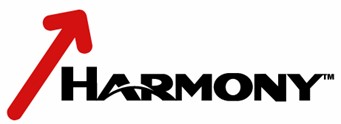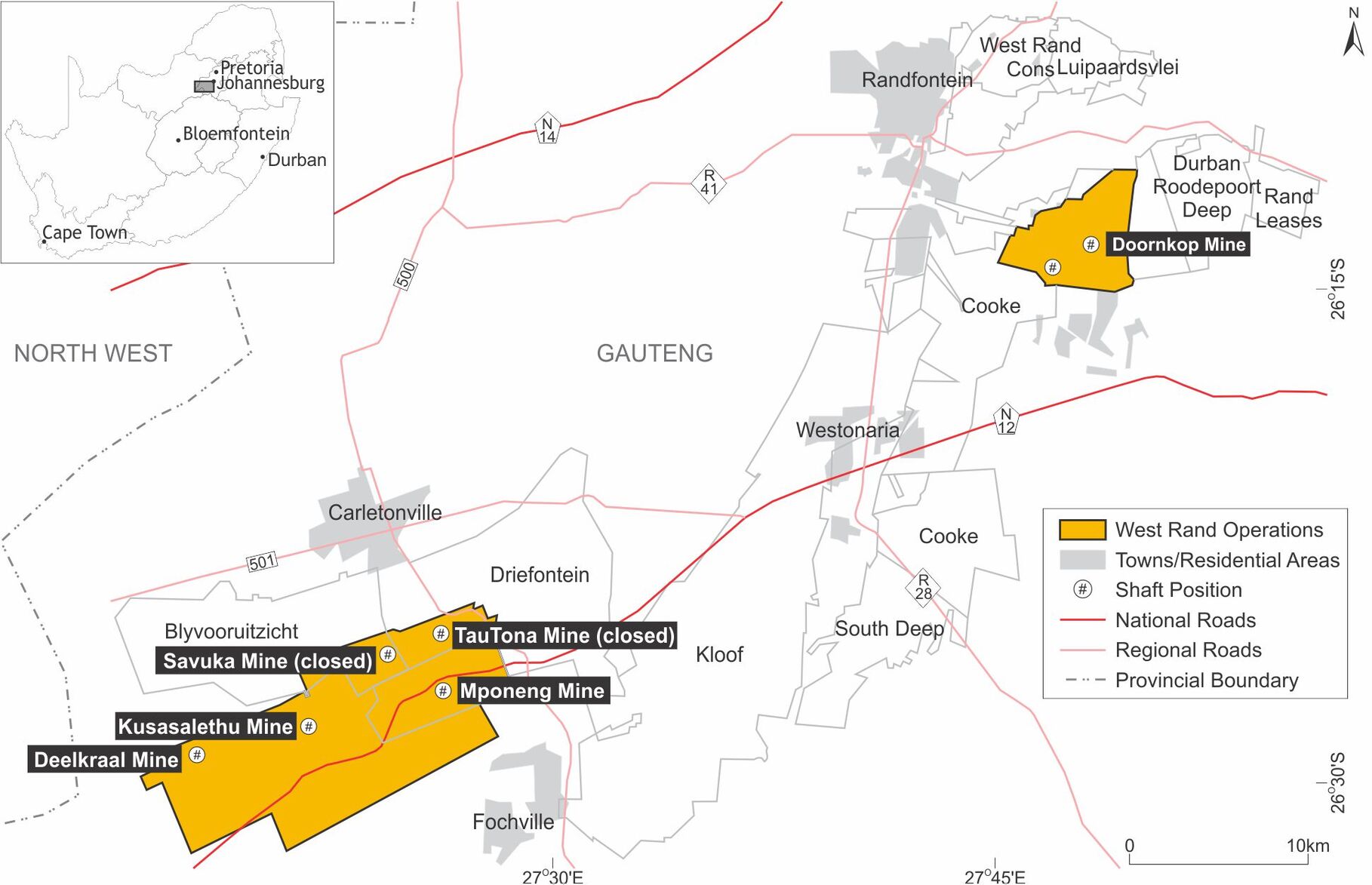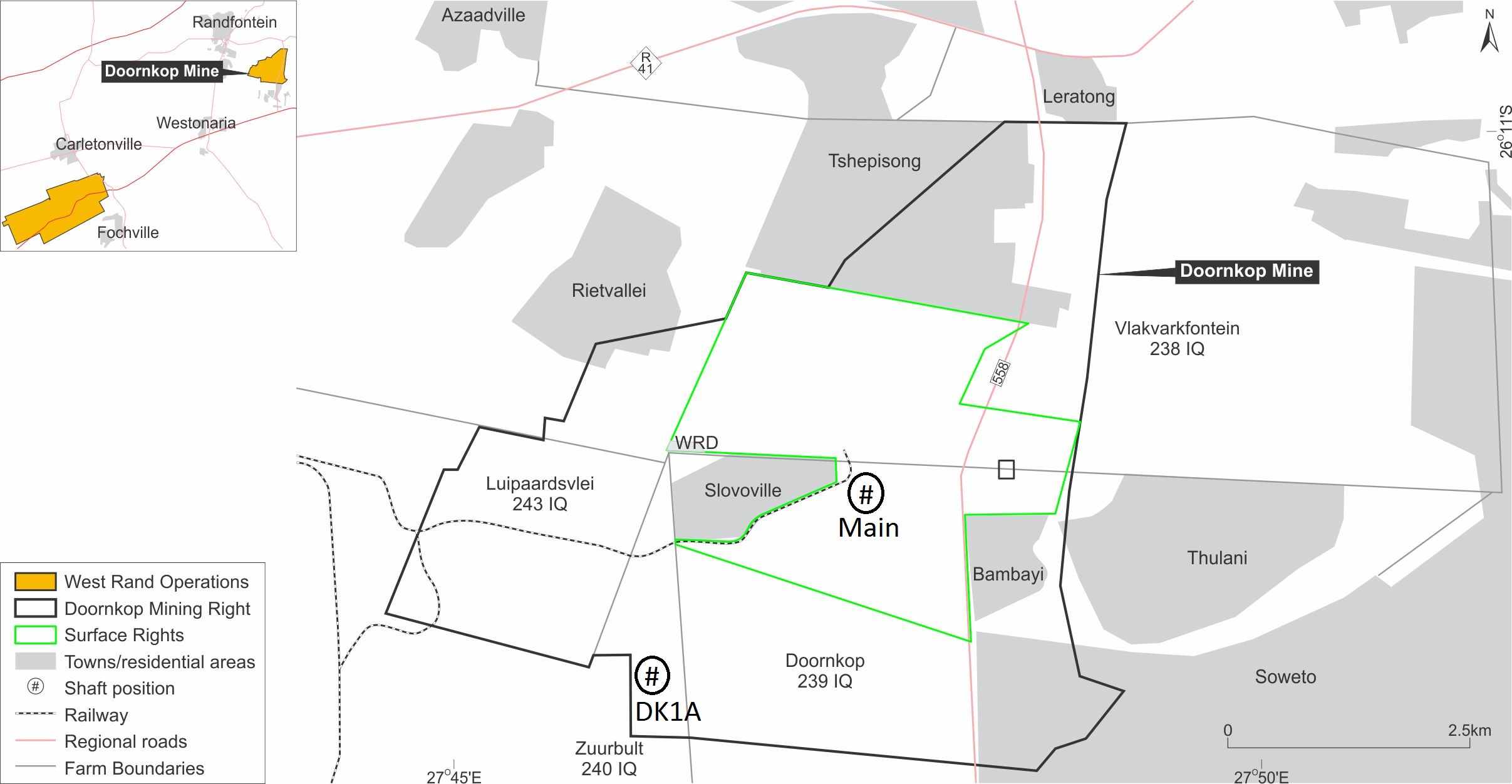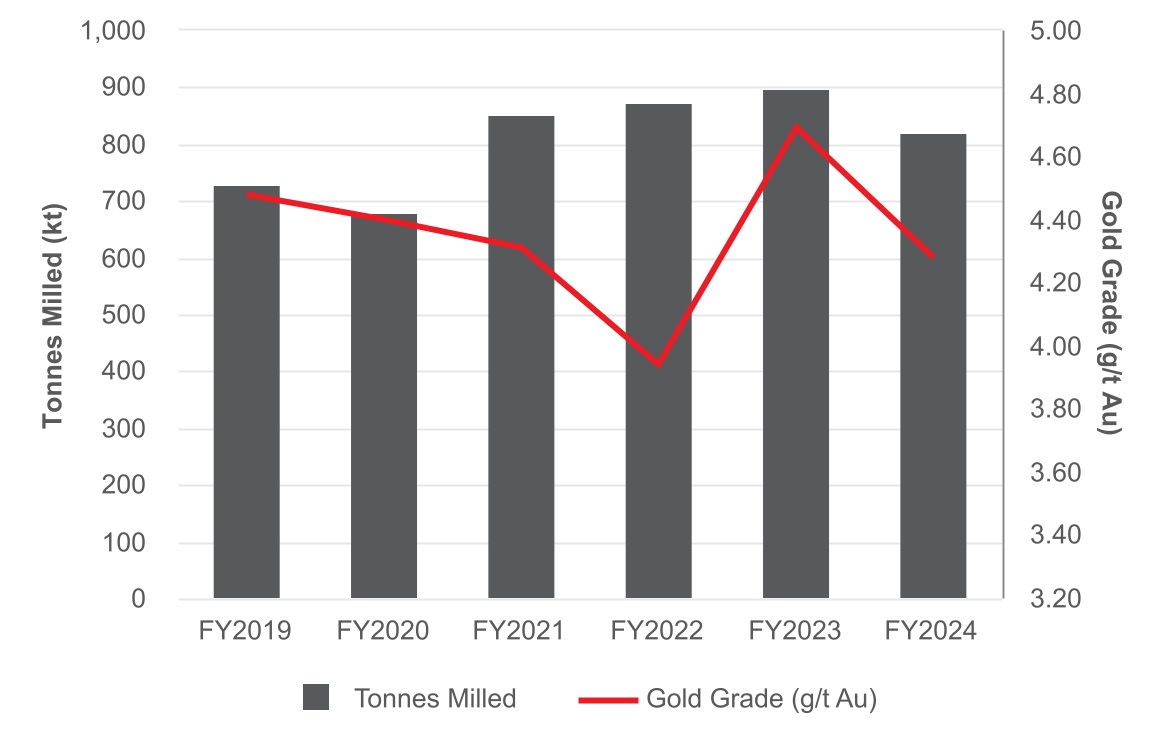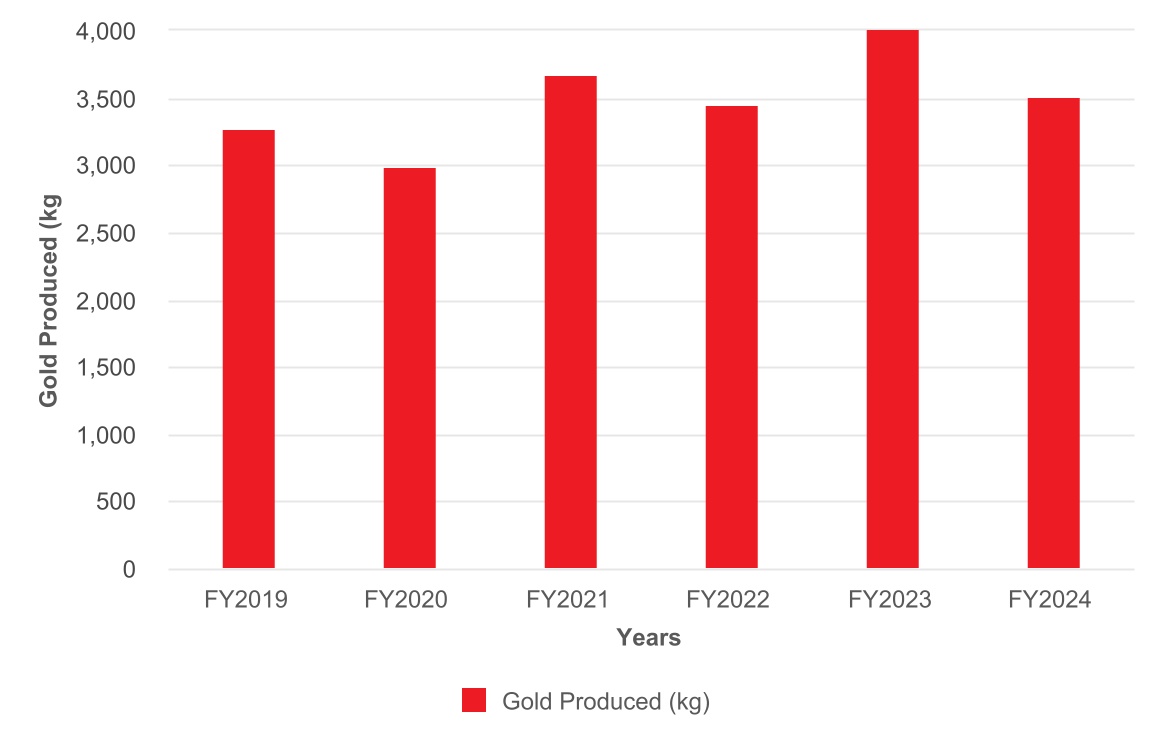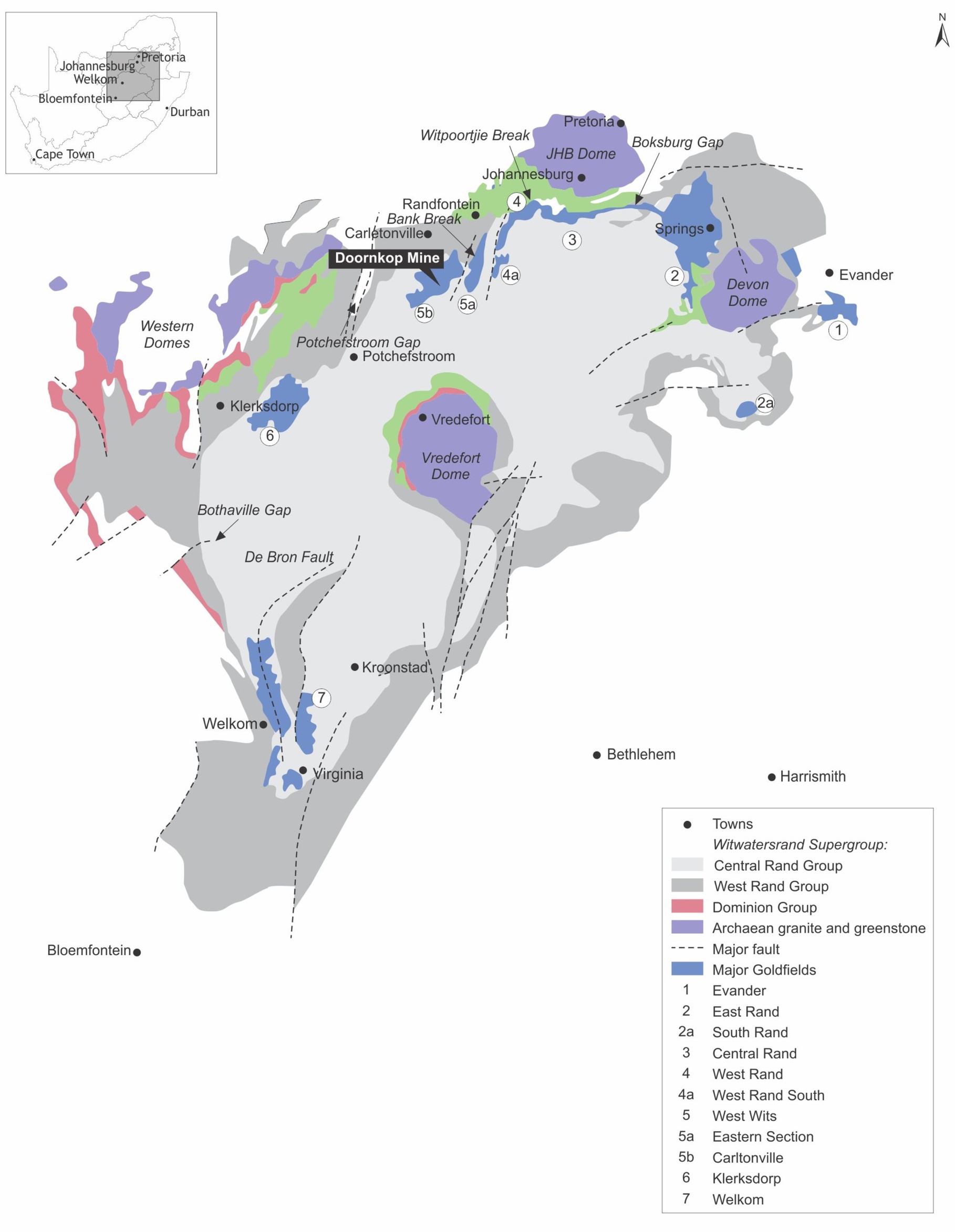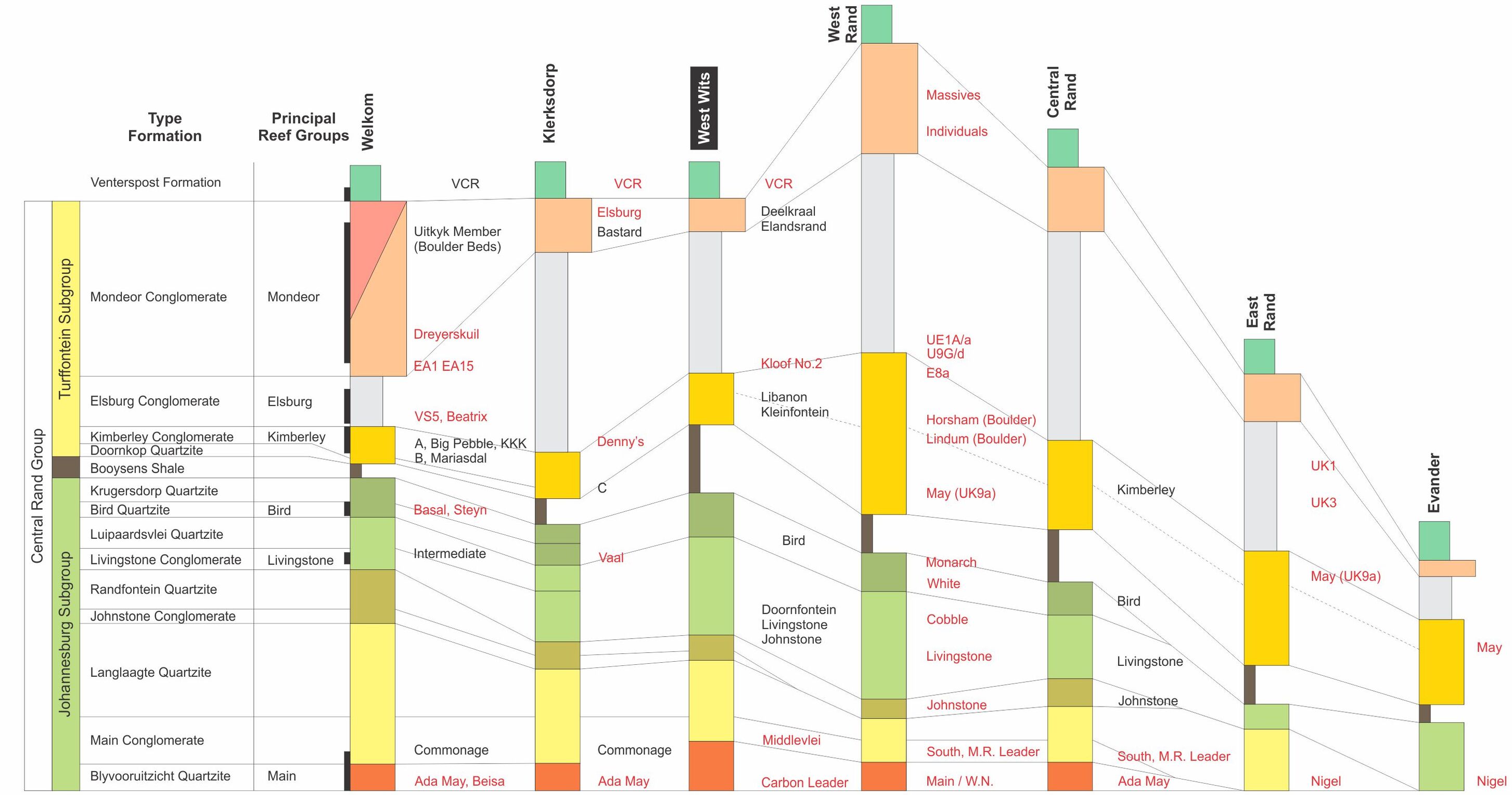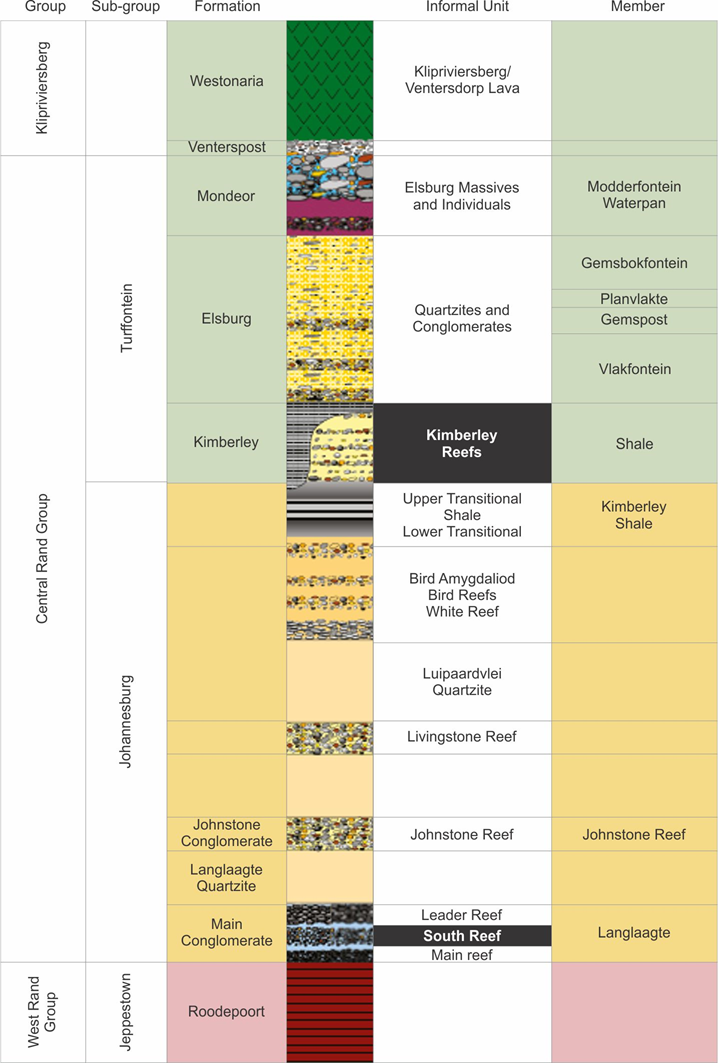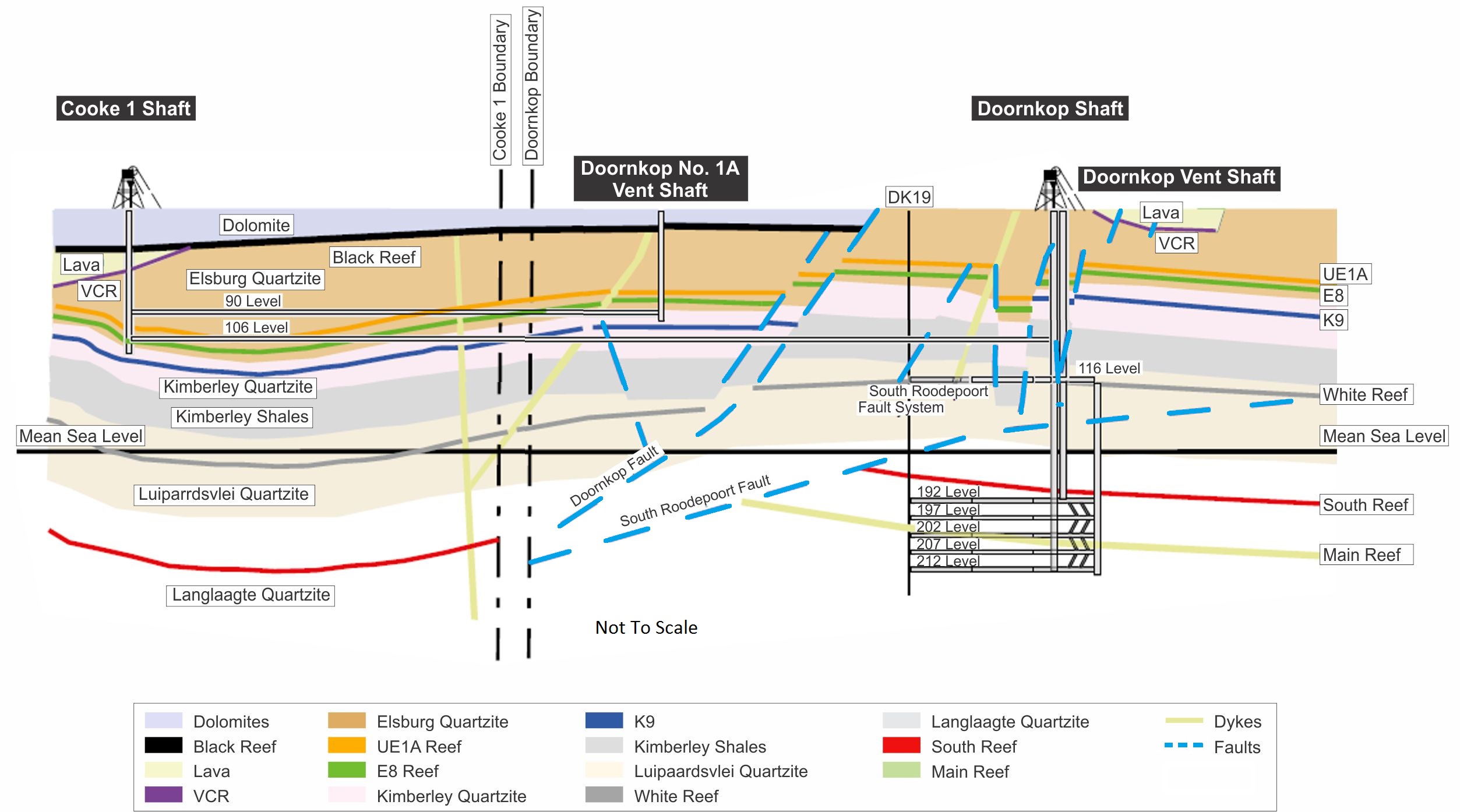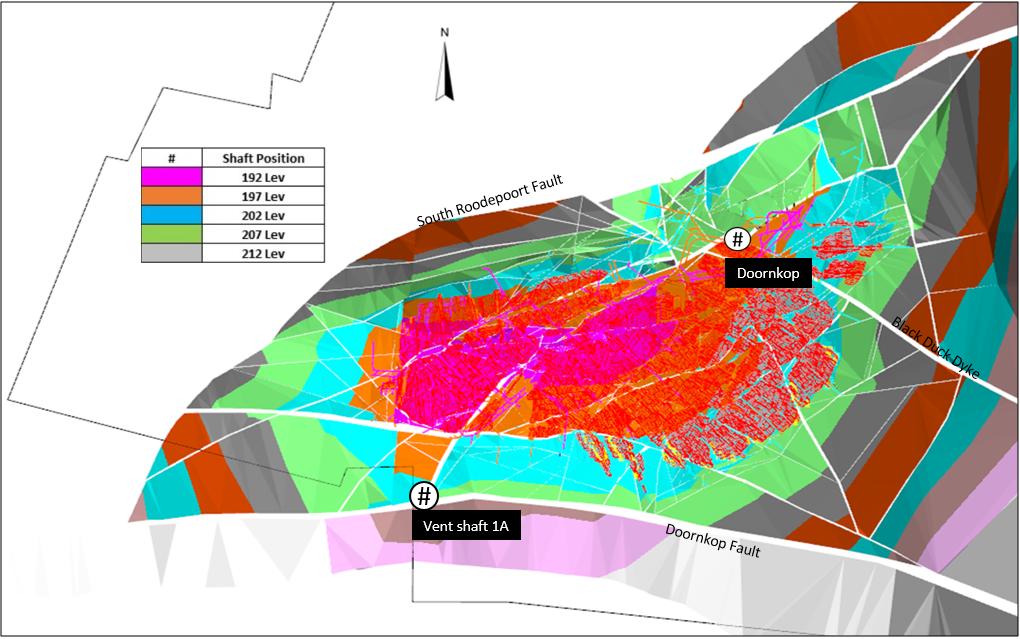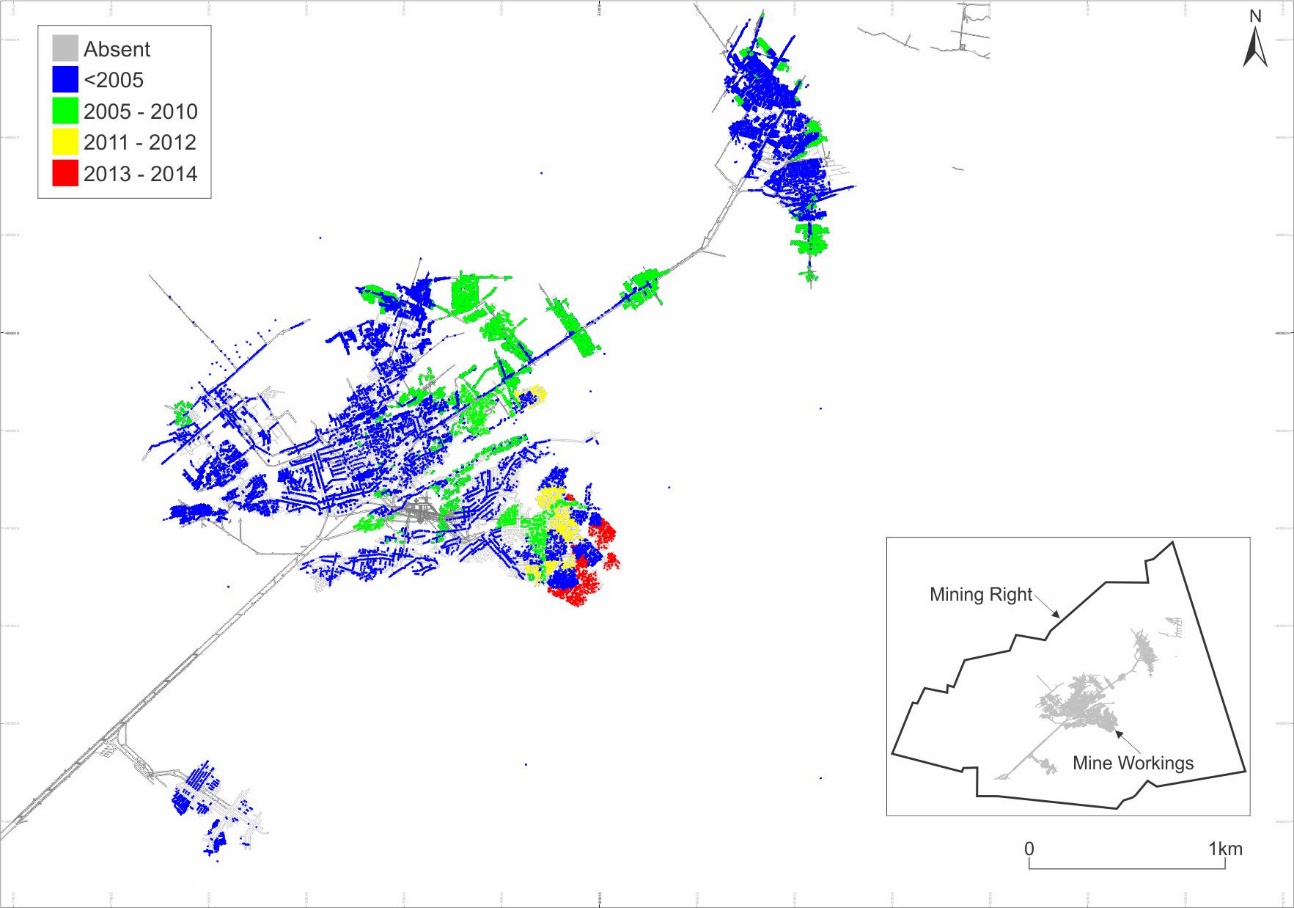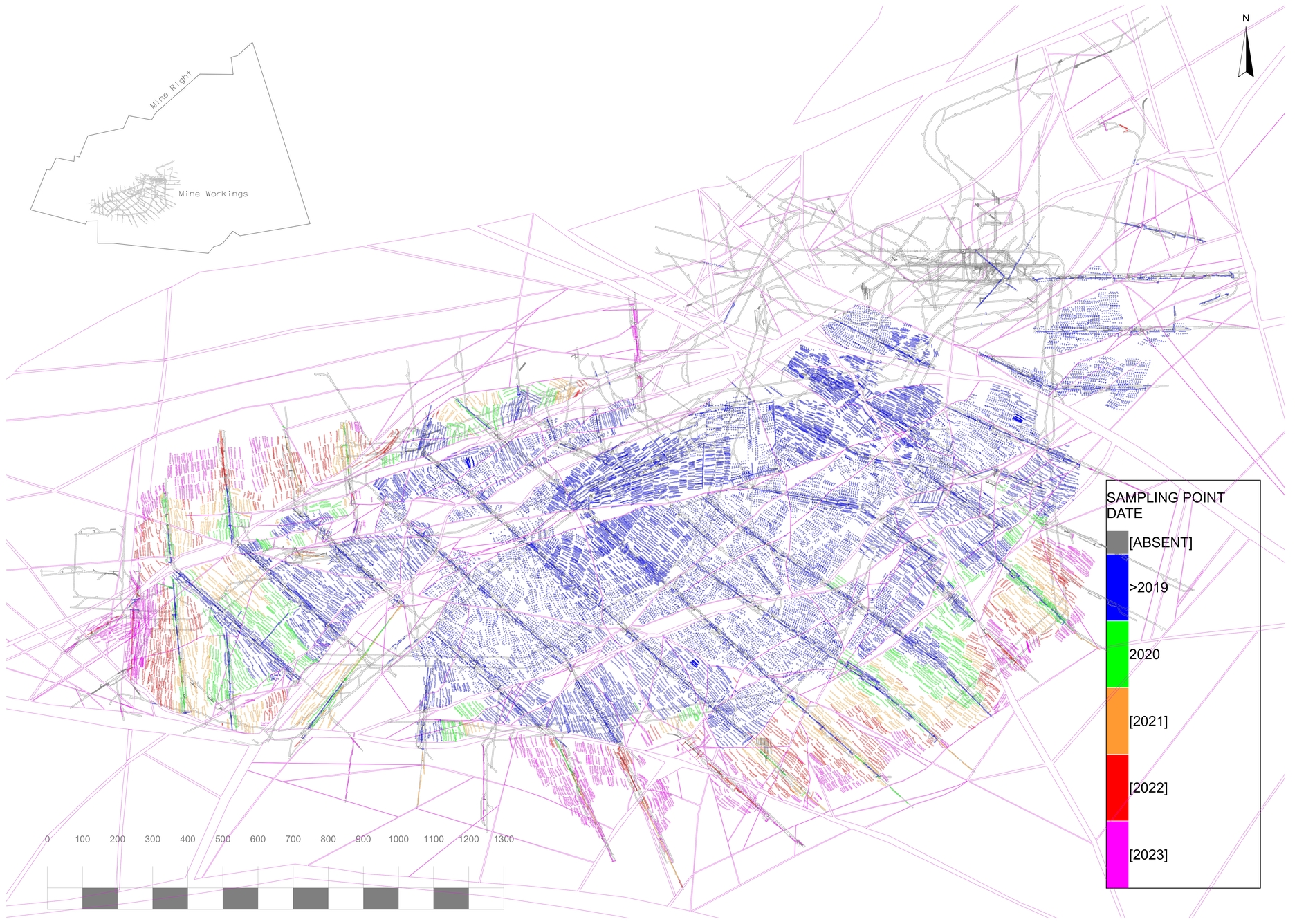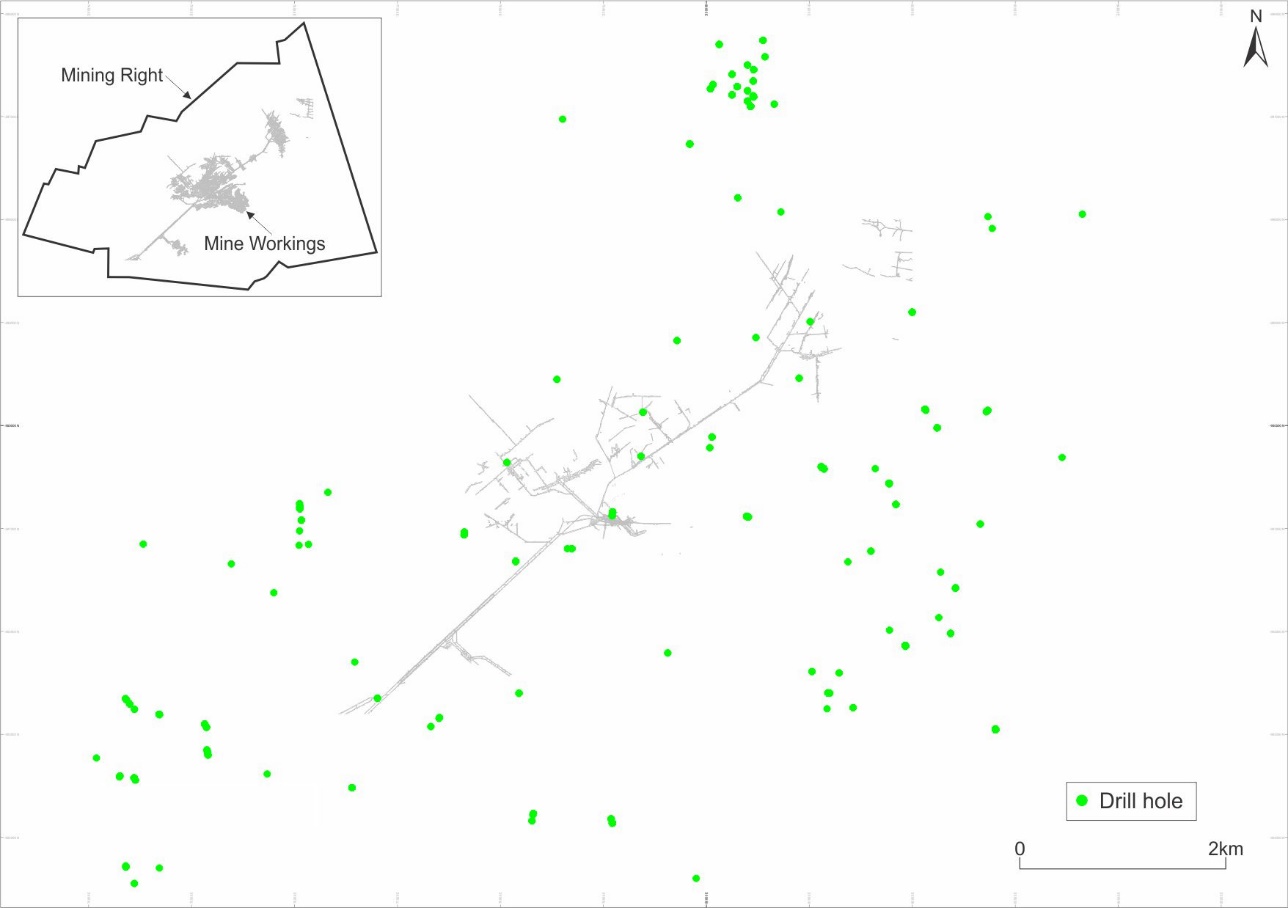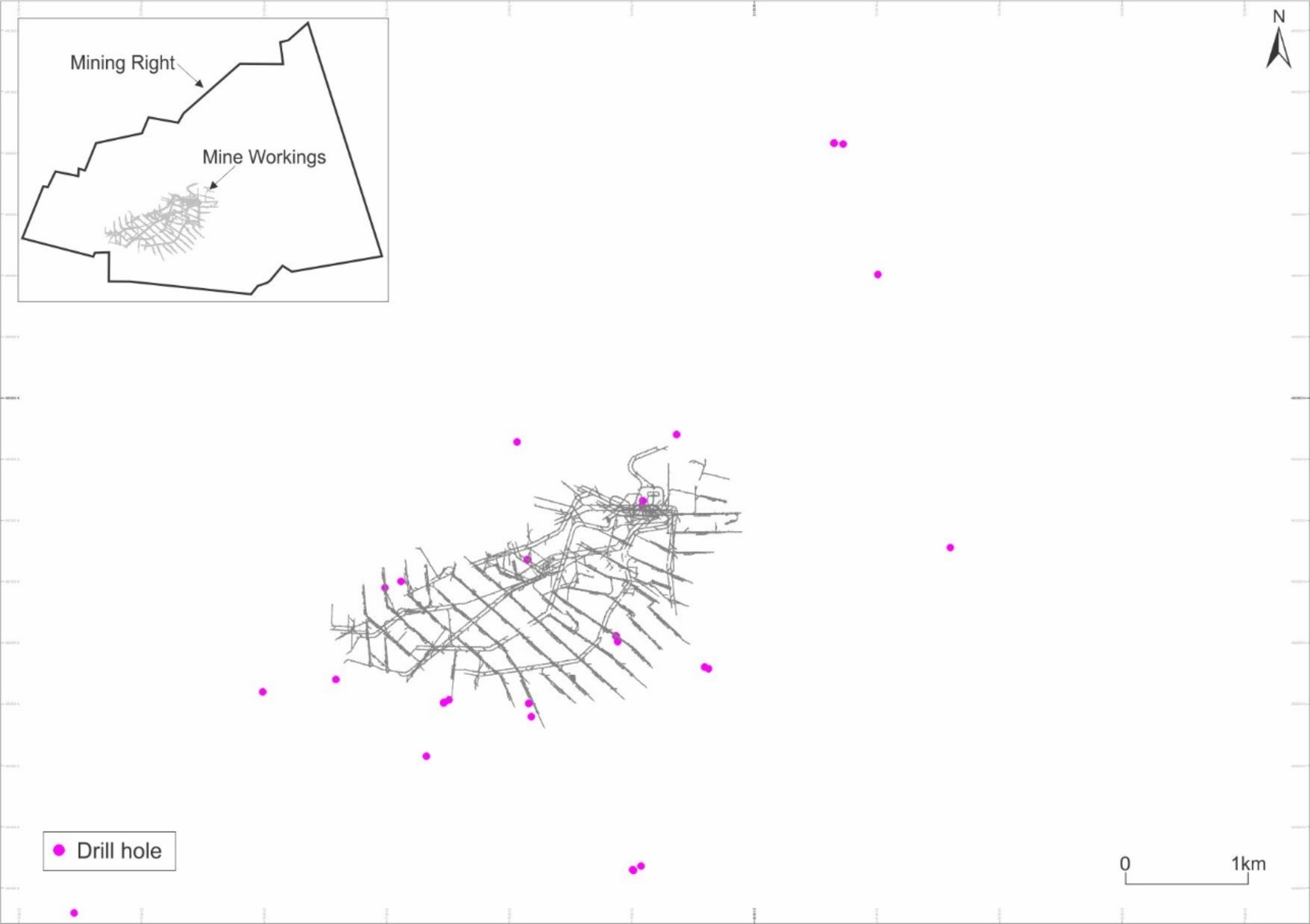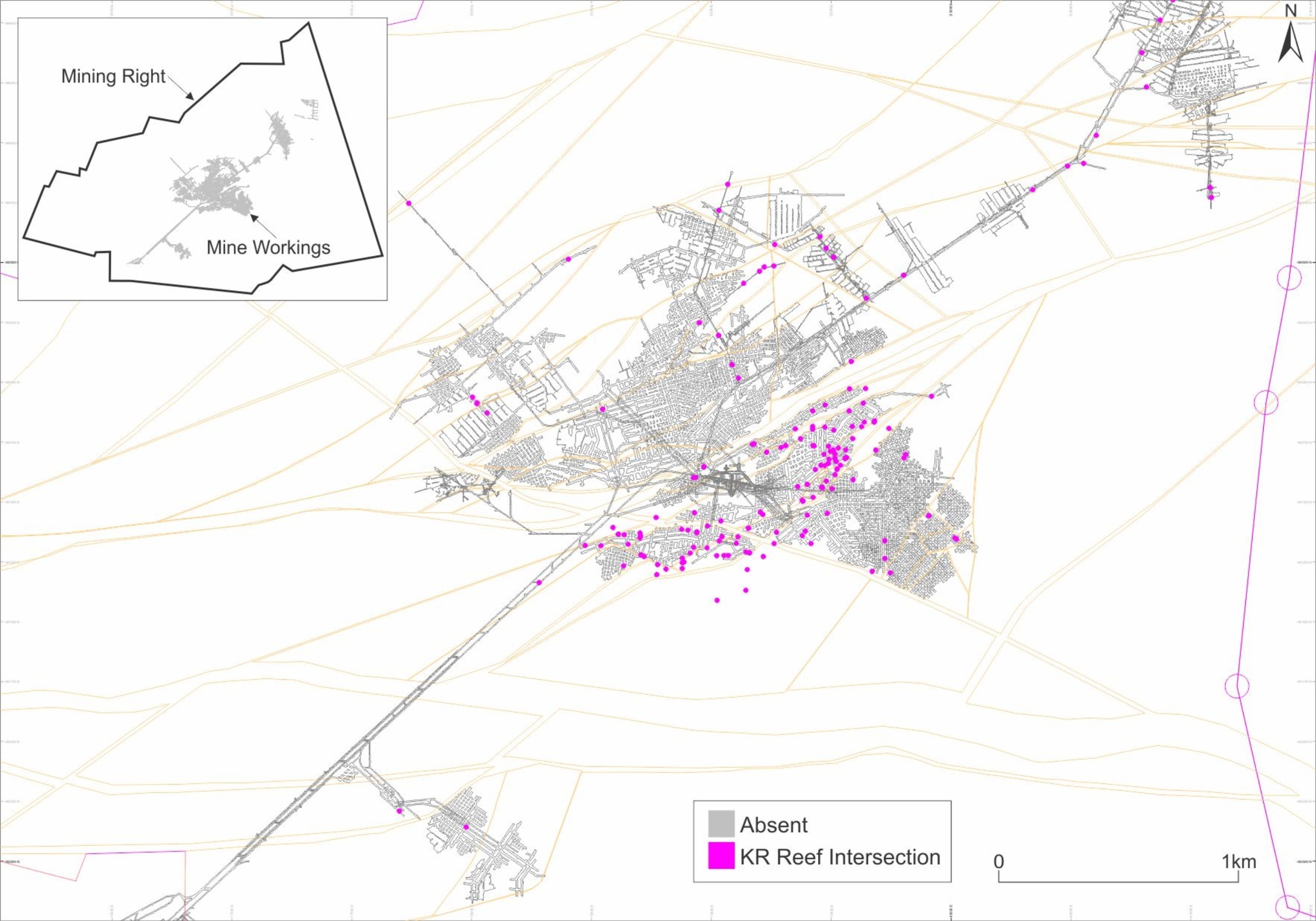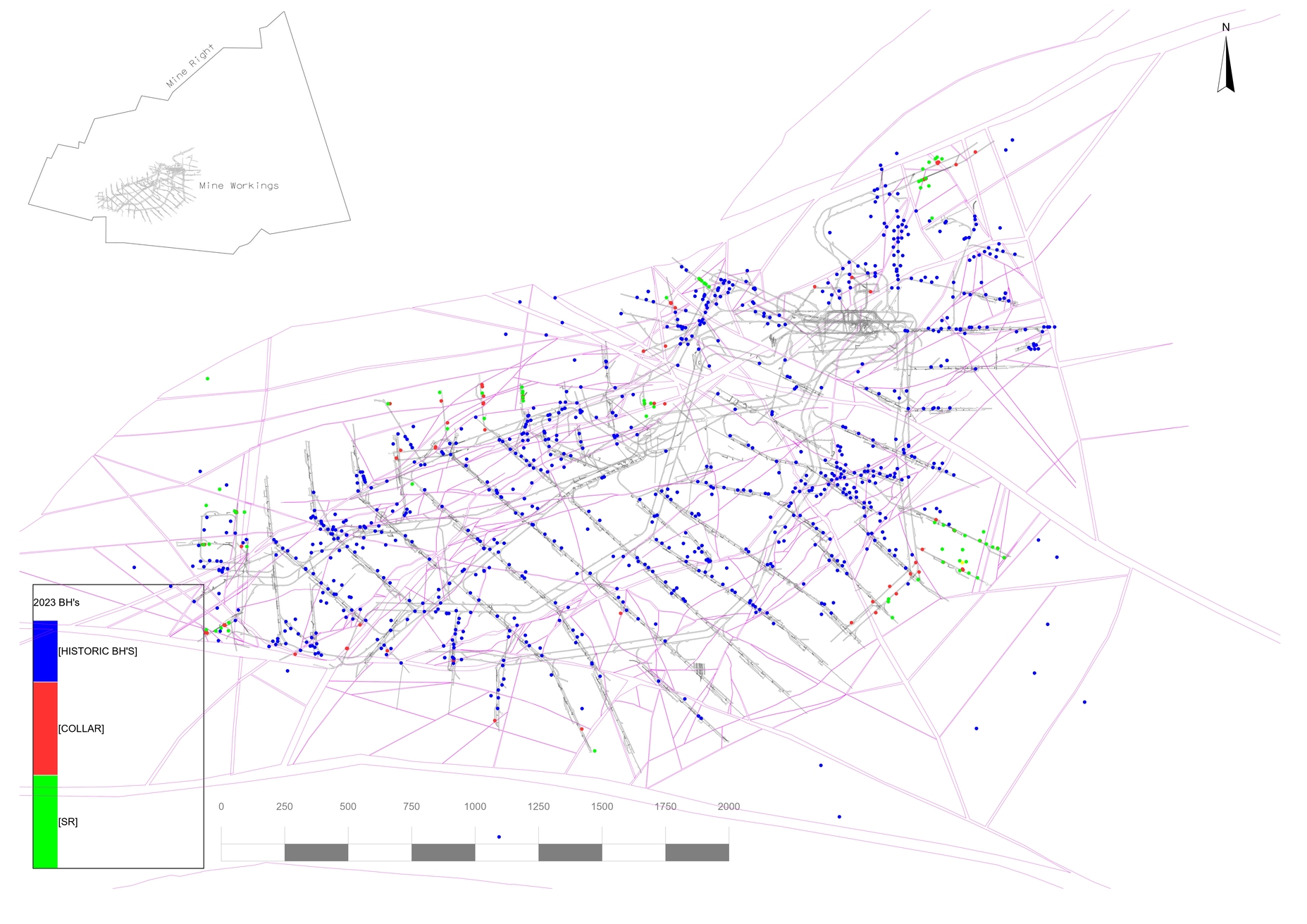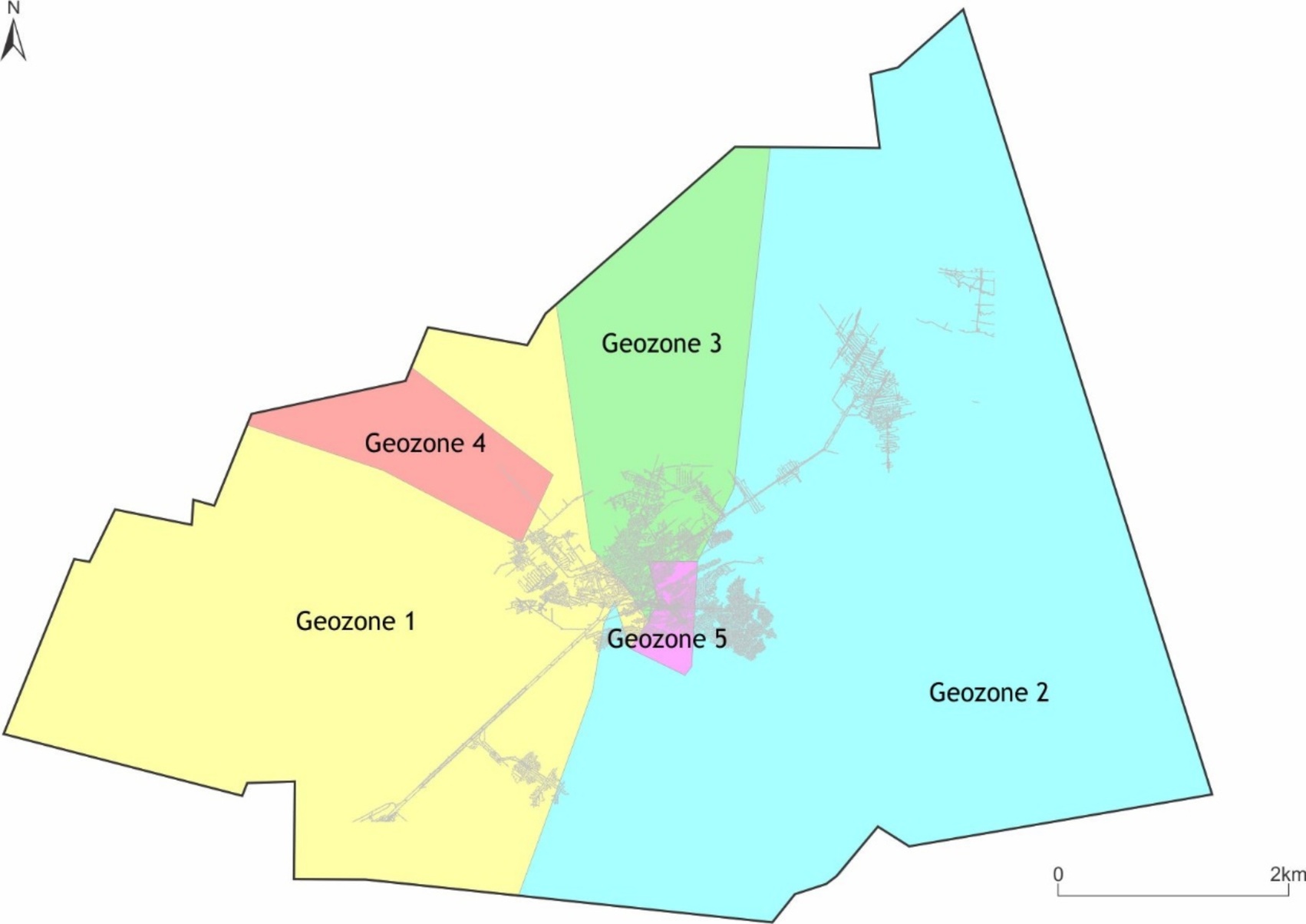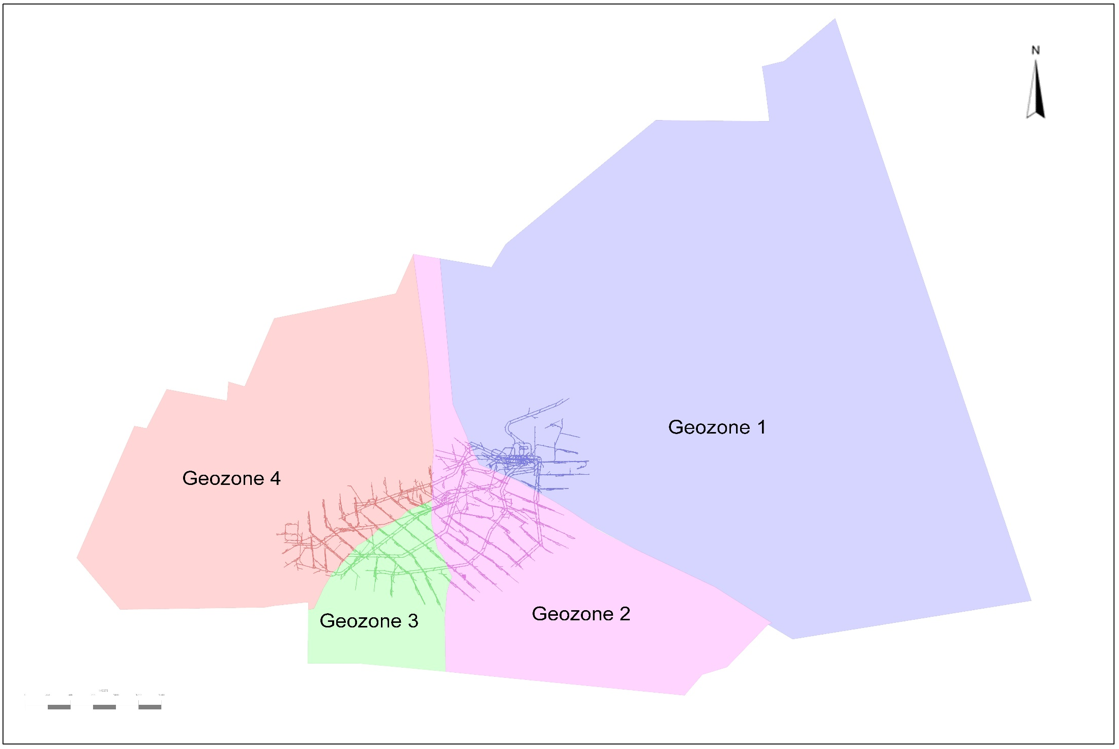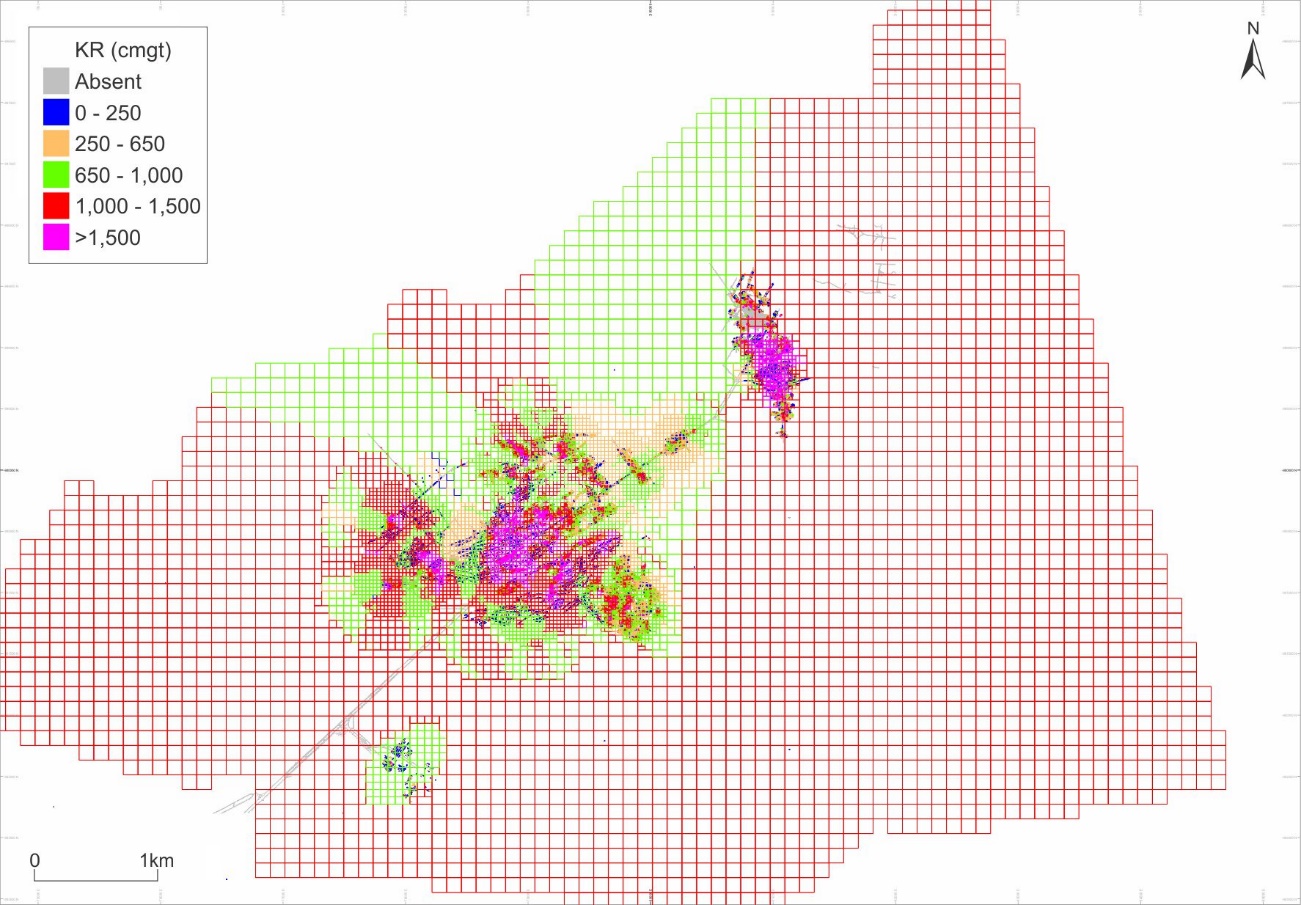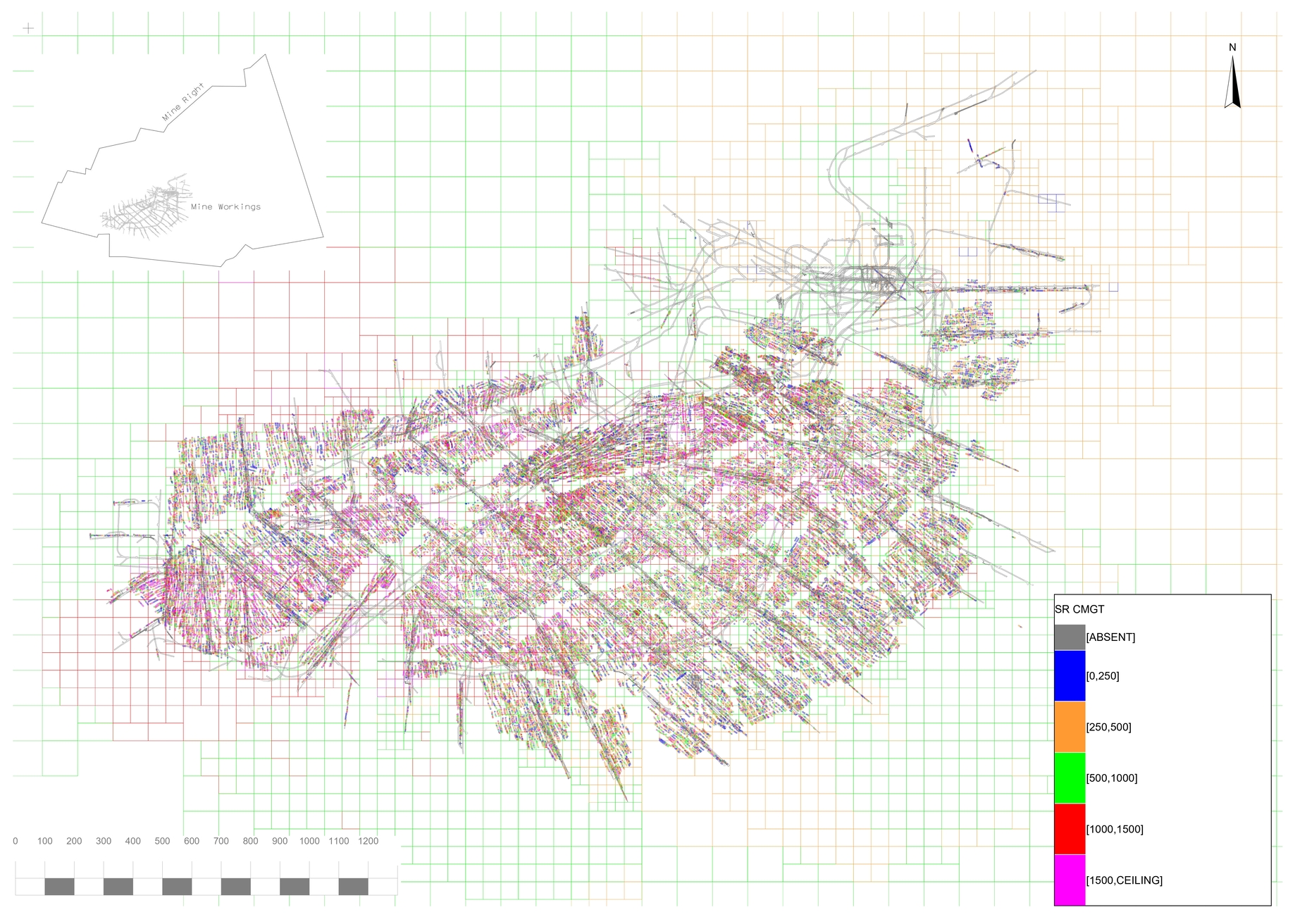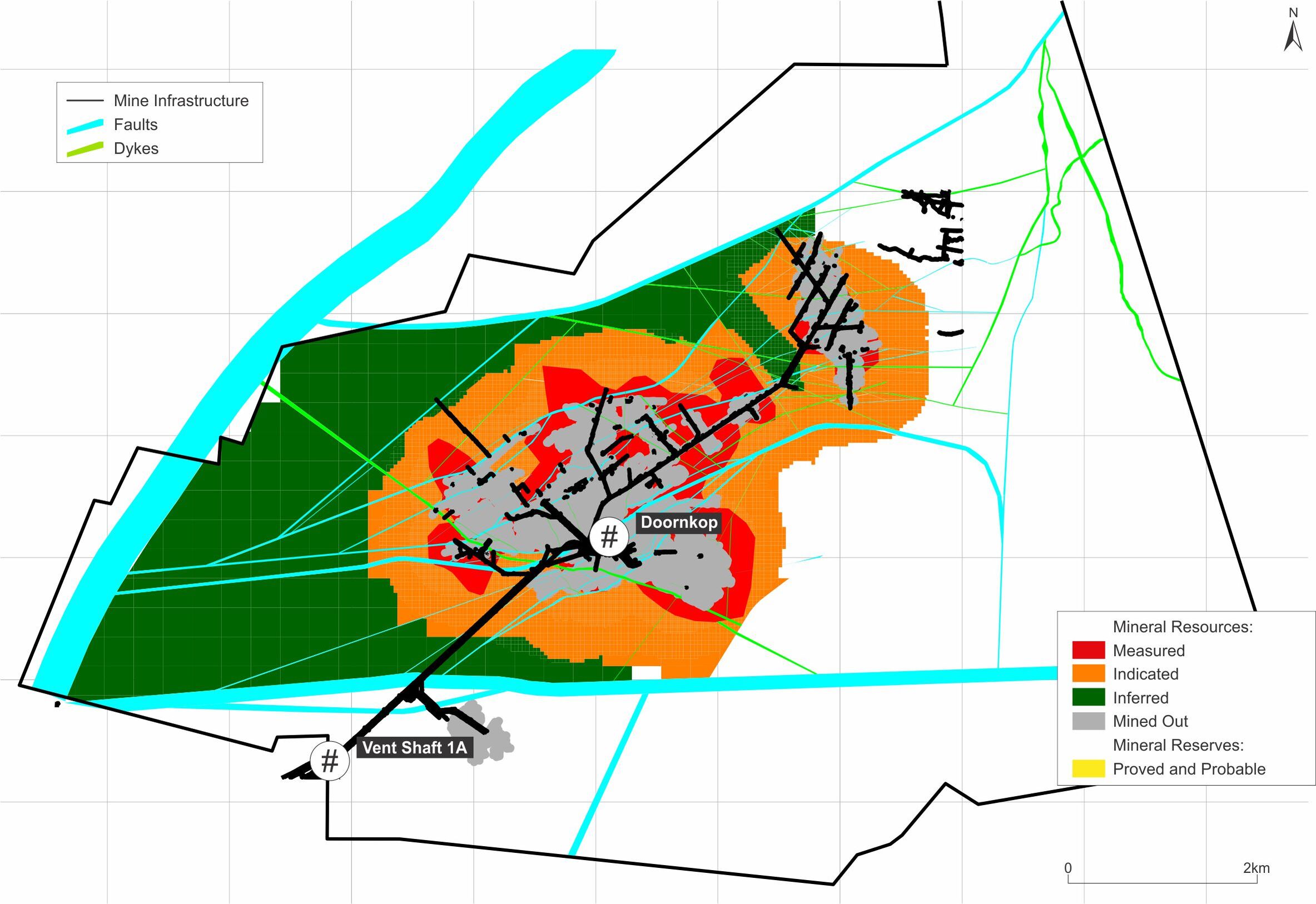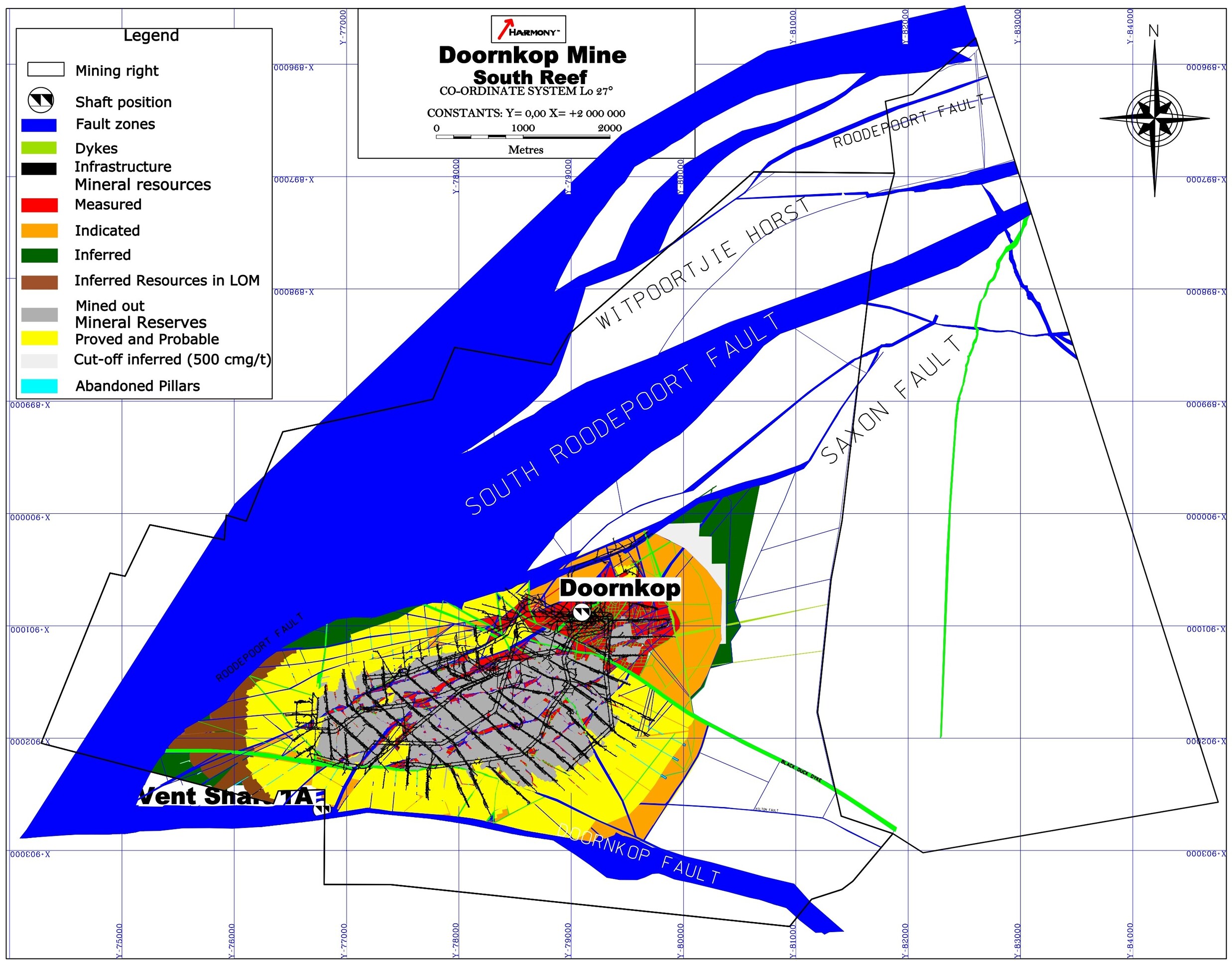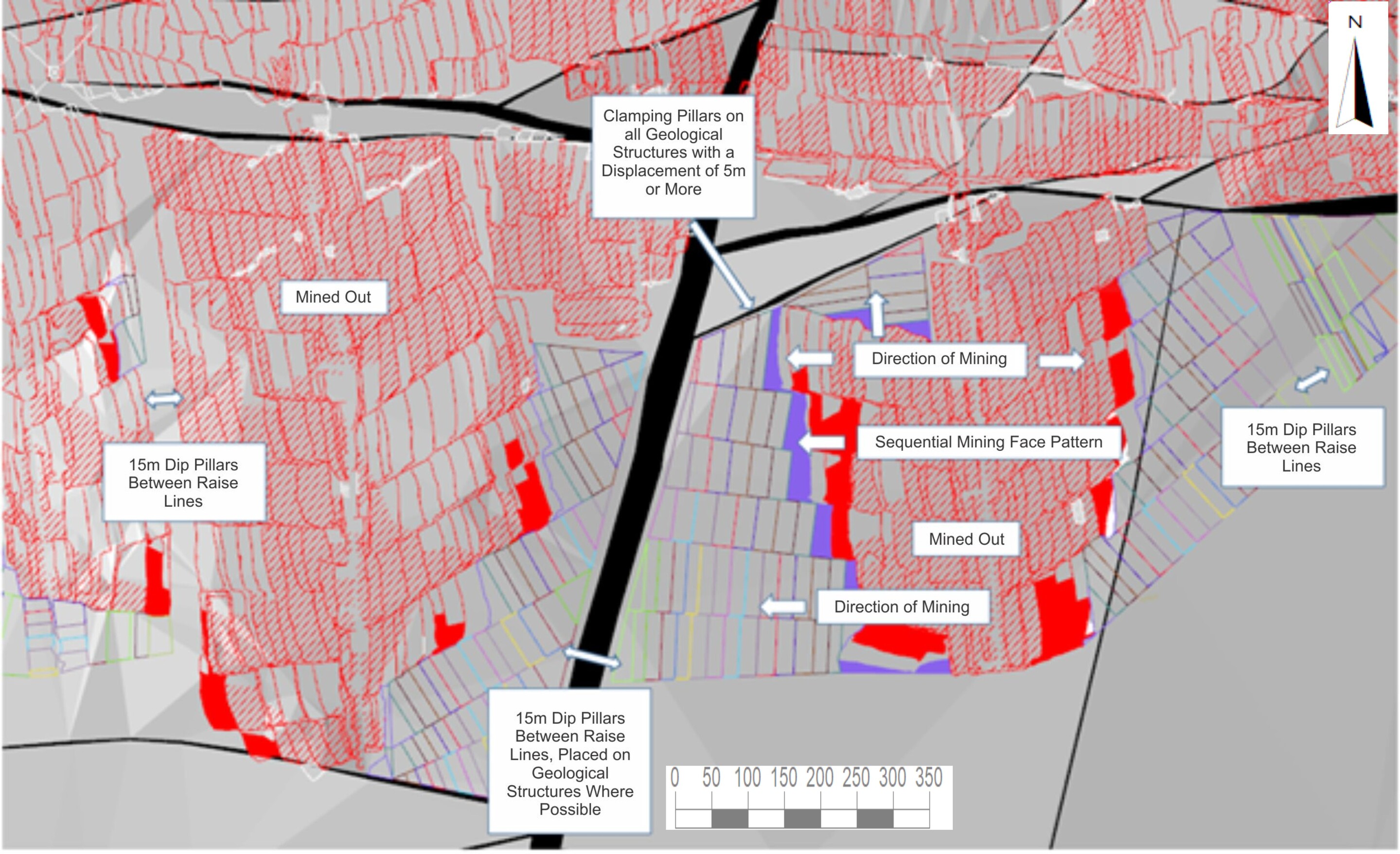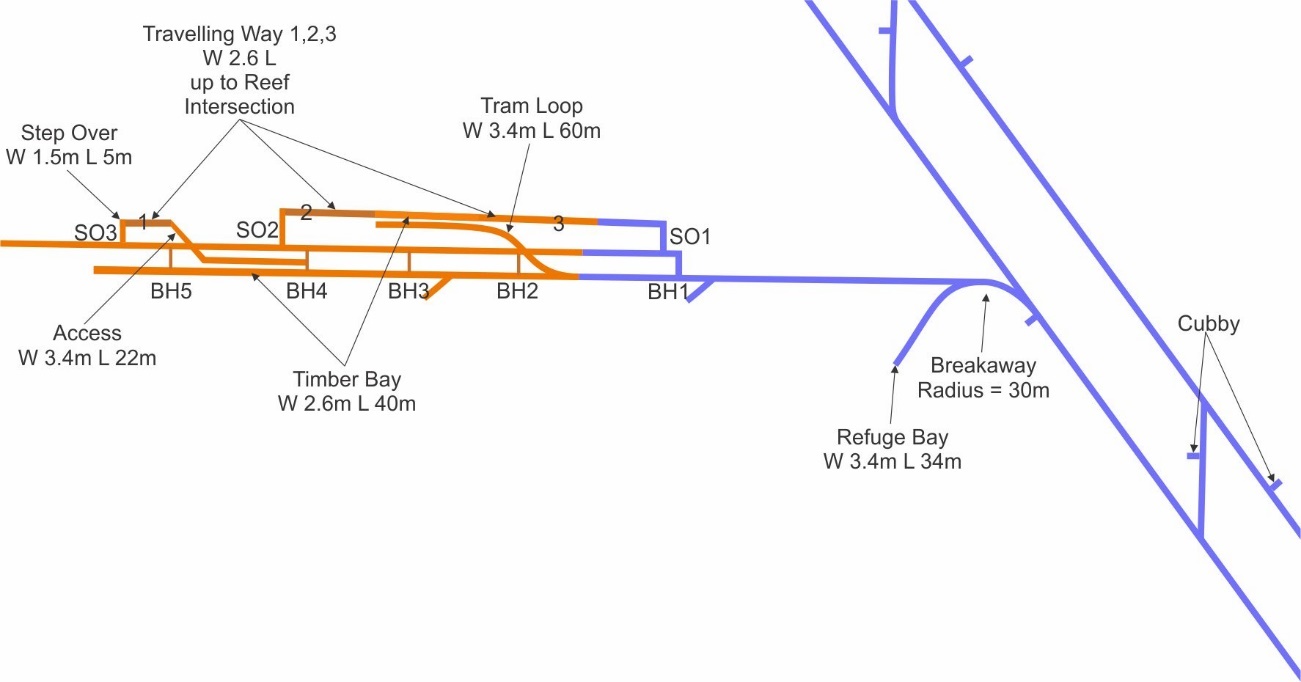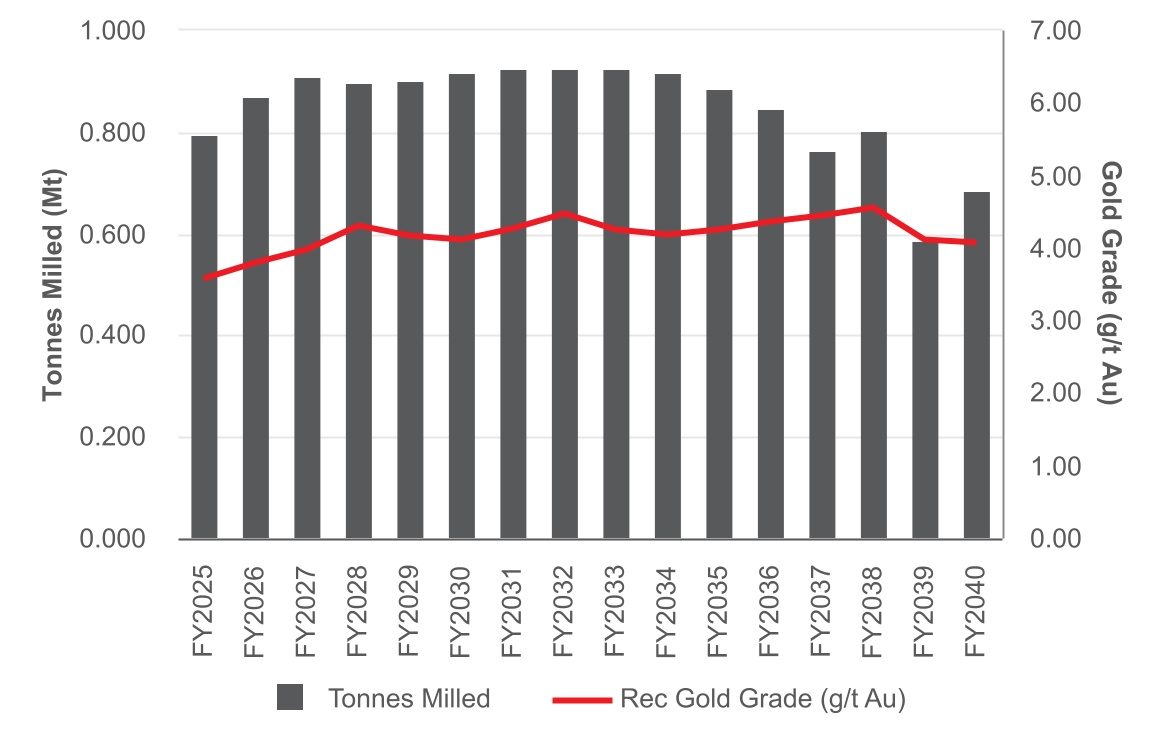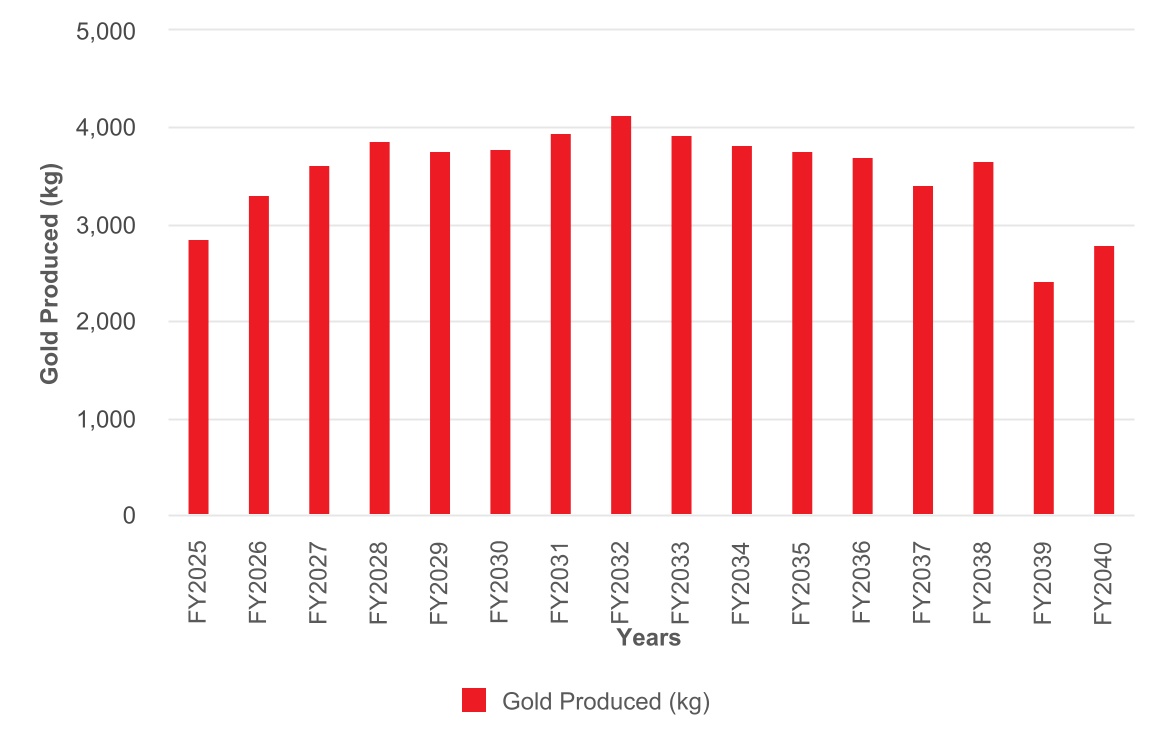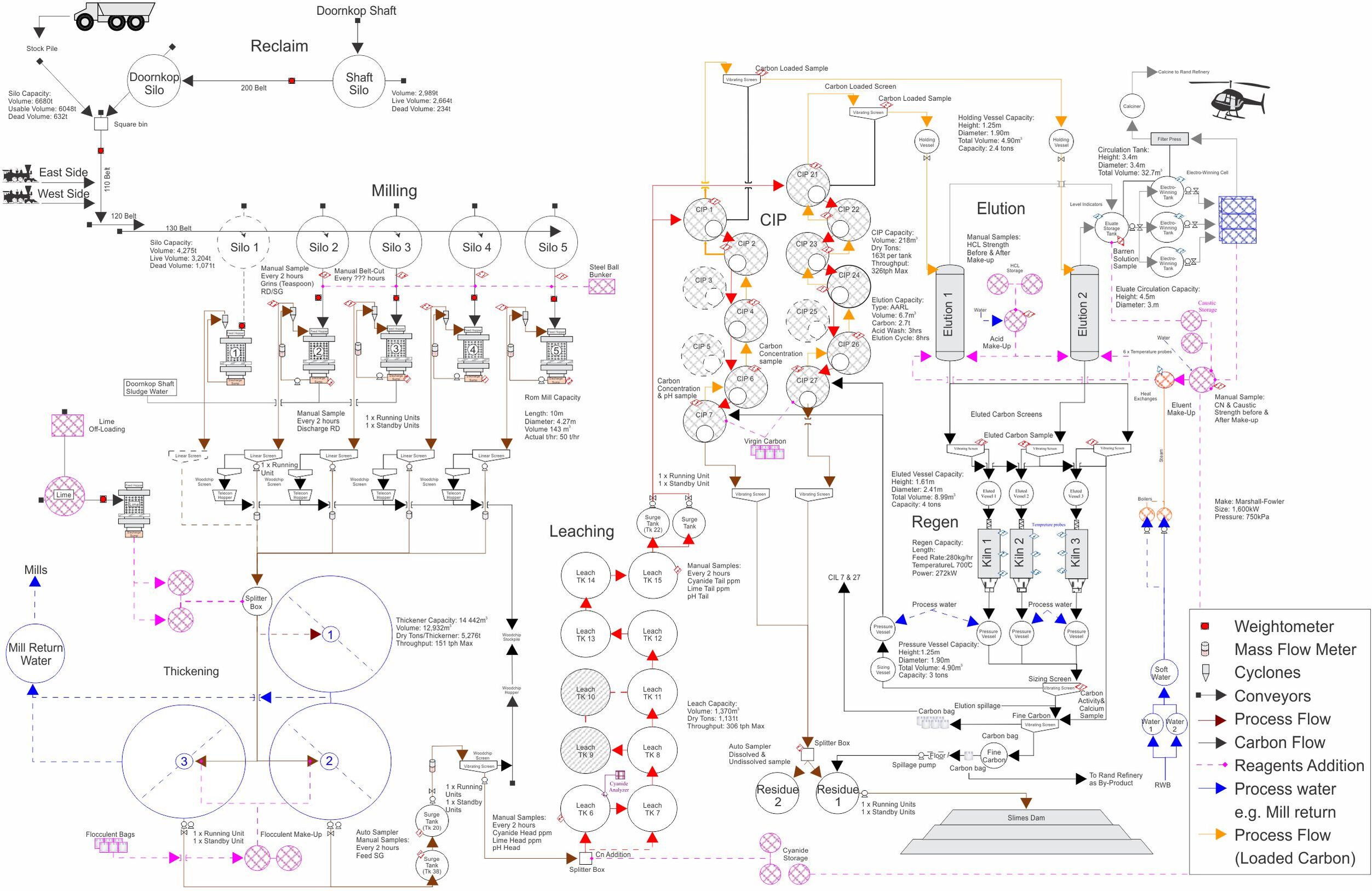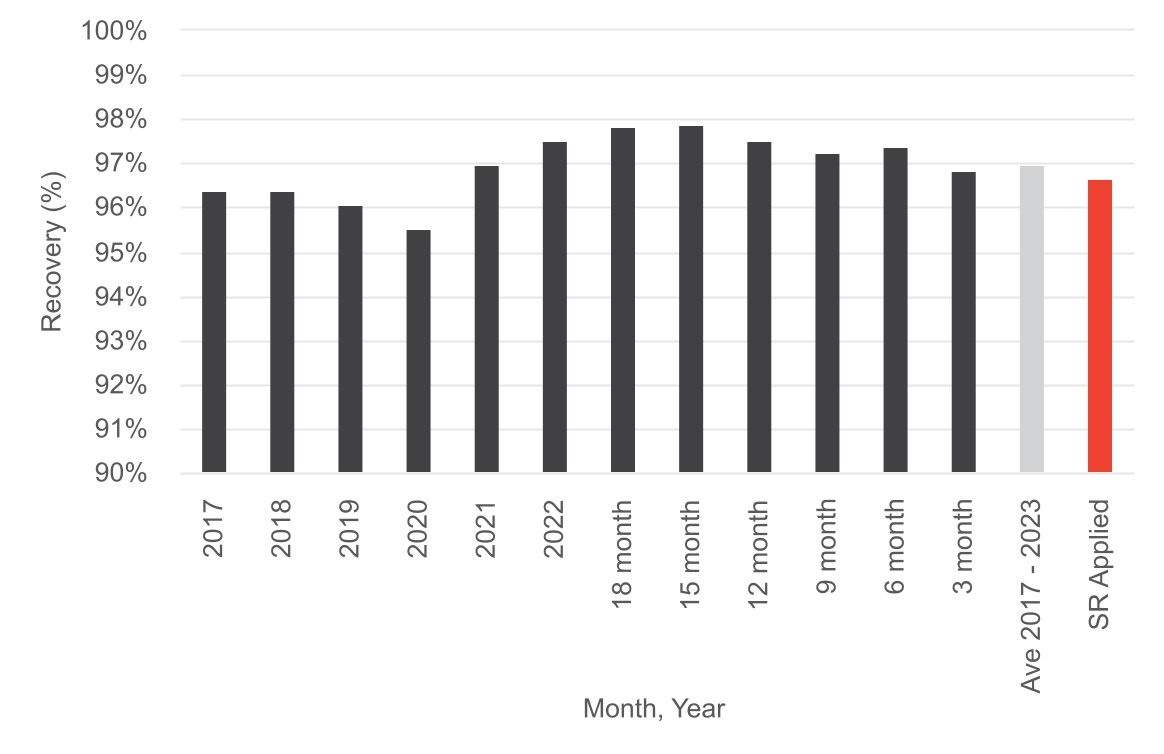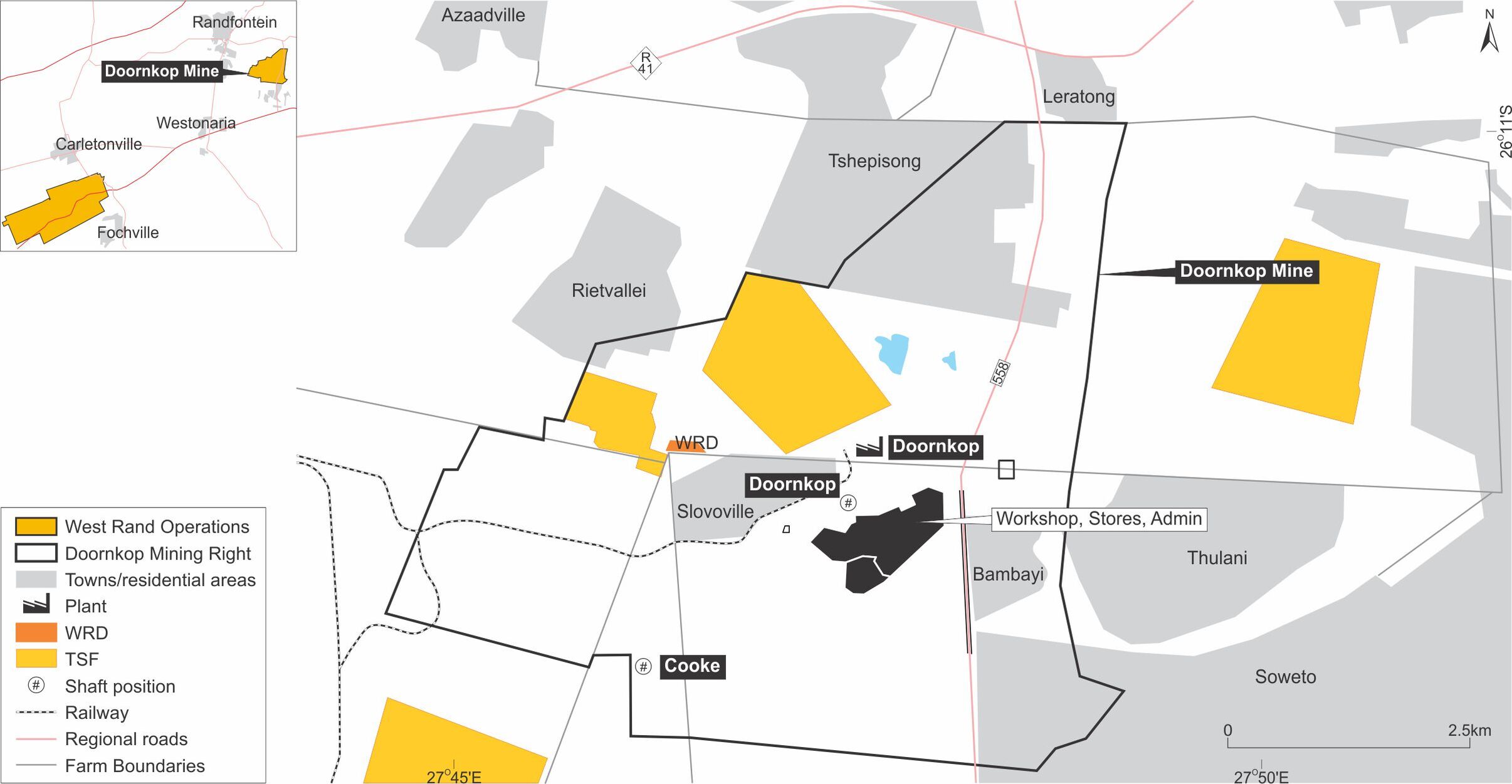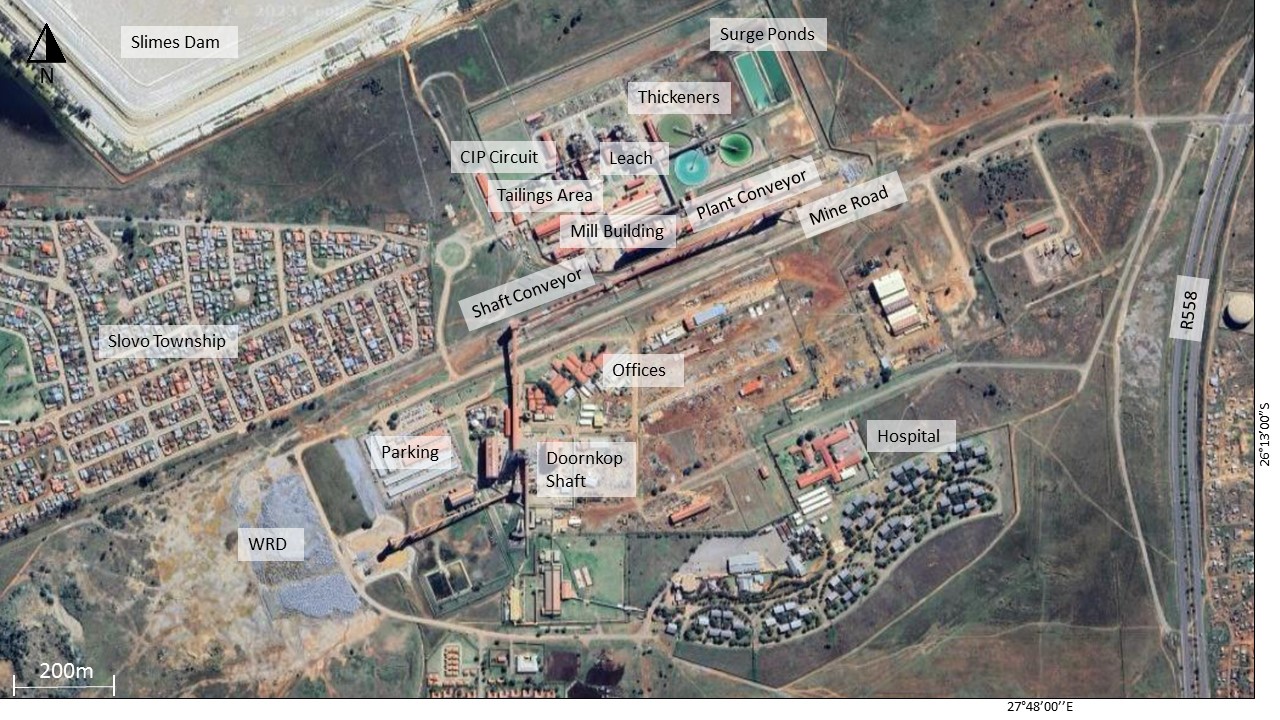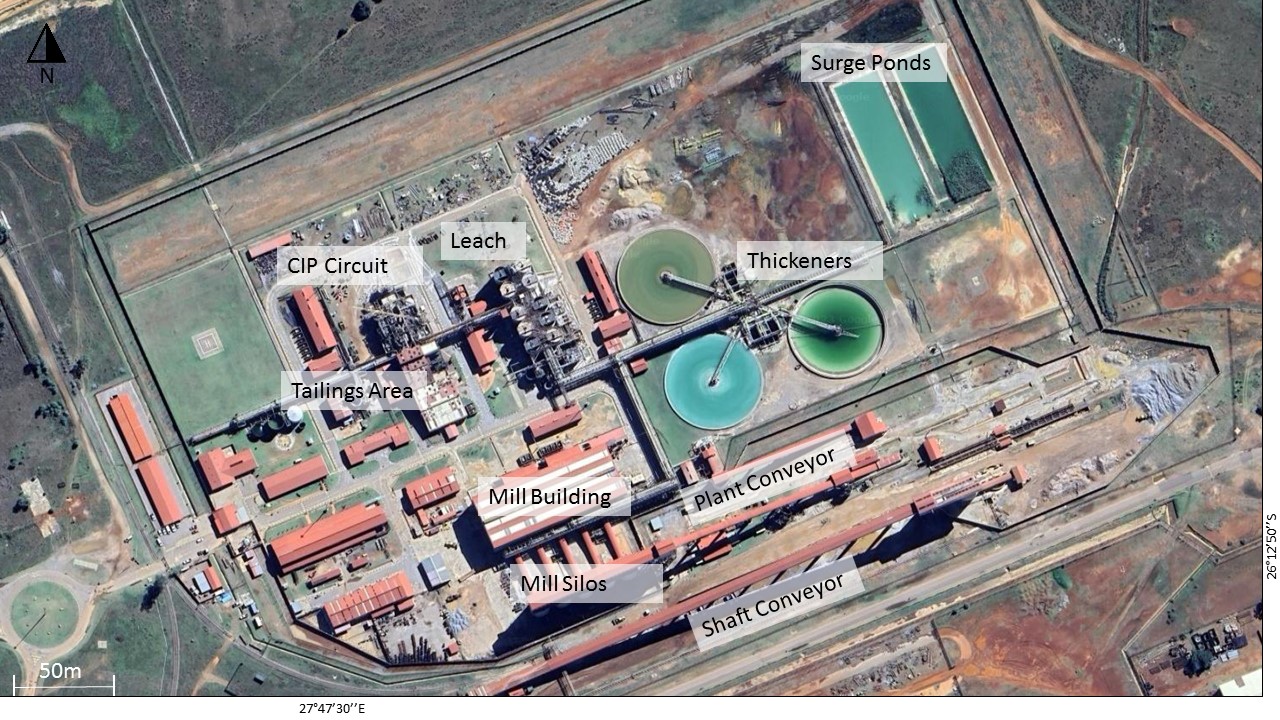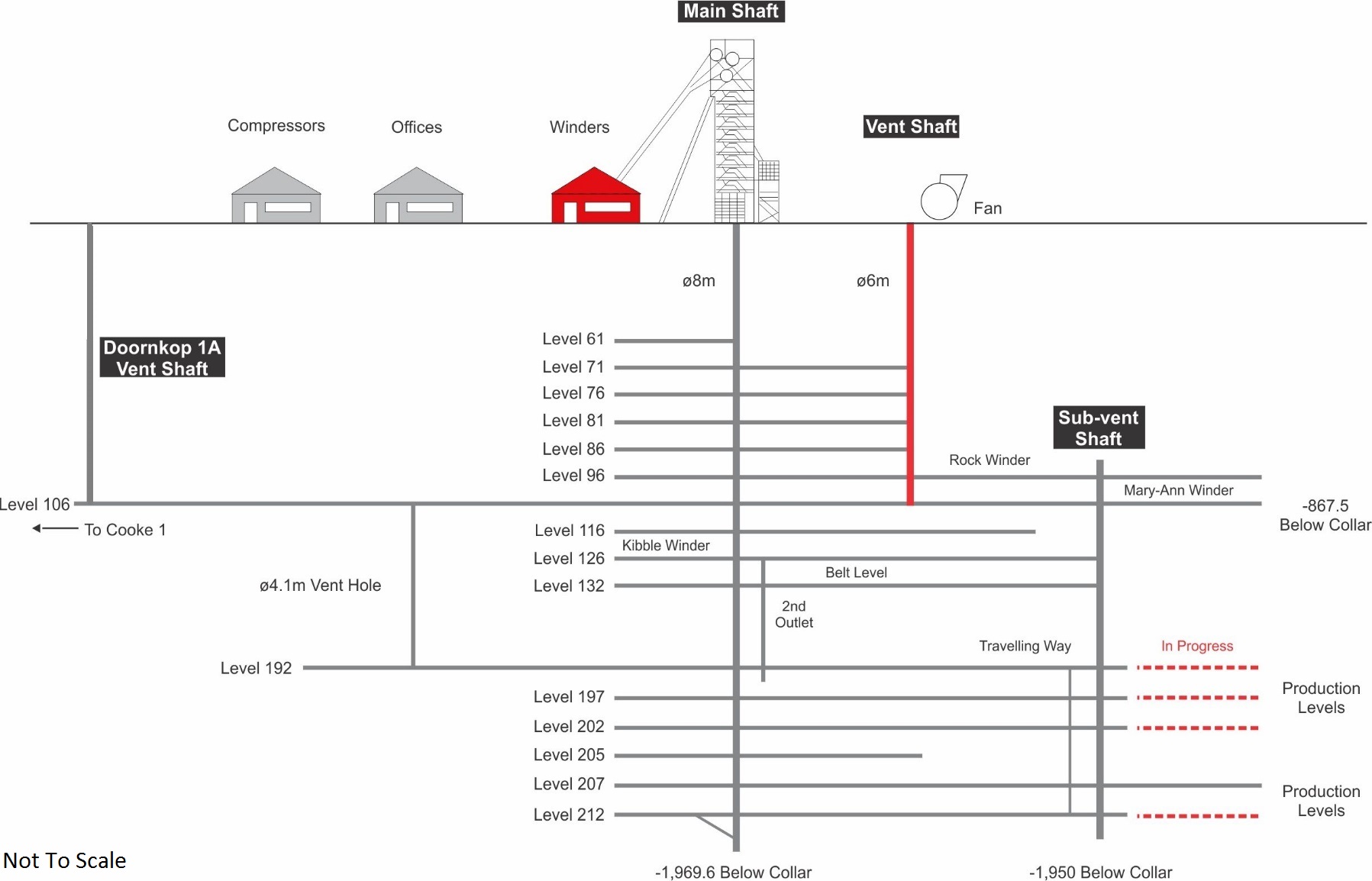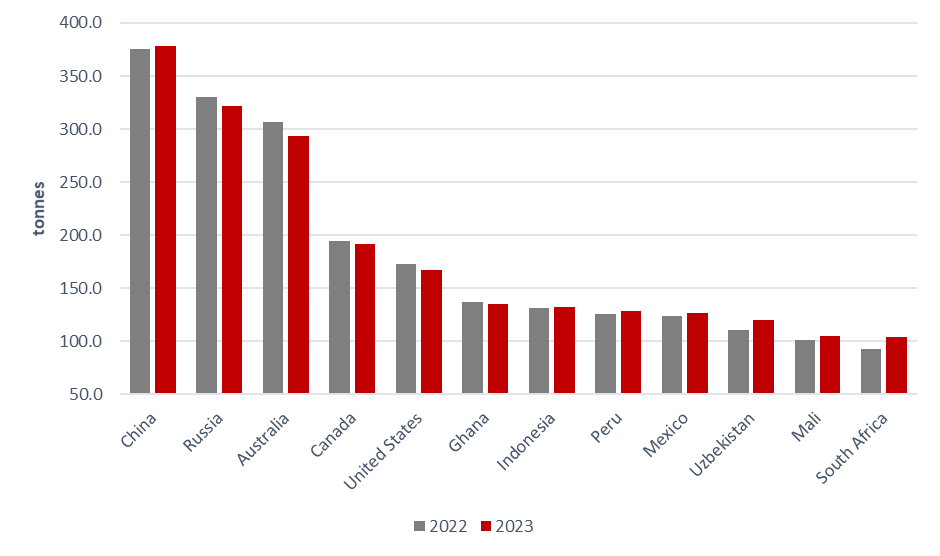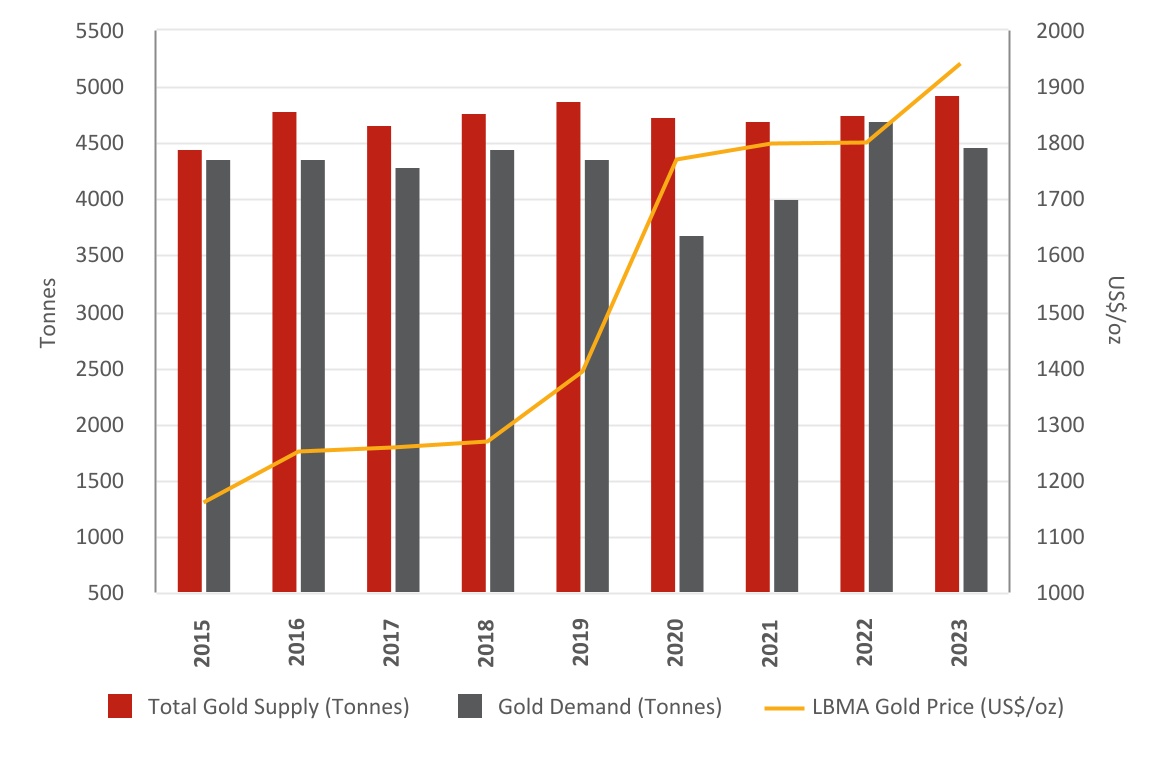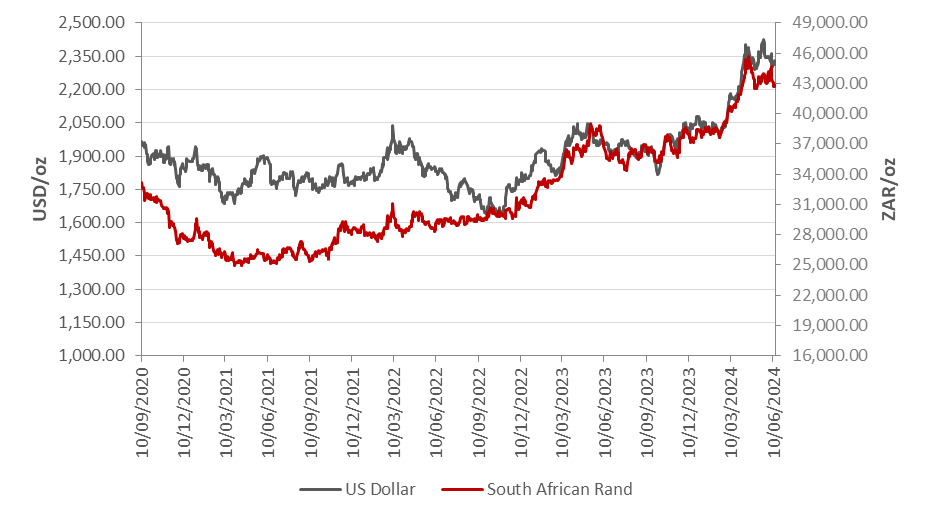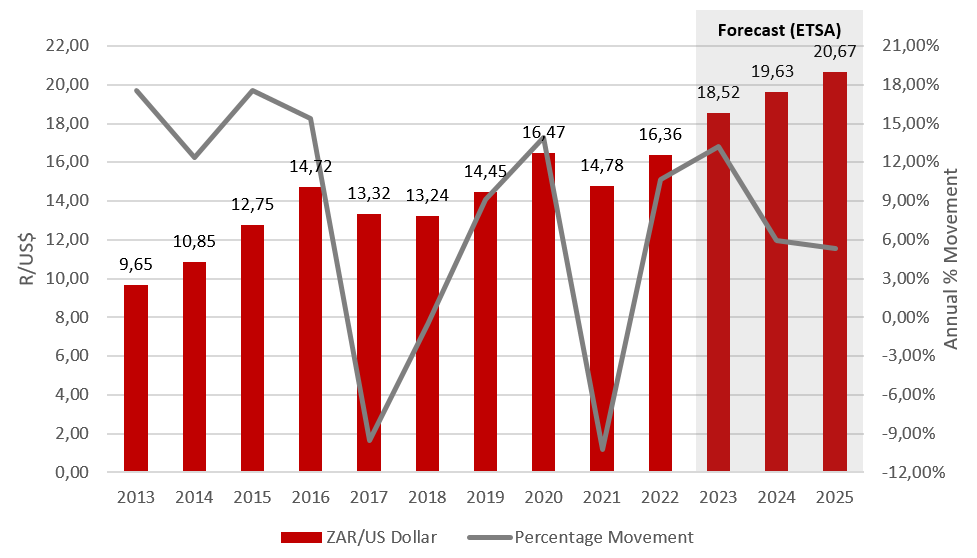HARMONY GOLD MINING COMPANY LIMITED
Technical Report Summary of the
Mineral Resources and Mineral Reserves
for
Doornkop Mine
Gauteng Province, South Africa
Effective Date: June 30, 2024
Final Report Date: October 31, 2024
Technical Report Summary for
Doornkop Mine, Gauteng Province, South Africa
| | |
IMPORTANT NOTICE
This Technical Report Summary has been prepared for Harmony Gold Mining Company Limited in support of disclosure and filing requirements with the United States Securities and Exchange Commission’s (SEC) under Subpart 1300 of Regulation S-K 1300 and Section 229.601(b)(96) of Regulation S-K. The quality of information, estimates, and conclusions contained in this Technical Report Summary apply as of the effective date of this report. Subsequent events that may have occurred since that date may have resulted in material changes to such information, estimates and conclusions in this summary. |
Effective Date: June 30, 2024
Final Report Date: October 31, 2024
ii
Technical Report Summary for
Doornkop Mine, Gauteng Province, South Africa
QP Consent and Sign-off
I have read and understood the requirements of:
•the South African Code for Reporting of Exploration Results, Mineral Resources and Mineral Reserves (the "SAMREC Code, 2016 edition")
•the Harmony Guidelines on the Reporting of Exploration Results, Mineral Resources and Mineral Reserves
•Subpart 1300 (17 CFR 229.1300) of Regulation S-K, Disclosure by Registrants Engaged in Mining Operations (“Regulation S-K 1300”)
I am a Competent Person as defined by the SAMREC Code, 2016 edition and the Qualified Person (“QP”) under Regulation S-K 1300, having more than five years` experience that is relevant to the style of mineralization and type of deposit described in the Report, and to the all activities for which I am accepting responsibility and have been appointed as QP for Doornkop Mine Mineral Resources and Mineral Reserves.
I am a Member of SACNASP and my registration is as follow:
Mineral Resource
Hilton Chirambadare
SACNASP (South African Council for Natural Scientific Professions)
Nr 400204
Years’ Experience: 21
I have reviewed the tables and graphs included for the Doornkop Mine Mineral Resource and Mineral Reserve which will be used in the 2024 Harmony Gold Mineral Resource and Mineral Reserve Report to which this Consent Statement applies.
I acknowledge responsibility for all the Sections of the TRS report and as the QP and author I relied on information provided by various subject experts.
At the effective date of the Report, to the best of my knowledge, information and belief, the Report contains all scientific and technical information that is required to be disclosed to make the Report not misleading.
/s/ Hilton Chirambadare
___________________________________
Mr Hilton Chirambadare
BSc. (Hons) Geol, GDE, MENG, MBA
SACNASP (No. 400204)
Ore Reserve Manager, Doornkop Mine
Harmony Gold Mining Company Limited
Effective Date: June 30, 2024
Final Report Date: October 31, 2024
iii
Technical Report Summary for
Doornkop Mine, Gauteng Province, South Africa
List of Contents
Effective Date: June 30, 2024
Final Report Date: October 31, 2024
iv
Technical Report Summary for
Doornkop Mine, Gauteng Province, South Africa
Effective Date: June 30, 2024
Final Report Date: October 31, 2024
v
Technical Report Summary for
Doornkop Mine, Gauteng Province, South Africa
Effective Date: June 30, 2024
Final Report Date: October 31, 2024
vi
Technical Report Summary for
Doornkop Mine, Gauteng Province, South Africa
Effective Date: June 30, 2024
Final Report Date: October 31, 2024
vii
Technical Report Summary for
Doornkop Mine, Gauteng Province, South Africa
List of Figures
Effective Date: June 30, 2024
Final Report Date: October 31, 2024
viii
Technical Report Summary for
Doornkop Mine, Gauteng Province, South Africa
List of Table
Effective Date: June 30, 2024
Final Report Date: October 31, 2024
ix
Technical Report Summary for
Doornkop Mine, Gauteng Province, South Africa
Units of Measure and Abbreviations
| | | | | |
| Unit / Abbreviation | Description or Definition |
| °C | degrees Celsius |
| µm | Micrometres |
| 2D | Two-dimensional |
| 3D | Three-dimensional |
| AE | Abnormal expenditure |
| Ag | Silver |
| AMIS | African Mineral Standards |
| Au | Gold |
| AuBIS | Harmony electronic database |
| Ave. | Average |
| BLR | Black Reef |
| BMD | Below mine datum |
| Bn | Billion |
| BP | Business plan |
| BSI | British Standard Institute |
| c. | Approximately |
| CIP | Carbon-In-Pulp |
| CLR | Carbon Leader Reef |
| cm | Centimetre |
| cmg/t | Centimetre-grams per tonne |
| CODM | Chief Operating Decision-Maker |
| Company | Harmony Gold Mining Company Limited |
| COP | Code of Practice |
| CRG | Central Rand Group |
| CRM | Certified Reference Material |
| CV | Coefficient of Variation |
| DMRE | Department of Mineral Resources and Energy |
| Doornkop | Doornkop Mine |
| DWS | Department of Water and Sanitation |
| EIA | Environmental Impact Assessment |
| EMPR | Environmental Management Programme |
| EMS | Environmental Management System |
| EMTS | Electric Monorail Transport System |
| ESG | Environmental Social and Governance |
| ETF | Exchange traded fund |
| EW-SX | Electro-wining solvent extraction |
| FX | Foreign Exchange rate |
| g | Gram |
| g/t | Grams per tonne |
| g/t | Grams per metric tonne |
| GDARD | Gauteng Department of Agriculture and Rural Development |
| GHG | Greenhouse gas |
| GISTM | Global Industry Standard on Tailings Management |
| Harmony | Harmony Gold Mining Company Limited |
| HPE | Hydro-powered |
| ICMC | International Cyanide Management Code |
| kg | Kilogram |
| km | Kilometre |
km2 | Square kilometre |
| Kusasalethu | Kusasalethu Gold Mine |
| kWh | Kilowatt-hour |
| LMBA | London Bullion Market Association |
| LDL | Lower detection limit |
| LIB | Long inclined borehole |
| LOM | Life of Mine |
Effective Date: June 30, 2024
Final Report Date: October 31, 2024
x
Technical Report Summary for
Doornkop Mine, Gauteng Province, South Africa
| | | | | |
| Unit / Abbreviation | Description or Definition |
| Ltd | Limited |
| m | Metre |
| M | Million |
m3/hr | Cubic metres per hour |
| masl | Metres above sea level |
| MCC | Mining Charter Compliance |
| MCF | Mine Call Factor |
| Mintek | Mintek SA, South Africa's national mineral research organisation |
| Moz | Million troy ounces |
| Mponeng | Mponeng Gold Mine |
| MPRDA | Mineral and Petroleum Resources Development Act, 28 of 2002 |
| Mt | Million tonnes |
| Mtpa | Million tonnes per annum |
| Mtpm | Million tonnes per month |
| NEMA | National Environmental Management Act, 107 of 1998 |
| No. | Number |
| NPV | Net present value |
| OTC | Over the counter |
| oz | Troy ounce |
| PFZ | Pretorius Fault Zone |
| PSD | Particle Size Distribution |
| Pty | Proprietary |
| QA/QC | Quality Assurance/Quality Control |
| QP | Qualified Person |
| REGM | Randfontein Estates Gold Mining Company Limited |
| ROM | Run-of-Mine |
| SACNASP | South African Council for Natural Scientific Professions |
| SAG | Semi-autogenous |
| SAMREC | The South African Code for the Reporting of Exploration Results, Mineral Resources and Mineral Reserves |
| SANAS | South African National Accreditation System |
| Savuka | Savuka Gold Mine |
| SD | Standard Deviation |
| SEC | Securities and Exchange Commission |
| SGM | Sequential Grid Mining |
| SGS | SGS South Africa (Pty) Limited |
| Sibanye-Stillwater | Sibanye Stillwater Limited |
| SLP | Social Labour Plan |
| t | Metric tonne |
t/m3 | Tonne per cubic metre |
| TauTona | TauTona Gold Mine |
| TRS | Technical Report Summary |
| TSF | Tailings Storage Facility |
| USD | United States Dollars |
| USD/oz | United States Dollar per troy ounce |
| VCR | Ventersdorp Contact Reef |
| West Wits | Harmony's West Rand operations |
| WRG | West Rand Group |
| WUL | Water Use Licence |
| ZAR | South African Rand |
| ZAR/kg | South African Rand per kilogram |
Effective Date: June 30, 2024
Final Report Date: October 31, 2024
xi
Technical Report Summary for
Doornkop Mine, Gauteng Province, South Africa
Glossary of Terms
| | | | | |
| Term | Definition |
| Co-kriging | A method that is used to predict the value of the point at unobserved locations by sample points that are known to be spatially interconnected by adding other variables that have a correlation with the main variable or can also be used to predict 2 or more variables simultaneously. |
| Cut-off grade | Cut-off grade is the grade (i.e. the concentration of metal or mineral in rock) that determines the destination of the material during mining. For purposes of establishing “prospects of economic extraction,” the cut-off grade is the grade that distinguishes material deemed to have no economic value (it will not be mined in underground mining or if mined in surface mining, its destination will be the waste dump) from material deemed to have economic value (its ultimate destination during mining will be a processing facility). Other terms used in similar fashion as cut-off grade include net smelter return, pay limit, and break-even stripping ratio. |
| Dilution | Unmineralized rock that is by necessity, removed along with ore during the mining process that effectively lowers the overall grade of the ore. |
| Head grade | The average grade of ore fed into the mill. |
| Economically viable | Economically viable, when used in the context of Mineral Reserve determination, means that the qualified person has determined, using a discounted cash flow analysis, or has otherwise analytically determined, that extraction of the Mineral Reserve is economically viable under reasonable investment and market assumptions. |
| Indicated Mineral Resource | Indicated Mineral Resource is that part of a Mineral Resource for which quantity and grade or quality are estimated on the basis of adequate geological evidence and sampling. The level of geological certainty associated with an Indicated Mineral Resource is sufficient to allow a qualified person to apply modifying factors in sufficient detail to support mine planning and evaluation of the economic viability of the deposit. Because an Indicated Mineral Resource has a lower level of confidence than the level of confidence of a Measured Mineral Resource, an Indicated Mineral Resource may only be converted to a probable Mineral Reserve. |
| Inferred Mineral Resource | Inferred Mineral Resource is that part of a Mineral Resource for which quantity and grade or quality are estimated on the basis of limited geological evidence and sampling. The level of geological uncertainty associated with an Inferred Mineral Resource is too high to apply relevant technical and economic factors likely to influence the prospects of economic extraction in a manner useful for evaluation of economic viability. Because an Inferred Mineral Resource has the lowest level of geological confidence of all Mineral Resources, which prevents the application of the modifying factors in a manner useful for evaluation of economic viability, an Inferred Mineral Resource may not be considered when assessing the economic viability of a mining project and may not be converted to a Mineral Reserve. |
| Kriging | A method of interpolation based on Gaussian process governed by prior covariances. It uses a limited set of sampled data points to estimate the value of a variable over a continuous spatial field |
| Mine Call Factor | The ratio, expressed as a percentage, of the total quantity of recovered and unrecovered mineral product after processing with the amount estimated in the ore based on sampling. |
| Measured Mineral Resource | Measured Mineral Resource is that part of a Mineral Resource for which quantity and grade or quality are estimated on the basis of conclusive geological evidence and sampling. The level of geological certainty associated with a Measured Mineral Resource is sufficient to allow a qualified person to apply modifying factors, as defined in this section, in sufficient detail to support detailed mine planning and final evaluation of the economic viability of the deposit. Because a Measured Mineral Resource has a higher level of confidence than the level of confidence of either an Indicated Mineral Resource or an Inferred Mineral Resource, a Measured Mineral Resource may be converted to a Proven Mineral Reserve or to a Probable Mineral Reserve. |
| Mineral Reserve | Mineral Reserve is an estimate of tonnage and grade or quality of Indicated and Measured Mineral Resources that, in the opinion of the qualified person, can be the basis of an economically viable project. More specifically, it is the economically mineable part of a Measured or Indicated Mineral Resource, which includes diluting materials and allowances for losses that may occur when the material is mined or extracted. |
| Mineral Resource | Mineral Resource is a concentration or occurrence of material of economic interest in or on the Earth’s crust in such form, grade or quality, and quantity that there are reasonable prospects for economic extraction. A Mineral Resource is a reasonable estimate of mineralization, taking into account relevant factors such as cut-off grade, likely mining dimensions, location or continuity, that, with the assumed and justifiable technical and economic conditions, is likely to, in whole or in part, become economically extractable. It is not merely an inventory of all mineralization drilled or sampled. |
Effective Date: June 30, 2024
Final Report Date: October 31, 2024
xii
Technical Report Summary for
Doornkop Mine, Gauteng Province, South Africa
| | | | | |
| Modifying Factors | Modifying factors are the factors that a qualified person must apply to Indicated and Measured Mineral Resources and then evaluate in order to establish the economic viability of Mineral Reserves. A qualified person must apply and evaluate modifying factors to convert Measured and Indicated Mineral Resources to Proven and Probable Mineral Reserves. These factors include but are not restricted to: mining; processing; metallurgical; infrastructure; economic; marketing; legal; environmental compliance; plans, negotiations, or agreements with local individuals or groups; and governmental factors. The number, type and specific characteristics of the modifying factors applied will necessarily be a function of and depend upon the mineral, mine, property, or project. |
| Pre-Feasibility Study | A pre-feasibility study (or preliminary feasibility study) is a comprehensive study of a range of options for the technical and economic viability of a mineral project that has advanced to a stage where a qualified person has determined (in the case of underground mining) a preferred mining method, or (in the case of surface mining) a pit configuration, and in all cases has determined an effective method of mineral processing and an effective plan to sell the product. (1) A pre-feasibility study includes a financial analysis based on reasonable assumptions, based on appropriate testing, about the modifying factors and the evaluation of any other relevant factors that are sufficient for a qualified person to determine if all or part of the Indicated and Measured Mineral Resources may be converted to Mineral Reserves at the time of reporting. The financial analysis must have the level of detail necessary to demonstrate, at the time of reporting, that extraction is economically viable. (2) A pre-feasibility study is less comprehensive and results in a lower confidence level than a feasibility study. A pre-feasibility study is more comprehensive and results in a higher confidence level than an initial assessment. |
| Probable Mineral Reserve | Probable Mineral Reserve is the economically mineable part of an Indicated and, in some cases, a Measured Mineral Resource. |
| Proven Mineral Reserve | Proven Mineral Reserve is the economically mineable part of a Measured Mineral Resource and can only result from conversion of a Measured Mineral Resource. |
| Qualified Person | A qualified person is: (1) A mineral industry professional with at least five years of relevant experience in the type of mineralization and type of deposit under consideration and in the specific type of activity that person is undertaking on behalf of the registrant; and (2) An eligible member or licensee in good standing of a recognized professional organization at the time the technical report is prepared. For an organization to be a recognized professional organization, it must: (i) Be either: (A) An organization recognized within the mining industry as a reputable professional association; or (B) A board authorized by U.S. federal, state or foreign statute to regulate professionals in the mining, geoscience or related field; (ii) Admit eligible members primarily on the basis of their academic qualifications and experience; (iii) Establish and require compliance with professional standards of competence and ethics; (iv) Require or encourage continuing professional development; (v) Have and apply disciplinary powers, including the power to suspend or expel a member regardless of where the member practices or resides; and (vi) Provide a public list of members in good standing. |
| Tailings | Finely ground rock of low residual value from which valuable minerals have been extracted is discarded and stored in a designed dam facility. |
| Tailings Freeboard | The vertical height between the beached tailings against the embankment crest and the crest itself. |
Effective Date: June 30, 2024
Final Report Date: October 31, 2024
xiii
Technical Report Summary for
Doornkop Mine, Gauteng Province, South Africa
1Executive Summary
Section 229.601(b)(96)(iii)(B)(1)
The QP of Harmony Gold Mining Company Limited (“Harmony” or the “Company”) has prepared this Technical Report Summary (“TRS”) to disclose the Mineral Resource and Mineral Reserve estimates for the Company’s Doornkop Mine (“Doornkop” or “Doornkop Mine”). The TRS has been prepared in accordance with the U.S. Securities and Exchange Commission's (“SEC”) Regulation S-K 1300, with an effective date as at June 30, 2024. No material changes have occurred between the effective date and the date of signature of this TRS.
This TRS updates the TRS filed by Harmony on Doornkop on October 31, 2022, named Exhibit 96.10 Technical Report Summary of the Mineral Resources and Mineral Reserves for Doornkop Mine Gauteng Province, South Africa, which was effective on June 30, 2022. This TRS is being filed to satisfy the requirement of Item 1302(e)(6) of regulation S-K. An economic assessment was included, using a detailed discounted cashflow analysis for the Mineral Reserves, excluding all scheduled Inferred Mineral Resource which is not reported under Mineral Reserve. No material changes have occurred between the effective date and the date of signature of this TRS.
Property Description
The Doornkop shaft complex is located south of Krugersdorp, 30km west of Johannesburg, in Gauteng Province, South Africa. The property lies between Sibanye Stillwater Limited’s (“Sibanye-Stillwater”) Cooke 1 shaft and Durban Roodepoort Deep Limited. Doornkop is a part of Harmony’s West Rand operations and extends to a maximum depth of approximately 2,000m below surface. Current mining operations extract the South Reef, with the Mineral Reserves being comprised entirely of this reef. Mineral Resources are comprised of the South Reef and the Kimberley Reef, and a limited (<0.5%) amount of the Main Reef.
The current mining right (Reference No. GP30/5/1/2/2/09MR), held by Randfontein Estates Gold Mining Company Limited (“REGM”), encompasses an area of 2,941ha and is valid from 7 October 2008 to 6 October 2038.
Ownership
Doornkop is wholly owned by Harmony, including the associated mineral rights. Harmony acquired the mine in January 2000, when Harmony took control of REGM.
Geology and Mineralisation
Doornkop is situated on the northwestern margin of the Witwatersrand Basin of South Africa, one of the most prominent gold provinces in the world. While there are several gold-bearing conglomerate reefs present within the mining right area, only the Kimberley Reef and South Reef are considered to have prospects for economic extraction at this stage.
In the West Rand Goldfield, the Kimberley Reefs include a number of different gold-bearing conglomerate horizons. At Doornkop, it is the Kimberley K9 Reef horizon which comprises the Mineral Resources along with the South Reef. The K9 Reef rests on an unconformity and is a multi-pulse conglomerate which is divided into four cycles, each consisting of an upper conglomerate and a lower quartzite.
The South Reef comprises a basal conglomerate unit and a cycle of trough cross-bedded sediments. The South Reef is dominated by silicate phases such as quartz, carbon (seam and specks), as well as sulphide phases such as pyrite, pyrrhotite and chalcopyrite. While the upper cycles may carry some gold values, up to 95% of the gold mineralisation is located in the lower cycle.
Both the Kimberley Reef and the South Reef have been subjected to faulting and are intruded by a series of dykes and sills of various ages that cut across the reefs. The gold mineralisation is interpreted to have succeeded a period of deep burial, fracturing, and alteration. The gold and other elements are believed to have precipitated through the reaction of hydrothermal fluids at high temperatures along the reef horizons.
Effective Date: June 30, 2024
Final Report Date: October 31, 2024
1
Technical Report Summary for
Doornkop Mine, Gauteng Province, South Africa
Status of Exploration, Development and Operation
Doornkop has mined a combination of South Reef and Kimberley Reef over the past 30 years. Mining methods and associated production rates have varied through its history from mechanised to conventional. Doornkop has, for the past five years been producing approximately 90 to 110 thousand ounces (“koz”) of gold annually from the South Reef only.
Extensive exploration informs both the South Reef and Kimberley Reef models, and Harmony continues to conduct underground drilling and channel (chip) sampling on the South Reef. Sampling of underground drill hole intersections, as well as sampling of established stopes on the reef horizon, inform the updates to the Mineral Resources. Harmony has budgeted ZAR20m for infill exploration drilling and ZAR14m for LIB (Long Incline Boreholes) drilling on the South Reef over the next 12 months.
Doornkop is a well-established mine which operates uninterrupted at a steady state throughout the year.
Mineral Resource Estimate
The narrow-tabular nature of the Kimberley and South Reefs at Doornkop lend themselves to the estimation of grade and thickness in two-dimensional block models. The estimates are based on a verified electronic database containing surface drill hole data, as well as underground drilling, mapping, and sampling data obtained up until December 2023. Gold accumulation and channel widths are estimated using ordinary and simple macro kriging interpolation methods.
The Mineral Resources were originally prepared, classified and reported according to the South African Code for the Reporting of Exploration Results, Mineral Resources and Mineral Reserves, 2016 edition (“SAMREC, 2016”). For the purposes of this TRS, the Mineral Resources have been classified in accordance with § 229.1302(d)(1)(iii)(A) (Item 1302(d)(1)(iii)(A) of Regulation S-K). The S-K classification is similar to SAMREC 2016.
The QP responsible for compiling the Mineral Resource estimates is Mr H Chirambadare, Ore Reserve Manager at Doornkop, who is an employee of Harmony.
The Mineral Resource estimate, exclusive of the reported Mineral Reserves, is summarised in Table 1-1.
Table 1-1: Summary of the Doornkop Mineral Resource Estimate as at June 30, 2024 (Exclusive of Mineral Reserves) 1-8
| | | | | | | | | | | |
| METRIC |
| Mineral Resource Category | Tonnes (Mt) | Gold Grade (g/t) | Gold Content (kg) |
| Measured | 19.360 | 3.64 | 70,440 |
| Indicated | 12.201 | 3.21 | 39,138 |
| Total / Ave. Measured + Indicated | 31.561 | 3.47 | 109,578 |
| Inferred | 12.126 | 4.15 | 50,357 |
| | | |
| IMPERIAL |
| Mineral Resource Category | Tons (Mt) | Gold Grade (oz/t) | Gold Content (Moz) |
| Measured | 21.340 | 0.106 | 2.265 |
| Indicated | 13.450 | 0.094 | 1.258 |
| Total / Ave. Measured + Indicated | 34.790 | 0.101 | 3.523 |
| Inferred | 13.367 | 0.121 | 1.619 |
Notes
1. Mineral Resources are reported with an effective date of June 30, 2024 were originally prepared, classified and reported according to SAMREC, 2016. For the purposes of this TRS, the Mineral Resources have been classified in accordance with § 229.1302(d)(1)(iii)(A) (Item 1302(d)(1)(iii)(A) of Regulation S-K). The Qualified Person responsible for the estimate is Mr H Chirambadare, who is Ore Reserve Manager at Doornkop, and a Harmony employee.
2. The Mineral Resource tonnes are reported as in-situ with reasonable prospects for economic extraction.
3. No modifying factors or dilution sources have been included to in-situ Reserve which was subtracted from the SAMREC Resource in order to obtain the S-K 1300 Resource.
4. The Mineral Resources are reported using a cut-off value of 490cmg/t determined at a 96.65% plant recovery factor, and a gold price of USD1,878/oz.
5. Tonnes are reported rounded to three decimal places. Gold values are rounded to zero decimal places.
6. Mineral Resources are exclusive of Mineral Reserves. Mineral Resources are not Mineral Reserves and do not necessarily demonstrate economic viability, but have been assessed for prospects of economic extraction.
7. Rounding as required by reporting guidelines may result in apparent summation differences.
8. The Mineral Resource estimate is for Harmony’s 100% interest.
Effective Date: June 30, 2024
Final Report Date: October 31, 2024
2
Technical Report Summary for
Doornkop Mine, Gauteng Province, South Africa
Mineral Reserve Estimate
The Mineral Reserves for Doornkop were originally prepared, classified and reported according to SAMREC, 2016. For the purposes of this TRS, the Mineral Reserves have been classified in accordance with § 229.1302(d)(1)(iii)(A) (Item 1302(d)(1)(iii)(A) of Regulation S-K). The QP employed the same classification for both cases.
Mineral Reserves are derived from the Mineral Resources, a detailed business plan and the operational mine planning processes. Mine planning utilises and takes into consideration historical technical parameters achieved. In addition, Mineral Resource conversion to Mineral Reserves considers Modifying Factors, dilution, ore losses, minimum mining widths and the planned mine call factor.
The QP responsible for compiling the Mineral Reserve estimates is Mr H Chirambadare, Ore Reserve Manager at Doornkop, who is an employee of Harmony.
The Mineral Reserve estimate, as at June 30, 2024, is summarised in Table 1-2.
Table 1-2: Summary of the Doornkop Mineral Reserve Estimate as at June 30, 2024 1-5
| | | | | | | | | | | |
| METRIC |
| Mineral Reserve Category | Tonnes (Mt) | Gold Grade (g/t) | Gold Content (kg) |
| Proved | 4.822 | 4.01 | 19,317 |
| Probable | 8.734 | 4.51 | 39,379 |
| Total (Proved + Probable) | 13.556 | 4.33 | 58,696 |
| | | |
| IMPERIAL |
| Mineral Reserve Category | Tons (Mt) | Gold Grade (oz/t) | Gold Content (Moz) |
| Proved | 5.315 | 0.117 | 0.621 |
| Probable | 9.628 | 0.132 | 1.266 |
| Total (Proved + Probable) | 14.943 | 0.126 | 1.887 |
Notes:
1. The Mineral Reserves were originally prepared, classified and reported according to SAMREC, 2016. For the purposes of this TRS, the Mineral Reserves have been classified in accordance with § 229.1302(d)(1)(iii)(A) (Item 1302(d)(1)(iii)(A) of Regulation S-K). The Qualified Person responsible for the estimate is Mr H Chirambadare, who is the Doornkop Ore Reserve Manager, and a Harmony employee.
2. Tonnes, grade, and gold content (oz) are declared as net delivered to the mills.
3. Figures are fully inclusive of all mining dilutions, gold losses and are reported as mill delivered tonnes and head grades. Metallurgical recovery factors have not been applied to the reserve figures.
4. Gold content is delivered gold content after taking into consideration the modifying factors.
5. Mineral Reserves are reported using a cut-off grade of 500cmg/t determined using a gold price of USD1,772/oz gold, a unit operating cost of R3395/ton and plant recovery factor of 96.65%.
6. Rounding as required by reporting guidelines may result in apparent summation differences.
The Mineral Reserves are derived entirely from the South Reef Mineral Resources. No Kimberley Reef Mineral Resources have been converted to Mineral Reserves.
In the QP’s opinion, Doornkop is an established operation, and the Modifying Factors used in the Mineral Reserve estimate have a reasonable basis and, at a minimum, would satisfy the confidence levels for a Pre-Feasibility Study.
The estimated Mineral Reserves were depleted to generate the Doornkop cash flows and a positive NPV. The economic analysis of the cash flows displays profitability and are deemed both technically and economically achievable. (See table 19.1)
Capital and Operating Cost Estimates
The capital cost estimates for Doornkop are determined at corporate level, using the business plan as a basis. The estimated capital costs for Doornkop are reported according to costs associated with ongoing capital development, major equipment outside the main operating sections which is termed abnormal expenditure (“AE”), infrastructure development (“Shaft Capital”) and capital associated with Mining Charter compliance (“MCC”), The capital and operating costs are reported in ZAR terms and on a real basis. These projects are not considered as major projects, hence no feasibility or pre-feasibility studies are done prior to the budgets being submitted for approval. The summary capital cost estimates are shown in Table 1-3.
Effective Date: June 30, 2024
Final Report Date: October 31, 2024
3
Technical Report Summary for
Doornkop Mine, Gauteng Province, South Africa
The operating cost estimates for Doornkop are categorised into direct and total costs. A summary of the Doornkop operating cost estimate is presented in Table 1-4.
Table 1-3: Summary of Capital Cost Estimate for Doornkop
| | | | | |
| Capital Cost Element (ZAR'000s) | Total Mineral Reserves (FY2025- FY2040) |
| OCD | 2,821,370 |
| AE | 310,402 |
| Shaft Capital | 284,214 |
| Major Capital | 1,573,546 |
| Total capital | 4,989,532 |
| MCC | 123,237 |
| Total | 5,112,769 |
Table 1-4: Summary of Operating Cost Estimate for Doornkop
| | | | | |
| Operating Cost Element (ZAR'000) | Total Mineral Reserves(FY2025 - FY2040) |
| Mining | 23,449,561 |
| Services | 4,578,791 |
| Medical Hub / Station | 989,376 |
| Engineering | 14,215,929 |
| |
| |
| Total Costs By Process | 43,233,657 |
| Mine Overheads | 2,299,951 |
| Total Cost | 45,533,608 |
Both, the capital and operating estimates are accounted for in the economic analysis of Doornkop Mine. The results of the economic analysis demonstrate positive returns.
Permitting Requirements
Doornkop has valid permits, administered and managed by various departments, and does not require any additional permits to continue with their mining operations. These have been approved by the regulator at the effective date of this TRS. The permits and licences are summarised in Table 1-5.
Table 1-5: Status of Environmental Permits and Licences
| | | | | | | | | | | | | | |
| Permit / Licence | Reference No. | Issued By | Date Granted | Validity |
| Environmental Management Programme Report (“EMPR”) | GP30/5/1/2/2/(09) EM | DMRE | June 7, 2010 | LOM |
| Certificate of Registration (Nuclear) | 01/0025/06 | National Nuclear Regulator | May 31, 2003 | LOM |
| Water Use Permit | 33/2/323/24 | DWS | December 1, 1977 | LOM |
| Integrated WUL (Draft) | 16/2/7/C221/C024 | DWS | January 1, 2010 | LOM |
| ISO 14001 Certification | 631282 | BSI | November 1, 2021 | 01-Nov-24 |
| Cyanide Management Certification | N/A | ICMC | April 1, 2021 | 01-Apr-24 |
| Precious Metal Refining Licence | 1889/000251/66 | SA Diamond & Precious Metals Regulator | June 1, 2011 | 01-Jun-2041 |
| Environmental Authorisation for Water Treatment Plant | GP30/5/1/2/2/(09) EM | DMRE | August 1, 2016 | LOM |
| License to impound water in a dam with Safety risk | 12/2/C221/69 | DWS | July 17, 2009 | LOM |
Effective Date: June 30, 2024
Final Report Date: October 31, 2024
4
Technical Report Summary for
Doornkop Mine, Gauteng Province, South Africa
Notes: DMRE - Department of Mineral Resources and Energy, DWS - Department of Water and Sanitation, BSI - British Standard Institute, ICMC-International Cyanide Management Code
Conclusions
Under the assumptions in this TRS, Doornkop shows a positive cash flow and NPV over the life of mine (“LOM”). The mine plan is supported by the Mineral Resource and Mineral Reserve estimates and is considered achievable under the set of assumptions and parameters used.
Doornkop did not incur any fines or penalties for non-compliance during the year ended June 30, 2024 and no significant encumbrances exist.
Recommendations
In the QP's opinion, to further de-risk the Mineral Resource and Mineral Reserves ahead of mining, the active long inclined borehole (“LIB”) drilling campaign should be continued. Additional exploration should be undertaken to investigate the continuation of high-grade pay shoots within the South Reef, as anticipated through historical literature and mining results.
2Introduction
Section 229.601(b)(96)(iii)(B)(2) (i-v)
This TRS on Doornkop has been prepared for the registrant, Harmony. The TRS has been prepared in accordance with the Regulations S-K 1300. It has been prepared to meet the requirements of Section 229.601(b)96 – Technical Report Summary.
The purpose of this TRS is to provide open and transparent disclosure of all material, exploration activities, Mineral Resource and Mineral Reserve information to enable the investor to understand the Doornkop Mine which forms part of Harmony’s activities.
This TRS has been prepared from the following sources of information:
•Competent Persons Report (Ore Reserve Statement for period ended June 30, 2024, Technical Report for Doornkop Operations) (prepared by Mr H Chirambadare) dated June 30, 2024;
•Base geological and mine planning data;
•various technical reports;
•the 2024 and 2025 Harmony Corporate Business Plan; and
•published Harmony 2024 Mineral Resources and Mineral Reserves Report as at June 30, 2024 (“HAR-RR24”).
The TRS was prepared by the QP employed on a full-time basis by the registrant. The QP’s qualifications, areas of responsibility and personal inspections of the property are summarised in Table 2 1.
Table 2-1: List of Responsible and Contributing Authors
| | | | | | | | | | | | | | |
| Qualified Person | Professional Organisation | Qualification | TRS Section Responsibility | Personal Insp. |
| Mr H Chirambadare | SACNASP | BSc. (Geol, Math), BSc. (Hons) Geol, MENG, MBA | All | Full time |
The QP states that this TRS updates the TRS filed by Harmony on Doornkop on October 31, 2022, named Exhibit 96.10 Technical Report Summary of the Mineral Resources and Mineral Reserves for Doornkop Mine Gauteng Province, South Africa, which was effective on June 30, 2022. This updated TRS has an effective date of June 30, 2024. No material changes have occurred between the effective date and the date of signature.
Effective Date: June 30, 2024
Final Report Date: October 31, 2024
5
Technical Report Summary for
Doornkop Mine, Gauteng Province, South Africa
3Property Description
Section 229.601(b)(96)(iii)(B)(3) (i-vii)
Doornkop is an underground gold mine located in the West Wits mining district Southwest of Johannesburg, in the Gauteng Province. At longitude 27°47'26.55"E and latitude 26°13'03.2"S, the mine is approximately 30km from Johannesburg and forms part of Harmony's West Rand (“West Wits”) operations. The location of Doornkop and its relative proximity to the other West Wits operations is shown in Figure 3-1.
3.1Mineral Tenure
South African Mining Law is regulated by the Mineral and Petroleum Resources Development Act,2008 (“MPRDA”) which is the predominant piece of legislation dealing with acquisitions or rights to conduct reconnaissance, prospecting, and mining. There are several other pieces of legislation which deal with such ancillary issues such as royalties (MPRDA), title registration (Mining Titles Registration Act, 1967), and health and safety (Mine Health and Safety Act, 1996).
The current mining right is held by REGM, a wholly owned subsidiary of Harmony. The right encompasses an area of 2,941.021ha and was successfully converted, executed and registered as a new order mining right at the Mineral and Petroleum Resources Titles Office. As such, it is secured under Mining Authorisation number ML 13/97. The Department of Mineral Resources and Energy reference GP30/5/1/2/2/09MR was issued for a period of 30 years expiring on 6 October 2038, and Harmony has the exclusive right to renew the right. The summary of mineral tenure and the approved mining area (also referred to as the mining lease area) is shown in Table 3-1 and Figure 3-2.
Table 3-1: Summary of Mineral Rights for Doornkop
| | | | | | | | | | | | | | | | | |
| Licence Holder | Licence Type | Reference No. | Effective Date | Expiry Date | Area (ha) |
| Randfontein Estates Gold Mining Company Limited | Mining Right | GP30/5/1/2/2/09MR | October 7, 2008 | October 6, 2038 | 2,941.02 |
| | | | | |
| | | | | |
| | | | | |
| | | | | |
| | | | | |
| | | | | |
| | | | | |
In the opinion of the QP, under the MPRDA, Harmony is entitled to apply to renew the mining right on its expiry. There are no known legal proceedings (including violations or fines) against the Company which threatens its mineral rights, tenure, or operations.
3.2Property Permitting Requirements
The surface rights over the Doornkop lease area are held by REGM (Table 3-2) (Figure 3-2). The total lease area is sufficient in size and nature to accommodate the required surface infrastructure to facilitate current and planned mining and processing operations.
Table 3-2: Surface Permits held by Doornkop
| | | | | | | | | | | | | | |
| Permit Holder | Farm Name | Portion No. | Title Deed No. | Area (ha) |
| Randfontein Estates Ltd | Doornkop 239 IQ | 130 | T14868/1985 | 228.900 |
| 131 | T35158/1986 | 125.453 |
| Vlakfontein 238 IQ | 4 | T55420/2019 | 558.417 |
| 912.770 |
Source: Deeds Office Property Search, July 30, 2022
Harmony holds Water Use Permits (REF: 33/2/323/24) from the Department of Water and Sanitation (“DWS”) as well as various other environmental authorisations related to its activities at Doornkop. The other permits associated with environmental aspects are discussed Section 17.
Harmony monitors complaints and litigation against the Company as part of its risk management systems, policies, and procedures. There is no material litigation (including violations or fines) against the Company as at the date of this report which threatens its property permitting. The Company is also not aware any land claims or other legal proceedings that may have an influence on the rights to mine the minerals.
Effective Date: June 30, 2024
Final Report Date: October 31, 2024
6
Technical Report Summary for
Doornkop Mine, Gauteng Province, South Africa
Figure 3-1: Location of Doornkop
Effective Date: June 30, 2024
Final Report Date: October 31, 2024
7
Technical Report Summary for
Doornkop Mine, Gauteng Province, South Africa
Figure 3-2: Mineral Tenure of Doornkop
Effective Date: June 30, 2024
Final Report Date: October 31, 2024
8
Technical Report Summary for
Doornkop Mine, Gauteng Province, South Africa
4Accessibility, Climate, Local Resources, Infrastructure and Physiography
Section 229.601(b)(96)(iii)(B)(4) (i-iv)
4.1Accessibility
Doornkop Mine is located approximately 30km west of Johannesburg and is easily accessible via the R558 provincial road (Figure 3-1). Access to the mine is restricted by security fencing, security guards, booms and lockable gates at the main entrance. In addition, a communication system and access control system monitors personnel entering and leaving the mine property.
4.2Physiology and Climate
Doornkop is located within the Highveld region of South Africa. The general elevation across of the lease area varies from 1,600m to 1,780m above sea level (“asl”), gently sloping to the southwest. The surrounding area is characterised by undulating plains interspersed by rocky outcrops. Mining activities in the area have altered the natural topography of the area with the presence of old tailings dams and waste rock dumps.
The mine is situated within the Highveld climatic zone which is characterised by warm wet summers and cool to cold dry winters. The average annual rainfall recorded at the operation (2015 – 2018) was 698mm. Most of the rainfall occurs as heavy thunderstorms resulting in erosion and runoff. These typically occur between November and February. Temperature patterns are characterised by seasonal and daily variations, where summers are warm to hot and winters are mild to cold. The seasonal fluctuations in mean temperatures between the warmest and the coldest months varies between 12°C and 15°C.
The Doornkop operation is not restricted by climatic or seasonal occurrences.
4.3Local Resources and Infrastructure
Infrastructure in the region is well established supporting the numerous operational gold mines in the area. The regional infrastructure includes national and provincial paved road networks, power transmission and distribution networks, water supply networks and communication infrastructure. Doornkop’s surface and underground infrastructure, including its power and water supplies, is sufficient for the current and planned production level requirements. Areas that require expansion or upgrading will be attended to, e.g, a refrigeration plant is planned to ensure that adequate ventilation is supplied to the mine over life of mine.
Doornkop’s main and vent shaft systems are currently exploiting the South Reef to approximately 2,000m below surface. The narrow South Reef is exploited by means of conventional stoping. The ore mined at Doornkop is processed at the mine’s carbon-in-pulp (“CIP”) plant, which is located adjacent to the shaft. Operations are powered by electricity from Eskom Holdings Limited State-Owned Company (“SOC”).
Mine personnel are sourced from the surrounding towns of Krugersdorp, Randfontein and Johannesburg.
More detailed information on Doornkop’s infrastructure is presented in Section 15.
Effective Date: June 30, 2024
Final Report Date: October 31, 2024
9
Technical Report Summary for
Doornkop Mine, Gauteng Province, South Africa
5History
Section 229.601(b)(96)(iii)(B)(5) (i-ii)
5.1Historical Ownership and Development
Although exploration in the Doornkop area dates back to the early 1930s, and multiple phases of exploration and mining activities have taken place in the intervening years, the sinking of the Main and Ventilation Shafts at Doornkop only commenced in 1983. At the time, Doornkop was owned by Johannesburg Consolidated Industries Limited (“JCI”).
It was initially planned to mine both the Kimberley and the South reefs. However, a decision was then taken by JCI to target the shallower Kimberley Reef only, mining it by mechanised methods. In addition, the deepening of the Main Shaft required to access to the South Reef was deferred. During 1989, the planned production rates from the Kimberley Reefs were achieved, but the anticipated grades were not recovered. Adverse geological structures were encountered, and the decrease in grades were attributed to difficulties associated with the mechanised mining methods resulting in dilution.
A review of the operation was undertaken in 1991, and the mining approach was changed to a more selective mining cut, targeting higher grade areas of Kimberley Reef only. In 1999, the deepening project was stopped, as a result of the low prevailing gold prices. The sub-vertical shaft sinking had been completed with the shaft bottom at 1,953m below surface. The deepening of the Main Shaft stopped at 1,340m below surface.
Harmony acquired Doornkop when they took over control of the Randfontein Estates Gold Mining Company (REGM) in early 2000. Harmony continued mining the Kimberley Reef using mechanised mining methods, but revisited the work done toward extracting the South Reef. The mining method for the Kimberley Reef was subsequently changed to the conventional stoping approach, in order to extract a reduced tonnage at an improved grade.
The historical ownership and associated activities related to Doornkop are summarised in Table 5-1.
Table 5-1: Summary of Historical Ownership Changes and Activities of Doornkop
| | | | | |
| Year | Asset History Highlights |
| 1983 | JCI commenced construction of the Main and Ventilation Shafts. |
| 1985 | The vertical twin shaft system and the gold plant was commissioned. |
| 1989 | Planned production rates on Kimberley Reef achieved. |
| 1991 | Selective mining approach adopted on Kimberley Reef. |
| 1991 | A sub-vertical shaft was commissioned that enabled development and production of the South Reef. |
| 1999 | Deepening project stopped with Main Shaft at 1,953m and Sub-vertical Shaft at 1,340m below surface. |
| 2000 | Harmony acquires control of Doornkop when they take control of Randfontein Estates. |
| 2003 | South Reef mining commenced. |
| 2020 | 207/212 Project commenced |
5.2Historical Exploration
As previously noted, exploration has been undertaken in the Doornkop area since the 1930s.
A total of eighteen surface drill holes were initially drilled over the area and of these, thirteen drill holes provided useful information for evaluation purposes. In addition, three intersections drilled from the Kimberley Reef workings, and three intersections drilled on the adjoining Durban Roodepoort Deep area showed the South Reef to contain economic concentrations of gold.
Since the commissioning of Doornkop in the 1980s, JCI and subsequently Harmony have continued on-mine exploration work, in the form of geophysics, surface drilling, underground drilling and sampling. As the results of these exploration efforts continue to inform the Mineral Resource estimates, they are described in Section 7 of this report.
Effective Date: June 30, 2024
Final Report Date: October 31, 2024
10
Technical Report Summary for
Doornkop Mine, Gauteng Province, South Africa
5.3Previous Mineral Resource and Mineral Reserve Estimates
The previous Mineral Resource estimate for Doornkop was issued by Harmony on June 30, 2023 in accordance with SAMREC, under Regulation S-K 1300. The previous Mineral Resource estimate is summarised in Table 5-2, is exclusive of Mineral Reserves and has been superseded by the current estimate prepared by Harmony in Section 12 of this TRS.
Table 5-2: Summary of the Previous Doornkop Mineral Resources as at June 30, 2023 (exclusive of Mineral Reserves)
| | | | | | | | | | | |
| METRIC |
| Mineral Resource Category | Tonnes (Mt) | Gold Grade (g/t) | Gold Content (kg) |
| Measured | 17.334 | 3.44 | 59,656 |
| Indicated | 10.345 | 2.86 | 29,598 |
| Total / Ave. Measured + Indicated | 27.679 | 3.22 | 89,254 |
| Inferred | 13.262 | 4.53 | 60,050 |
| | | |
| IMPERIAL |
| Mineral Resource Category | Tons (Mt) | Gold Grade (oz/t) | Gold Content (Moz) |
| Measured | 19.108 | 0.100 | 1.918 |
| Indicated | 11.404 | 0.083 | 0.952 |
| Total / Ave. Measured + Indicated | 30.511 | 0.094 | 2.870 |
| Inferred | 14.619 | 0.132 | 1.931 |
The previous Mineral Reserve estimate for Doornkop was issued by Harmony on June 30, 2023 in accordance with the SAMREC Code. Modifying Factors were applied to the in situ Mineral Resource to arrive at the Mineral Reserve estimate.These factors included a dilution to accommodate the difference between milling width and stoping width, as well as the Mine Call Factor (“MCF”). The previous Mineral Reserve estimate is summarised in Table 5-3 and has been superseded by the current estimate prepared by Harmony as detailed in Section 12.3 of this TRS.
Table 5-3: Summary of the Previous Doornkop Mineral Reserves as at June 30, 2023
| | | | | | | | | | | |
| METRIC |
| Mineral Reserve Category | Tonnes (Mt) | Gold Grade (g/t) | Gold Content (kg) |
| Proved | 5.203 | 4.35 | 22,651 |
| Probable | 8.212 | 4.44 | 36,467 |
| Total / Ave. Proven + Probable | 13.414 | 4.41 | 59,118 |
| | | |
| IMPERIAL |
| Mineral Reserve Category | Tons (Mt) | Gold Grade (oz/t) | Gold Content (Moz) |
| Proved | 5.735 | 0.127 | 0.728 |
| Probable | 9.052 | 0.130 | 1.172 |
| Total / Ave. Proven + Probable | 14.787 | 0.129 | 1.901 |
Effective Date: June 30, 2024
Final Report Date: October 31, 2024
11
Technical Report Summary for
Doornkop Mine, Gauteng Province, South Africa
5.4Past Production
Mining production commenced in 1986. The production for the previous six financial years (July -June) for Doornkop is presented in Figure 5-1 and Figure 5-2. While there was a steady build up in gold produced from 2021 to 2023, 2024 saw a decline as a result of face length challenges which led to less production.
Figure 5-1: Graph of Past Production– Tonnes and Grade
Figure 5-2: Graph of Past Metal Production
Effective Date: June 30, 2024
Final Report Date: October 31, 2024
12
Technical Report Summary for
Doornkop Mine, Gauteng Province, South Africa
6Geological Setting, Mineralisation and Deposit
Section 229.601(b)(96)(iii)(B)(6) (i-iii)
6.1Regional Geology
Doornkop is located on the northwestern margin of the Archaean Witwatersrand Basin, one of the largest gold provinces in the world. The Witwatersrand Basin is an approximately 7,000m thick terrigenous sequence comprising mainly arenaceous and argillaceous, together with minor rudaceous, lithologies deposited in a fluvio-deltaic environment in the centre of the Archaean Kaapvaal Craton of South Africa (Robb and Meyer, 1995). The regional geology of the Witwatersrand Basin is shown in Figure 6-1.
The Witwatersrand Basin hosts the Witwatersrand Supergroup, which either conformably or unconformably overlies the metamorphosed volcanic and minor clastic sediments of the Dominion Group (Tucker et al., 2016). The Dominion Group overlies the older granite-greenstone basement.
The majority of the Witwatersrand Supergroup is capped by the volcano-sedimentary sequence of the Ventersdorp Supergroup through an angular unconformity. The Ventersdorp Supergroup is in turn overlain by the dolomitic and quarzitic sequence of the Transvaal Supergroup, and sediments of the Karoo Supergroup (Tucker et al., 2016). Several suites of dykes and sills cut across the Archaean basement and the Witwatersrand, Ventersdorp, Transvaal and Karoo supergroups, and form important geological time-markers.
The Witwatersrand Supergroup is subdivided into the basal West Rand Group (“WRG”) and overlying Central Rand Group (“CRG”) (Robb and Robb, 1998). The WRG extends over an area of 43,000km2 and is up to 5,150m thick. It is sub-divided in three subgroups, namely, from bottom upwards, the Hospital Hill Subgroup; Government Subgroup and Jeppestown Subgroup. The stratigraphic succession of the WRG mainly consists of shale sediments, with occasional units of banded iron formation and conglomerate. The CRG is up to 2,880m thick and covers an area of up to 9,750km2, with a basal extent of approximately 290km x 150km. It is sub-divided into the lower Johannesburg Subgroup and upper Turffontein Subgroup (Figure 6-2). These subgroups are separated by the Booysens Shale Formation. The stratigraphic succession of the CRG comprises coarse-grained fluvio-deltaic sedimentary rocks.
The major gold bearing conglomerates are mostly confined to the CRG, and these conglomerate horizons are known as reefs. The most important reefs within the CRG are at six stratigraphic positions, three within the Johannesburg Sub-group and three within the Turffontein Sub-group. The reefs are mined in seven major goldfields, and a few smaller occurrences, which extend for over 400km in what has been called “The Golden Arc”. This arc is centred on the prominent Vredefort Dome (Figure 6-1), which is thought to be a major meteorite impact site in the centre of the Witwatersrand Basin (Therriault et al., 1997). The goldfields (Figure 6-1) include: East Rand, South Rand, Central Rand, West Rand, West Wits, Klerksdorp, Free State (Welkom), and Evander.
6.2Local Geology
Doornkop is located within the West Wits Goldfield (Figure 6-1). The general orientation of the Witwatersrand Supergroup succession in this goldfield is interpreted as west-southwest-trending and south-southeast dipping (Dankert and Hein, 2010).
The Doornkop lease area is bounded by and lies to the southeast of the major north-easterly striking Roodepoort Fault, which dips to the south and constitutes the southern edge of the Witpoortjie Horst Block or Gap. This Horst Block is comprised of stratigraphically older sediments of the West Rand Group, the overlying Central Rand Group sediments having been removed by erosion. A number of other faults, including the Saxon Fault, also constitute conspicuous structural breaks in the Doornkop lease area.
Doornkop’s previous production, current production and current Mineral Resources and Mineral Reserves are derived from the South Reef, and the Kimberley Reefs (not mined currently). These reefs are tabular, inclined, gold-hosting horizons located within the Johannesburg Subgroup and the Turfontein Subgroup of the CRG respectively, as shown in Figure 6-2. A simplified stratigraphy for the West Rand Goldfield is presented in Figure 6-3.
Effective Date: June 30, 2024
Final Report Date: October 31, 2024
13
Technical Report Summary for
Doornkop Mine, Gauteng Province, South Africa
Figure 6-1: Regional Geology of the Witwatersrand Basin
Effective Date: June 30, 2024
Final Report Date: October 31, 2024
14
Technical Report Summary for
Doornkop Mine, Gauteng Province, South Africa
Figure 6-2: Stratigraphy of the CRG in the Witwatersrand Supergroup
Source: Modified after Tucker et al. (2016)
Nearly the entire upper Witwatersrand section is present in the area and therefore all the major zones are present, though due to the distance of the area from the fan head, the conglomerates, number of economic bands and their payability is limited. Eight of the well-known reefs are present in the area, but only the Kimberley Reef and South Reef are considered viable at this stage with some recent Main Reef potential due to development and drill hole intersection values. A cross section illustrating the major zones in the area is provided in Figure 6-4.
Effective Date: June 30, 2024
Final Report Date: October 31, 2024
15
Technical Report Summary for
Doornkop Mine, Gauteng Province, South Africa
Figure 6-3: Simplified stratigraphy of the CRG in the Witwatersrand Supergroup
Source: Modified after Manzi et al. (2015)
Effective Date: June 30, 2024
Final Report Date: October 31, 2024
16
Technical Report Summary for
Doornkop Mine, Gauteng Province, South Africa
6.3 Property Geology
The main economic reefs at Doornkop comprise the K9 and K8 (both Kimberley Reefs) and the South Reef, which occur at depths ranging from 860m to 2,040m below surface. The general strike of the reef is east-west, and the dip varies from 10° to 20°. The ore body at Doornkop is contained in an area of about 4km by 4km and the mine is divided into a west side and an east side. As illustrated in Figure 6-3 and Figure 6-4, the South Reef lies 800-900m stratigraphically deeper than the lowest of the Kimberley Reefs.
6.3.1Kimberley Reefs Lithology
In the West Rand Goldfield, the Kimberley Reefs include a number of different conglomerate horizons, many of which contain gold mineralisation. At Doornkop the K9 Reef horizon, which was mined prior to 2014, comprises the Mineral Resources.
The K9 Reef rests on an unconformity and is a complex multi-pulse conglomerate which is divided into four cycles (Cycle 1 to 4), each of which consist of an upper conglomerate and a lower quartzite.
6.3.2South Reef Lithology
The South Reef unit typically comprises a basal lag unit, which is overlain by a series of trough cross-bedded cycles of quartzites. The basal lag unit is not universally preserved. The South Reef is considered to commence at the base of the first conglomerate band and includes internal waste and one conglomerate band above the basal band (“Leader 1”).
The lag unit thickness varies from 1.5cm to 8.0cm, where the lower thickness is typically just a pebble lag and the higher thicknesses, a well- to moderately-packed conglomerate band. The grading reef package is generally upward fining. The footwall rocks are cleaner, trough cross-bedded quartzites, with little variation between cycles and exercise no meaningful control over the sedimentation process of the South Reef.
6.3.3Structure
Shallow folding, contemporaneous with the deposition of the Witwatersrand sediments, is interpreted to have caused low profile domes and basins and to have resulted in the reefs having uneven footwall surfaces.
The mine is bounded on the northwest by major faults, striking in a generally north-east to south-west direction, referred to as the Roodepoort or Saxon fault system. A second fault system, called the Doornkop fault, which runs from east to west, sub-divides Doornkop into two mining entities. The structural geology plan for the South Reef is presented in Figure 6-5.
6.4Mineralisation
Gold mineralisation in the Witwatersrand is believed to have followed an episode of deep burial, fracturing and alteration. A variant of Archean gold-bearing hydrothermal fluid was introduced into the conglomerates and circulated throughout in hydrothermal cells. The fluids precipitated gold and other elements through reactions that took place at elevated temperatures along the reef horizons, which was the more favourable fluid conduit.
6.4.1Kimberley Reef Mineralisation
Pyrite heavy mineral concentrations occur as laminae in cross-bedded foresets, and nodular pyrite may be concentrated within the basal lag conglomerate. Gold is typically found in association with silver, uranium and buckshot pyrite.
Effective Date: June 30, 2024
Final Report Date: October 31, 2024
17
Technical Report Summary for
Doornkop Mine, Gauteng Province, South Africa
Figure 6-4: Doornkop Cross Section (South – North)
Effective Date: June 30, 2024
Final Report Date: October 31, 2024
18
Technical Report Summary for
Doornkop Mine, Gauteng Province, South Africa
Figure 6 5: Doornkop South Reef Geological Structure Plan
6.4.2South Reef Mineralisation
The South Reef is dominated by silicate phases such as quartz, carbon (seam and specks), as well as sulphide phases such as pyrite, pyrrhotite and chalcopyrite. While the upper cycles may carry some gold values, up to 95% of the gold present is located in the basal conglomerate unit. Gold is typically found in association with brannerite (uranium) and carbon, either in seams or flyspeck.
6.4.3Alteration
Although alteration is evident in the Kimberley Reef and South Reef, alteration does not form an important part of the identification, modelling or mining of the reefs at Doornkop.
6.5Deposit Type
The deposit is classed as a tabular meta-sedimentary gold deposit. Folding and basin edge faulting have been important controls for sediment deposition and gold distribution patterns within the Witwatersrand Basin and fold trends have been employed in the economic evaluation of various reef horizons.
6.6Commentary on Geological Setting, Mineralisation and Deposit
The geological setting, mineralisation model and deposit types are well established at Doornkop, as a result of continuous exploration and mining activities over several decades. These geological interpretations and models form the basis of the Mineral Resources estimates for the South and Kimberley Reefs.
Effective Date: June 30, 2024
Final Report Date: October 31, 2024
19
Technical Report Summary for
Doornkop Mine, Gauteng Province, South Africa
7Exploration
Section 229.601(b)(96)(iii)(B)(7) (i-vi)
Exploration at Doornkop has been focused on improving confidence in the geological model, as well as adding and upgrading additional Mineral Resources to the mine as existing Mineral Resources are depleted through mining. Over the years, geological data has been obtained through surface drilling, underground drilling, underground channel (chip) sampling and geological mapping.
7.1Geophysical Survey
The interpretation of the current Mineral Resources is assisted by the regional aeromagnetic survey by the Council of Geosciences, as well as a seismic survey in 2017 by GAP Geophysics. These surveys assist in the identification of large scale structures and stratigraphy.
7.2Topographical Survey
As an underground operation, topographic surveys are not required.
7.3Underground Mapping
Extensive face mapping is undertaken at Doornkop, as a form of grade control, and in order to inform updates to the geological model.
Face and reef development mapping is undertaken by a team comprising two or more personnel, including a geologist or sampler. Reference tapes are setup along gullies and the stope face, orientated with reference to the latest survey pegs to have been installed in the workplaces. The reef position, lithological descriptions, the presence of faults or dykes, and other pertinent geological information is collected and measured relative to the reference tapes.
Once at surface, the geologist transfers the information from the notebook into the geological mapping system, where a mapping report is produced for each mapped workplace. The mapping reports depict the geological information graphically relative to the survey measurement points. Data from the mapping is also incorporated into the geological models.
Approximately 80-90% of all workplaces are inspected by a Senior Geologist on a monthly basis to ensure that suitable mapping information coverage is achieved.
7.4Channel Sampling Methods and Results
Channel sampling of underground panels takes place on a monthly basis, in order to provide grade, channel width and facies information, which is used for grade control, and in Mineral Resource estimates.
7.4.1Channel Sample Collection Method
Sampling of the South Reef channel are undertaken at the advancing face on a grid spacing of 4m x 6m. Channel sampling is undertaken according to the Doornkop Underground Sampling Procedure.
Channel sampling is undertaken by a team including a sampler, and several assistants. Samples are chipped from the advancing face from within clearly measured and marked channel sections. Samples are manually chipped from the rock face using a geological hammer and chisel, perpendicular to the channel contact exposed in the face, including 2cm from both the hanging- and footwall. The chips are caught in a collection tray and transferred to sample bags that contain unique sequential labels. A check sample is taken on the reef horizon to ensure sample repeatability. The sample tray is cleaned between sample sections to ensure no contamination is encountered. When the samples are sent to the laboratory, each batch contains a set of certified reference material to validate the sample results.
7.4.2Results
The location of the Kimberley Reef channel samples to 2014 are presented in Figure 7-1. No further channel sampling has taken place on the Kimberley Reef since 2014 due to closing of Top Mine (Kimberly Reef), as it was unprofitable. The current Kimberly Reef Mineral Resource declaration is therefore based on the 2014 model and a part declaration of the total Mineral Resource base. The channel sample data indicates that the
Effective Date: June 30, 2024
Final Report Date: October 31, 2024
20
Technical Report Summary for
Doornkop Mine, Gauteng Province, South Africa
economic K9 cycle has a width ranging from 2cm to 181cm and gold accumulation ranging up to 11386cmg/t with a mean of 1260cmg/t.
The location of samples collected from the South Reefs, by year, are presented in Figure 7-2. The reader should note from Figure 7-1 and Figure 7-2 that the channel sampling results are too numerous to provide in a tabulated format. The results have, however, been included into the geological modelling and Mineral Resource estimation process.
7.5Surface Drilling Campaigns, Procedures, Sampling, Recoveries and Results
Surface exploration drilling has taken place over several different campaigns since exploration was initially undertaken in the 1930s. Surface drilling provides widely spaced initial grade and channel width information, upon which mine development decision are based. The location of the surface drill holes is indicated on Figure 7-3 and Figure 7-4 for each of the reefs.
7.5.1Drilling Methods
Diamond core drilling was used for all surface drill holes. Surface diamond core drilling has been undertaken using a thin-walled core barrel (TNW size core barrel) that delivers NQ (47.6mm) core. The holes are drilled vertically, and a single mother hole is drilled with multiple deflection holes drilled for some of the holes. Collar surveys as well as in hole surveys were conducted to ensure the reef intersections were spatially correct. Stick ups are used as part of the standard procedure to ensure the correct depth demarcations when placing the core into the core trays to facilitate accurate core logging.
7.5.2Collar and Downhole Surveys
Drill hole collar and downhole surveys are conducted on all surface drill holes to confirm both position and trajectory. Surface drill hole collars are surveyed by Doornkop’s Land Survey Department.
Downhole surveying is conducted using Electronic Multishot System and non-magnetic north seeking tools as supplied by Digital Surveying (Pty) Limited. Additional check surveys are conducted on most long exploration drill holes for QAQC purposes, and the results are submitted together with the primary survey data used to determine the drill hole trajectories. The in run and out run of the survey are compared on both dip and bearing, and can have a maximum deviation of 8% for the survey to be deemed valid.
7.5.3Logging Procedure
The drill cores are photographed prior to logging and sampling.
The entire core is transported to the storage facility at the Doornkop core yard under the supervision of a Senior Geologist. Upon arrival, the core is logged, using Harmony’s standard logging procedures, which have been applied since Harmony started operating Doornkop.
Drill core logging is quantitative and qualitative. The following information is recorded:
•lithology;
•packing density;
•roundness;
•sorting;
•contact type, grain/pebble size;
•sediment maturity; and
•mineralisation; and alteration.
Observations are captured on the diamond drilling database by geologists. The logs are checked by the Senior Geologist prior to sampling.
7.5.4Drilling Results
The Kimberley Reef and South Reef geological stratigraphic interpretations were originally informed by surface drilling campaigns which date back over several decades and having been drilled by various
Effective Date: June 30, 2024
Final Report Date: October 31, 2024
21
Technical Report Summary for
Doornkop Mine, Gauteng Province, South Africa
companies. A summary of the drilling is provided in Table 7-1. No further surface drilling has been done on the Kimberley Reefs since the closure of the Top Mine, restricting accessibility to drilling platforms.
Figure 7-1: Location Channel Samples collected from the Kimberley Reef (Pre 2014)
Figure 7-2: Location of Channel Samples collected from the South Reef (2018 to 2023)
Effective Date: June 30, 2024
Final Report Date: October 31, 2024
22
Technical Report Summary for
Doornkop Mine, Gauteng Province, South Africa
Table 7-1: Summary of Surface Drilling
| | | | | | | | | | | |
| YEAR | Companies | No. Drill Holes | Comments |
| 1935 - 1987 | Tudor Gold Mining Limited, Durban Roodepoort Deep, General Mining, JCI, West Rand Holdings, New Union Goldfields and others. | 139 | Utilised for stratigraphy and structure only - not for grade modelling. |
| 1937 - 1985 | JCI, Randfontein Estates, South Roodepoort Main Reef | 31 | Utilised for stratigraphy and structure only - not for grade modelling. |
| Uncertain | Not recorded | 5 | Utilised for regional stratigraphy - no reef intersections. |
| 1950 - 1989 | JCI, Durban Roodepoort Deep Ltd, Rio Tinto, South Roodepoort Main Reef | 65 | Utilised for stratigraphy and structure only - not for grade modelling. |
| Total | 240 | |
With over 240 drill holes having been drilled since 1937, the results are too voluminous to be reported in this report, however, the results of the Harmony drilling have been included into the geological modelling process. The surface borehole sample data indicates that the South Reef has a width ranging from 3cm to 75cm and gold accumulation ranging up to 3290cmg/t with a mean of 1203cmg/t.
The location of the surface drill holes intersecting the Kimberley Reef are shown on Figure 7-3, whilst the location of the surface drill holes intersecting the South Reef are shown on Figure 7-4.
7.5.5Core Recovery
Where possible, precautions are taken by the drilling contractors to ensure maximum core recovery. Reef intersection acceptability is categorised as per the criteria summarised in Table 7-2. Geological acceptability of drill hole intersections is determined by geologists based on, amongst others, drill core condition and faulting.
Table 7-2: Drill Hole Acceptance Criteria
| | | | | |
| Category | Comment |
| Acceptable | 100% core recovery in the reef zone, or very minor loss due to reef chipping. No evidence of faulting within the reef horizon or at either contact with hanging wall or footwall lithologies. |
| Minimum value | Light to moderate disking of core in the core barrel due to drilling and/or ground conditions. Visual observations indicate that the conglomerate portion of the reef is usually more prone to disking, resulting in possible gold loss. |
| Faulted minimum value | If the fault loss is considered to be minor, this term may be used if the geologist is certain that only low-value internal quartzite is missing from the intersection. |
| Not acceptable | Heavy disking of core which may indicate core loss, partial known core loss due to grinding. Also faulting of any description within the reef zone. |
Reef intersections are not used for the estimation process due to the reef being deposited on a carbonaceous unconformity. The basal contact of the reef is friable and often ground out making the majority of reef intersections unacceptable for the estimation process. Due to the poor core core recovery over the reef intersections, underground drilling and LIB drilling is only used for facies correlations and structural interpretations of the reef.
7.5.6Sample Length and True Thickness
In areas where drill holes intersect the orebodies at obtuse angles, the sampled width is corrected for true thickness using the angle of intersection and the drilled width. The true thickness is used to determine the value the gold content of the reef.
7.6Underground Drilling Campaigns, Procedures, Sampling, Recoveries and Results
Underground exploration drilling is a continuous process which would have been in place since the operation commenced. The underground drilling provides geological information, which is used for the Mineral
Effective Date: June 30, 2024
Final Report Date: October 31, 2024
23
Technical Report Summary for
Doornkop Mine, Gauteng Province, South Africa
Resource estimates, as well as for mine planning purposes. The exploration strategy adopted to address the geological structure and reef locations at Doornkop includes the following:
•definition drilling aiming for a 100m to 200m drilling grid for optimal placement of primary haulage and cross-cut development; and
•infill drilling from haulages and crosscuts at a 100m to 50m drilling spacing is used for placement of secondary development and understanding reef existence and quality.
More drilling may be required in more complex areas and areas beyond the 200m drill spacing where geological definition is limited.
Figure 7-3: Location of Surface Drill Holes Intersecting the Kimberley Reef
Figure 7-4: Location of Surface Drill Holes Intersecting the South Reef
Effective Date: June 30, 2024
Final Report Date: October 31, 2024
24
Technical Report Summary for
Doornkop Mine, Gauteng Province, South Africa
7.6.1Drilling Methods
Diamond core drilling was used for all underground drill holes. Diamond core drilling has been undertaken using hydraulic and pneumatic drill rigs. The core sizes for reef intersections include the following:
•electro hydraulic drilling - AXT (35.51mm); and
•hydraulic drilling- BX (42mm) or BQ (36.5mm).
Drilling can be undertaken in any orientation, depending on the position of the reef relative to the drilling location, however the drill holes are typically planned to intersect orthogonal to the mineralisation and the thickness is corrected for the true width prior to being used for Mineral Resource estimation. To ensure the best possible reef intersection, the drill bit is inspected to ensure the cutting bit is exposed at the expected reef depth. The drilling is also slowed down at the expected reef intersection to ensure minimal core loss over the reef cut. Core is then extracted from the rods and placed into core trays with depth markers to ensure the correct core sequence for logging.
7.6.2Collar and Downhole Surveys
Underground drill hole collars are checked against layouts issued to diamond drilling contractors and confirmed by offsets taken underground in the workplaces.
Downhole surveying is conducted using Electronic Multishot System and non-magnetic north seeking tools as supplied by Digital Surveying (Pty) Limited. Additional surveys are conducted on most long exploration drill holes for QAQC purposes, and the results are submitted together with the primary survey data used to determine the drill hole trajectories.
7.6.3Logging Procedure
The drill cores are also photographed prior to logging and sampling.
Harmony’s standard logging procedures are used, which have been in place since Harmony started operating Doornkop.
Drill core logging is quantitative and qualitative. The following information is recorded:
•lithology;
Effective Date: June 30, 2024
Final Report Date: October 31, 2024
25
Technical Report Summary for
Doornkop Mine, Gauteng Province, South Africa
•packing density;
•roundness;
•sorting;
•contact type, grain/pebble size;
•sediment maturity; and
•mineralisation; and alteration.
Observations are captured on the diamond drilling database by geologists. The logs are checked by the Senior Geologist prior to sampling.
7.6.4Drilling Results
Underground drilling has resulted in 356 intersections of Kimberley Reef and 973 intersections of South Reef (Table 7-3). The location of the underground drill holes intersecting the Kimberley and South reefs are identified in Figure 7-5 and Figure 7-6, respectively.
Figure 7-5: Location of Underground Drill Holes Intersecting the Kimberly Reef
Effective Date: June 30, 2024
Final Report Date: October 31, 2024
26
Technical Report Summary for
Doornkop Mine, Gauteng Province, South Africa
Figure 7-6: Location of Underground Drill Holes Intersecting the South Reef
Table 7-3: Summary of Underground Drilling
| | | | | | | | | | | | | | |
| Year | Companies | No. Drill Holes | No. Reef Intercepts | Comments |
| Pre-2020 | Harmony & others pre-Harmony | 1,351 | 817 | Underground drilling for South Reef |
| 2020 | Harmony | 89 | 32 | Underground drilling for South Reef |
| 2021 | Harmony | 143 | 51 | Underground drilling for South Reef |
| 2022 | Harmony | 153 | 44 | Underground drilling for South Reef |
| 2023 | Harmony | 169 | 76 | Underground drilling for South Reef |
| Total | 1,905 | 1,020 | |
While these drill holes are used for structural and facies interpretation, none have been used in estimating the South Reef grades, as a result of discing on the reef intersections due to the basal, carbonaceous unconformity over a thin reef. No underground drilling has been done on the Kimberley Reef since 2014, due to the closure of the Top Mine, as it was unprofitable.
7.6.5Core Recovery
The core recovery acceptance criteria used for underground drill holes is the same as those applied to surface drill holes (Table 7-2).
The overall core recovery is typically acceptable however, due to the reef intersections being on a carbonaceous unconformity the basal contact is often lost through the drilling process. Due to this core loss, the core is only used for geological modelling purposes and not in the estimation process.
7.6.6Sample Length and True Thickness
In areas where drill holes intersect the orebodies at obtuse angles, the sampled width is corrected for true thickness using the angle of intersection and the drilled width. The true thickness is used to determine the value the gold content of the reef
Effective Date: June 30, 2024
Final Report Date: October 31, 2024
27
Technical Report Summary for
Doornkop Mine, Gauteng Province, South Africa
7.7Hydrogeology
Three dewatering wells have been drilled around the shaft collar, one being a replacement well drilled in 2021. Subsequent to the replacement well being drilled, a geohydrological assessment of the groundwater ingress into Doornkop Mine was conducted. The aim of this assessment was to better understand the origin of the water ingress as well as the flow mechanisms of groundwater in the mine.
To assist with identifying the origin of the water ingress, 8 underground water samples were collected from geological prospect boreholes and sent for a hydrochemical analysis at Waterlab, a SANAS accredited laboratory. The samples were analysed for inorganic constituents and plotted on a Piper diagram. From the analysis, most of the samples were alkaline with no sign of acid mine drainage and were of a relatively good quality, well within the SANS 241 guideline limits for drinking water (van Biljon, M. 2003).
From the study, it was concluded that three potential sources of water may be responsible for the water ingress, namely a perched weathered and fractured rock aquifer in the Ventersdorp strata, the Zuurbekom dolomitic aquifer and an artificial aquifer created by mining, from the flooded adjacent mine workings. Four major fault structures, including the Roodepoort, Saxon, Chevron and Doornkop Faults are all considered to be groundwater conduits. The majority of current groundwater ingress appears to be associated with NE-SW striking faults or dykes and all NE-SW striking faults should be considered open and potential groundwater conduits. It is however not only the major structures but also the smaller associated features.
7.8Geotechnical Data
Geotechnical issues related to underground workings are discussed in more detail in the Mining and Mine Design sections (Section 13.2). Geological exploration drilling is not typically used to gather geotechnical data. These data are gathered independently by the geotechnical engineer.
7.9Commentary on Exploration
Surface drilling was used as the initial exploration drilling, and this was later infilled to provide sufficient detail for geological modelling and Mineral Resource estimation. The underground infill drilling system is in place to improve data density in specific areas and are drilled from the underground development access drives.
Since 2014, Top Mine on the Kimberley Reef horizon has been closed and no subsequent underground drilling has taken place.
Drilling and logging practices are based on industry best practice and the Harmony company standards, which have been in place since Harmony took over Doornkop.
The QP is of the opinion that the quality and quantity of the exploration methods and information gathered is sufficient to support the estimation of Mineral Resources..
Effective Date: June 30, 2024
Final Report Date: October 31, 2024
28
Technical Report Summary for
Doornkop Mine, Gauteng Province, South Africa
8Sample Preparation, Analyses and Security
Section 229.601(b)(96)(iii)(B)(8) (i-v)
This section summarises information relating to the sampling method and preparation on site through to the laboratory preparation and analysis.
8.1Sampling Method and Approach
Sampling is carried out in accordance with the Harmony’s internal sampling procedure guidelines, which have been in place since Harmony started operating Doornkop.
8.1.1Channel Samples
Sampling is undertaken by a sampler, assisted by a sampling crew. Samples are chipped from the advancing face from within clearly measured and marked channel sections. The chips are collected in a sample bag. Samples are weighed, labelled according to a unique sampling number, and submitted to the assay laboratory, together with the required blanks and standards.
An adequate (±300g) mass of each sample is collected (section 7.4.1) to allow sufficient sized aliquots to be analysed at the designated laboratory.
8.1.2Core Samples
All underground and surface core is sampled according to the Harmony Drill hole Sampling Procedure. Sampling is undertaken by a Senior Geologist at the core storage facility.
Where possible the full channel width (reef) intersected in each drill hole is split longitudinally using a diamond drill core cutter. One half core is bagged, sealed and labelled with a unique sampling number. The remaining half core is kept in the core tray for reference purposes. A minimum 10cm to 15cm sample is required by the laboratory for assay purposes, depending on core diameter. If the core condition is such that a successful cut cannot be achieved, then the whole core is submitted for assay (section 8.1.2).
Pertinent data captured during sampling includes channel width (cm) and a detailed visual description of the reef, including colour, matrix grain size, pebble size etc. The data is recorded in the drill hole database together with the unique sample number, collection date and spatial location.
All samples are assessed for acceptability, based on core recovery and the preservation of the basal carbon seam and are then signed-off by the Senior Geologist for completeness and auditability, prior to laboratory dispatch.
8.2Density Determination
Density measurements were undertaken using both Archimedes water displacement method and a laboratory-based pycnometer method. A density of 2.77t/m3 obtained from the laboratory pycnometer is utilised for tonnage calculations, which is based on 1,308 samples taken from the run-of-mine conveyor belt. The pycnometer measurement is used as the internal volume of a solid is accounted for and obtains a more representative value.
8.3Sample Security
All cores are transported to the secure core yard for logging and sampling.
Samples are stored in secured facility and can only be transported by a permit holder for transporting gold bearing material. Waybills and registers are checked and signed off by security. The samples are received from the mine in locked containers with seals. The sample labels are scanned at the designated laboratory and the batches compared to the submitted sample sheets. The scanned bar codes are kept at the laboratory and compared to the work sheets that are automatically created on the system. Sample lists submitted by the mine are used to compare what is received at the laboratory.
8.4Laboratory Sample Preparation
Since the inception of Doornkop Mine, all samples have been sent to the external SGS South Africa (Pty) Limited laboratory (“SGS”) in Randfontein for preparation and assay. The laboratory is ISO/IEC 17025:2017
Effective Date: June 30, 2024
Final Report Date: October 31, 2024
29
Technical Report Summary for
Doornkop Mine, Gauteng Province, South Africa
certified for chemical analysis by the South African National Accreditation System (“SANAS”) (SANAS No. T0265).
Upon receipt, the samples are dried, crushed, and milled to the appropriate size. Routine screen tests on pulps by the assay laboratory are used to check comminution of samples to contract specification. The contract specification is that the comminution should be 90% to 95% passing 75µm.
The grind should not be less than 90% passing 75µm nor should it be more than 95% passing 75µm. If the grind is less than 90% passing 75µm (under milled), not all the gold will be liberated. If more than 95% passing 75µm (over milled), the risk is run of smearing and rolling the gold particles (adversely affecting the Au assay/value obtained). This standard is applicable to all gold assay methods.
The total percentage mass loss on each sample should not exceed 2%.
8.5Assaying Methods and Analytical Procedures
Analysis of gold and uranium is undertaken at the SGS laboratory using the following analytical techniques:
•fire assay with a gravimetric finish for gold for all reef and waste dump and drill hole samples. This has a lower detection limit of 0.2g/t;
•Aztec analysis for gold for all underground chip samples, with a lower detection limit of 0.2g/t; and
•X-ray diffraction (“XRD”) analysis for uranium. (No sample were analysed for uranium).
All pulps of exploration drill hole intersections are kept and stored on site. Underground chip sample pulps are kept for three months and then discarded.
8.6Sampling and Assay Quality Control (“QC”) Procedures and Quality Assurance (“QA”)
Routine quality control measures are undertaken to check the precision and accuracy of analytical methods used by the laboratories. The checks involve regularly inserting blanks, duplicates and gold standards into all batches of samples dispatched to the laboratory for analyses. The current analytical laboratories used for sample analysis also have several internal QAQC protocols in place.
8.6.1Field QAQC
Harmony inserts blanks, certified reference material ("CRM") or blank obtained from African Mineral Standards (“AMIS”) and duplicates into their sample stream. The number of QAQC samples inserted by Doornkop for the January 2023 to December 2023 sampling period is presented in Table 8-1.
Table 8-1: Summary of QA/QC Field Samples
| | | | | |
| Type | Total No. |
| Primary Samples | 50,301 |
| Blanks | 585 |
| CRM | 1,244 |
| Duplicates | 160 |
Out of a total of 52 290 samples analysed, 1989 were QA/QC samples while 50 301 were primary samples. Blank samples were submitted to monitor the possible contamination in the fusion process stage of the analysis at the laboratory. High- and low-grade CRMs are inserted to monitor the accuracy of the analytical methods. This ensures that the full range of gold categories is covered.
Duplicate samples were submitted to monitor precision of the analytical methods. Pulverized primary samples are also selected at random and re-assayed.
Monthly Process Compliance Reports were compiled as part of the quality control on the sampling process. Standard formats are used and recorded for audit purposes. Process Compliance Reports on the Samplers are also compiled in order to check the quality of the sampling. These observations are made weekly and are also kept on record for audit purposes. All historical data has been subjected to similar QA/QC processes and has been included in the data set.
Effective Date: June 30, 2024
Final Report Date: October 31, 2024
30
Technical Report Summary for
Doornkop Mine, Gauteng Province, South Africa
8.6.2Laboratory QAQC
The laboratory's QAQC procedures include the following:
•repeat assays on samples from the mine; and
•regular audits of the laboratory processes and facility are conducted by mine personnel and regional experts to monitor compliance.
All audit reports compiled are assessed for remedial action by the responsible persons before next review. Monthly laboratory meetings are held with the Doornkop representatives to discuss concerns over the specific periods.
8.6.3Results
The QAQC results are assessed to monitor the quality of the assaying and analytical procedures undertaken by SGS, in order to ensure the accuracy of the laboratory assay data and ensure a high-level of confidence in the Mineral Resource estimate.
If results of any of the CRM samples fall outside two standard deviations of the expected value for that particular CRM, they are deemed to have failed (i.e., they plot outside the acceptable tolerance limit). Portions of the batches that fail this criterion are queried with the laboratory and those samples are re-assayed.
The degree of bias is also monitored by comparing the calculated mean value to the expected value. Consistent failure of a standard and the bias to the low or high side of a standard are cause for concern and acted on as soon as a trend is observed. All concerns are addressed with the laboratory directly. The results of the Doornkop quality control samples are summarised in Table 8-2 and Table 8-3, respectively.
Table 8-2: Summary of Analytical Quality Control Data
| | | | | | | | | | | |
| Quality Control Material Type | No. of Samples Submitted | No. of Failed Samples | Action Taken |
| CRMs / standards | 1,244 | 63 | Sent for re-assay. |
| Coarse blanks | 585 | 6 | Sent for re-assay. |
| Pulp duplicates | 160 | 0 | |
Table 8-3: Summary of CRM performance
| | | | | | | | | | | | | | | | | | | | |
| Standard | Certified Value (g/t Au) | Doornkop (±2 STD) | SGS Randfontein |
| Upper Limit (g/t Au) | Lower Limit (g/t Au) | Ave. (g/t) | Outliers & Failures | Bias (%) |
| AMIS0785 | 5.530 | 6.330 | 4.740 | 5.420 | 18 | 1% |
| AMIS0782 | 4.820 | 5.450 | 4.190 | 4.930 | — | —% |
| AMIS0779 | 12.540 | 14.340 | 10.740 | 11.850 | 35 | 1% |
| AMIS0455 | 52.240 | 56.980 | 47.500 | 50.780 | 6 | 1% |
| AMIS0776 | 8.760 | 9.960 | 7.560 | 8.230 | 4 | — |
| | | | | | |
| | | | | | |
Results of the CRMs are used to identify any issues with specific sample batches, and biases associated with the laboratory to which primary samples are sent. Control charts are produced to demonstrate performance of the laboratory’s sample preparation and analytical procedures.
8.7Comment on Sample Preparation, Analyses and Security
In the QP’s opinion:
•the drill core sampling method adopted at Doornkop is appropriate for narrow, tabular, Witwatersrand -type gold mineralisation;
•the underground chip sampling is representative of the channel sampled;
Effective Date: June 30, 2024
Final Report Date: October 31, 2024
31
Technical Report Summary for
Doornkop Mine, Gauteng Province, South Africa
•the sample preparation, security and analytical procedures followed for gold grade determination are adequate; and
•the results of the QAQC assessment have been appropriately addressed to ensure that the assay results of the primary samples are adequate for Mineral Resource estimation.
•All historical data has been subjected to QA/QC and as such can be included into the data set.
Effective Date: June 30, 2024
Final Report Date: October 31, 2024
32
Technical Report Summary for
Doornkop Mine, Gauteng Province, South Africa
9Data verification
Section 229.601(b)(96)(iii)(B)(9) (i-iii)
The Doornkop drill hole data is stored in DatamineTM Fusion Client database, which can only be accessed by the QP and Technical Specialist (Exploration Manager). The backup process is managed by the Harmony IT Department and comprises a full backup of the SQL server database (HGMTSP303) daily, with 21 days stored on disk, along with a full backup to tape every month, which is stored at a third-party data storage location.
9.1Data Verification Procedures
Once the assay results are returned to the Senior Geologist, the Senior Geologist updates the calculations of the evaluation cuts and thicknesses, which are then stored in Fusion Client.
The steps followed are:
•the drill hole data gets checked against the original logs by the senior geologist before he inputs the values into the Microsoft Excel-based database;
•duplicate checking – duplicate samples can easily be introduced to the sampling database through digitising the same samples from adjacent assay tracings, duplication of data inputs in the electronic sampling system or incorrect projections from stope sheets. After importing values into the evaluation software, a duplicate checking macro is run to identify and remove exact duplicates and “offset” duplicates from the database. “Offset” duplicates are samples located close together (within 50cm of each other) and have the same value;
•removal of obvious errors – the data is checked for obvious errors, such as negative values, blank values or default values. Any suspect value needs to be checked and corrected, and if no validation can be found, it should be removed from the database;
•spatial data check – the data is plotted spatially by means of a post-plot to ensure that the data is plotting in the correct position. Any co-ordinate error needs to be checked and corrected. This process cannot be put into a macro, and needs to be done manually; and
•the primary assay results captured in the database were validated by spot checking a selection of drill holes used in the current Mineral Resource estimate.
The QP did not identify any critical errors in the database. Due to the fact that it is impractical to verify the historical database through resampling and re-assying, the QP relied on the assessment of historical QAQC data by previous QP's.
A peer review is conducted over the drill hole core and the inputs and results before each drill hole is signed off as being suitable for use.
Biannual audits are undertaken on the underground chip sampling process by the Geosciences Manager.
9.2Limitations to the Data Verification
Limitations from the historical data may include uncertainty as to whether QA/QC was done, the information was captured correctly and the reef properly identified.
9.3Comment on Data Verification
The QP is of the opinion that the Doornkop drill hole and sample database is reliable and adequate for the purposes Mineral Resource estimation.
Effective Date: June 30, 2024
Final Report Date: October 31, 2024
33
Technical Report Summary for
Doornkop Mine, Gauteng Province, South Africa
10Mineral Processing and Metallurgical Testing
Section 229.601(b)(96)(iii)(B)(10) (i-v)
10.1Introduction
Over the decades, Harmony Gold has continuously refined and optimised these processes, ensuring consistent gold recovery and efficient mineral extraction from diverse ore bodies. The company's well-established metallurgical practices are crucial in understanding production dynamics, enabling precise forecasting, and supporting informed management and operational decisions.
The standards and methodologies outlined in this document are meticulously designed to:
•Ensure Consistency and Accuracy: Harmony Gold maintains rigorous gold allocation and metallurgical accounting practices across all operations, ensuring that every ounce of gold is precisely accounted for;
•Facilitate Data Integrity and Accessibility: All relevant data are systematically recorded and easily accessible, allowing for transparent and informed decision-making based on reliable information; and
•Support Continuous Optimisation: By reflecting ongoing optimisation efforts and established processes, Harmony Gold ensures that recovery estimates and test results are grounded in robust and credible data.
Adhering to strict principles, Harmony Gold's metallurgical accounting system guarantees the highest accuracy in all tonnage and gold splits. This system provides a technically precise reflection of production per source and ensures that data outputs undergo rigorous verification for accuracy and credibility.
Through this overview, Harmony Gold is committed to maintaining the highest efficiency and technical excellence standards in mineral processing and metallurgical testing practices.
10.2Sampling and Testing Methodologies
Harmony Gold Mining Company Limited employs a comprehensive range of mineral processing and metallurgical testing procedures to ensure optimal recovery rates and efficient mineral extraction. These methodologies are integral to maintaining high operational standards and achieving consistent gold recovery.
10.2.1Systematic and Continuous Sampling
Harmony Gold utilises a systematic and continuous sampling approach, where ore samples are collected at various stages of the mining and processing operations. This process is automated using mechanical samplers strategically placed at critical points along the process flow, such as conveyor belts, feed points, and tailings streams. These samplers operate without human intervention, thereby minimizing potential biases and ensuring the samples accurately represent the processed material.
The sampling process is tightly integrated with the operations’ SCADA system, which controls the timing and frequency of sampling. This integration ensures that samples are taken consistently, reflecting temporal and spatial variations in the ore.
10.2.2Composite Sampling
Composite samples are created by aggregating individual samples taken over a specific period. This approach is used to obtain a more representative sample that reflects the processed ore's average grade and mineralogical characteristics. Composite sampling reduces the variability in smaller, discrete samples, providing a more accurate reflection of the ore body as a whole.
10.2.3Calibration and Verification of Equipment
The accuracy and reliability of the sampling process are maintained through regular calibration and verification of the equipment used. The mass flow systems, essential for calculating the dry mass of the ore, are calibrated monthly by the Original Equipment Manufacturer (OEM). Additionally, slurry density measurements, crucial for ensuring accurate mass calculations, are verified weekly by operational teams. This regular calibration and verification are critical to ensuring the sampling system produces accurate and representative results.
Effective Date: June 30, 2024
Final Report Date: October 31, 2024
34
Technical Report Summary for
Doornkop Mine, Gauteng Province, South Africa
10.2.4Specific Testing Procedures
Harmony Gold conducts a variety of specific tests to address different aspects of the mineral processing workflow, ensuring the representativeness of the samples:
•Comminution Testing: Involves crushing and grinding ore to liberate valuable minerals. Tests such as the Bond Work Index and SMC are conducted to determine the hardness and grindability of the ore.
•Leaching Tests: Bottle roll and column leach tests are conducted to determine the ore's amenability to cyanidation and other leaching methods. A typical bottle roll test involves transferring a weighed sample into a leaching bottle, adding water to prepare slurries at 50% solids, and adjusting the pH with hydrated lime to about 10.5. Sodium cyanide is added (concentration based on plant conditions), and the bottles are rolled for 40 hours, with periodic pH checks and adjustments. After the leaching period, the slurries are filtered, and the residues are analyzed for gold content.
•Diagnostic Leaching is a laboratory technique used to identify the mineral phases associated with gold and understand the causes of gold losses in the leaching process. This method involves sequentially solubilizing the least stable minerals and extracting the associated gold, providing insights into the disposition of gold within the ore.
10.2.5Analytical Laboratories
SGS South Africa conducts most of the Harmony Gold's metallurgical testing. These laboratories are equipped with advanced analytical instruments and follow rigorous testing methodologies. Essential procedures include fire assay for gold analysis, with samples pulverized and analyzed in triplicate using atomic absorption spectroscopy (AAS) finish. SGS Laboratories ensure high accuracy and reliability in their testing processes, adhering to strict quality control standards.
10.3Data Validation and Quality Control
Harmony Gold employs a rigorous data validation and quality control process to ensure that the metallurgical test samples are representative and that their data are accurate and reliable.
10.3.1Statistical Analysis
Harmony Gold employs statistical analysis based on standard deviations to ensure the representativeness of samples. Samples are monitored to determine if their values fall within a predefined range. Specifically, if a sample’s value falls outside two standard deviations from the mean, it is identified as a "special cause." These special cause samples are investigated further to understand the underlying reasons for the deviation, ensuring any anomalies are identified and addressed promptly. This statistical approach helps maintain the reliability and accuracy of the sampling process.
10.3.2Continuous Improvement
Harmony Gold is committed to continuously improving its sampling and testing methodologies. The company regularly reviews and updates its protocols to incorporate the latest advancements in sampling technology and analytical techniques. This commitment ensures that the samples remain representative of the ore bodies despite changes in mining practices, ore characteristics, or processing technologies.
10.4Recovery Estimates and Processing Factors
Recovery estimates form the backbone of metallurgical accounting at Harmony Gold, providing a clear metric of the efficiency with which gold is extracted from the ore. These estimates are derived from a combination of historical data, ongoing testing, and sophisticated modelling to accurately reflect the processing plants' performance and the characteristics of the treated ores.
10.4.1Detailed Calculation of Recovery Estimates
The calculation of gold recovery involves multiple stages, each tailored to the specific ore types and the complex processing techniques employed. The basic theoretical formula for recovery estimation is:
10.4.2Head Grade and Residue Grade
The Head Grade refers to the gold content in the ore as it enters the processing plant. It is typically measured using automated belt samplers that provide a continuous stream of data on the gold content of the material.
Effective Date: June 30, 2024
Final Report Date: October 31, 2024
35
Technical Report Summary for
Doornkop Mine, Gauteng Province, South Africa
The Residue Grade represents the gold content in the tailings after the ore has undergone the complete processing cycle. By comparing these two metrics, the recovery percentage is calculated, indicating how much of the gold has been successfully extracted.
10.4.3Adjustments for Solution and Carbon Adsorption
In addition to the gold recovered from the solid ore, a significant portion remains in solution or adsorbed onto activated carbon during the cyanidation process. Harmony Gold’s metallurgical accounting system ensures that these forms of gold are accounted for by integrating measurements of gold in solution (measured in mg/L) and on carbon (measured in g/t). This approach ensures that the total gold recovered is comprehensively calculated, considering all forms of gold within the processing circuit.
Taking the Harmony accounting standard into account, the actual total plant recovery is calculated by:
10.4.4Integration of Bottle Roll Tests for Baseline Recovery Rates
Bottle Roll Tests are a cornerstone of Harmony Gold’s approach to establishing baseline recovery rates. Conducted monthly, these tests simulate the leaching process on a small scale, using representative samples of ore from various sources. The procedure involves placing a weighed sample in a sealed bottle with a cyanide solution and then rolling the bottle to ensure thorough mixing. Over a defined period, typically 24 to 48 hours, the solution is periodically sampled to measure the amount of gold that has leached into the solution.
The data obtained from these tests are critical for calibrating the recovery models used in the processing plants. They provide a baseline recovery rate for each ore type, which is then applied to the blended ore feed processed at the plants. This method ensures that the recovery estimates reflect the actual performance of the plant and the variability in ore characteristics.
10.4.5Processing Factors Affecting Recovery
Several factors directly influence the recovery of gold during processing. Understanding and managing these factors is essential to maintaining high recovery rates and ensuring the processing plants operate efficiently.
Ore Characteristics
The mineralogical composition of the ore profoundly impacts the recovery process. For example, refractory ores contain gold particles locked within sulphide minerals, making them more challenging to process. Harmony Gold employs specific pre-treatment methods, such as ultra-fine grinding or roasting, to liberate the gold from these complex ores, thus enhancing recovery rates.
Leaching Conditions
The effectiveness of the cyanidation process, which is the primary method for gold recovery at Harmony Gold, depends heavily on the leaching conditions. Key parameters include the concentration of cyanide in the leach solution, the pH levels, and the presence of oxygen. These conditions are meticulously controlled and monitored through the SCADA system, which provides real-time feedback and allows for immediate adjustments to optimize recovery.
Particle Size Distribution
The comminution process, which involves crushing and grinding the ore to liberate the gold, is critical for maximizing recovery. The particle size distribution directly affects the surface area available for leaching. Too coarse a grind may leave gold particles locked within the ore, while too fine a grind can lead to excessive reagent consumption or poor settling in thickeners. Harmony Gold employs the Bond Work Index and SMC tests to determine the optimal grind size for different ore types.
Preg-Robbing
Some ores contain naturally occurring carbonaceous material that can adsorb dissolved gold from the leach solution, a phenomenon known as preg-robbing. This effect can significantly reduce the amount of gold recovered. Harmony Gold mitigates this issue by pre-treating the ore to deactivate the preg-robbing materials or using additives in the leach solution that preferentially adsorb to the carbonaceous material, leaving more gold in the recovery solution.
Effective Date: June 30, 2024
Final Report Date: October 31, 2024
36
Technical Report Summary for
Doornkop Mine, Gauteng Province, South Africa
Blending Strategies
Given the variability in ore characteristics, Harmony Gold employs sophisticated blending strategies to ensure that the feed to the processing plant is consistent regarding grade and mineralogy. This approach helps stabilise recovery rates and ensure that the plant operates efficiently. The baseline recovery rates obtained from bottle roll tests for individual sources are used to predict the overall recovery from the blended feed, allowing for accurate forecasting and operational planning.
Process Control and Monitoring
Continuous monitoring of the processing conditions is essential for maintaining high recovery rates. Harmony Gold uses a SCADA system to track critical variables such as slurry density, reagent addition rates, and leach tank conditions. Real-time data analytics allow for immediate adjustments, ensuring that the plant operates within the optimal parameters for gold recovery.
10.4.6Gold Inventory Management and Accountability
Gold inventory management is a critical component of Harmony Gold’s metallurgical accounting, ensuring that all gold within the process is accurately tracked and accounted for. Several vital metrics and calculations are used to manage and verify the accuracy of gold inventories:
Gold Accounted For (GAF)
This metric represents the total gold recovered, including the gold produced and remaining in the residue. It serves as a critical reference point for the overall gold balance.
Gold Called For (GCF)
GCF represents the expected amount of gold based on the ore feed and its calculated head grade, adjusted for any inventory changes.
Plant Call Factor (PCF)
This is the ratio of GAF to GCF, expressed as a percentage, indicating the efficiency in accounting for the amount of gold.
Pulp Call
A daily estimate of gold production, based on pulp gold, adjusted for inventory changes and residue losses.
These formulas ensure that gold recovery and inventory are accurately managed and accounted for. They provide a structured approach to monitoring and optimizing the metallurgical processes, ensuring that Harmony Gold maintains high operational efficiency and accountability standards.
10.5Conclusion
Extensive and detailed practices underpin Harmony Gold Mining Company Limited's mineral processing and metallurgical operations. The methodologies described herein reflect the company’s commitment to operational precision, consistency in gold recovery, and rigorous adherence to industry standards.
Advanced testing procedures, robust data validation, and comprehensive recovery calculations are integrated to ensure that the company’s operations are efficient, transparent, and accountable. Continuous process improvement and meticulous gold inventory management position Harmony Gold as a responsible and effective resource extraction leader.
Effective Date: June 30, 2024
Final Report Date: October 31, 2024
37
Technical Report Summary for
Doornkop Mine, Gauteng Province, South Africa
11Mineral Resource Estimate
Section 229.601(b)(96)(iii)(B)(11) (i-vii)
The narrow-tabular nature of the Kimberley and South Reefs at Doornkop lend themselves to the estimation of grade and thickness in two-dimensional (“2D”) block models, without the requirements for geological wireframes. An independent process of building a set of three-dimensional (“3D”) wireframes of the structural interpretation to inform mine planning and the Mineral Reserve estimates is also undertaken.
Gold values are estimated into geological domains using geostatistical parameters that reflect the variability of the data and the data spacing, utilising a customised script in DatamineTM modelling software (“DatamineTM”). This allows the steps in the process to be repeated, recorded and easily audited.
11.1Geological Database
The Mineral Resource estimate is based on the surface and underground exploration data obtained up to
31 December 2023 for both the South and Kimberley Reefs. The validated database contains a total of 20 surface drill holes, 1,867 underground drill holes and 68,284 underground channel samples. The database is exported from Fusion ClientTM into DatamineTM.
The current Kimberley Reef Mineral Resource was last modelled in 2014 after which the Top Mine was closed. The Mineral Resource included validated drill holes and underground channel sampling that can be found in their respective databases.
11.2Global Statistics
Histograms and statistics of the raw data are calculated for each geological domain for comparative purposes. The Coefficient of Variation ("COV"), calculated by dividing the standard deviation with the mean, gives a measure of the variability of the data. A high CV (>1) represents highly variable or highly skewed data, which may require some form of capping of extreme values to lower the COV to a more reasonable value (~1).
A summary of the global statistics, by geozone, for the Kimberly and South reefs is provided in Table 11-1 and Table 11-2, respectively.
Table 11-1: Summary of the Gold Assay Descriptive Statistics for the Kimberley Reef
| | | | | | | | | | | | | | | | | | | | | | | |
| Geozone | No. Samples | Minimum (cmg/t Au) | Maximum (cmg/t Au) | Mean (cmg/t Au) | Variance | SD (cmg/t Au) | COV |
| 1 | 2,417 | 2.00 | 4,521 | 706 | N/A | 564 | 0.80 |
| 2 | 422 | 3.00 | 4,541 | 1,086 | N/A | 787 | 0.72 |
| 3 | 5,087 | 6.00 | 4,723 | 1,116 | N/A | 754 | 0.67 |
| 4 | 520 | 14.00 | 3,981 | 601 | N/A | 543 | 0.90 |
| 5 | 2,038 | 1.00 | 7,051 | 1,018 | N/A | 976 | 0.95 |
| Total | 10,484 | | | | | | |
Table 11-2: Summary of the Gold Assay Descriptive Statistics for the South Reef
| | | | | | | | | | | | | | | | | | | | | | | |
| Geozone | No. Samples | Minimum (cmg/t Au) | Maximum (cmg/t Au) | Mean (cmg/t Au) | Variance | SD (cmg/t Au) | COV |
| 1 | 2,776 | 0.01 | 6,799 | 533 | 313,040 | 559 | 1.05 |
| 2 | 36,770 | 0.01 | 23,707 | 872 | 812,341 | 901 | 1.03 |
| 3 | 16,857 | 0.01 | 40,329 | 1,062 | 1,371,241 | 1,171 | 1.10 |
| 4 | 18,186 | 0.01 | 21,310 | 1,113 | 1,737,124 | 1,318 | 1.18 |
| Total | 74,589 | | | | | | |
11.3Geological Interpretation
The geological interpretation is based on sedimentological principles for the reefs. The imported data is assigned to a series of geological domains, or geozones, for generating the geological models. The geological domains or zones for the Kimberley and South reefs are graphically presented in Figure 11-1 and Figure 11-2, respectively.
Effective Date: June 30, 2024
Final Report Date: October 31, 2024
38
Technical Report Summary for
Doornkop Mine, Gauteng Province, South Africa
Figure 11-1: Kimberley Reef Geozones
Figure 11-2: South Reef Geozones
The estimation domains are based on geological structures and zones of homogenous grade. The imported data is attributed to the appropriate Kimberley Reef or South Reef geological domains (or geo-zones) for statistical and geostatistical analysis.
11.4Structural Wireframe Model
A set of 3D structural wireframes is generated, representing the geological interpretation for each reef. This is informed by the geological drilling, chip sampling, underground geological mapping and survey point data
Effective Date: June 30, 2024
Final Report Date: October 31, 2024
39
Technical Report Summary for
Doornkop Mine, Gauteng Province, South Africa
(or underground pegs) data and is created in Datamine™ in order to allow subsequent mine design and planning to take cognisance of the latest geological information. These wireframes are not required for the Mineral Resource estimates.
11.5Compositing
Compositing is undertaken over the full width of the reef intersection.
11.6Capping
Outlying values (both for cmg/t and channel width) are calculated per domain at an optimal percentile using the “QUANTILE” process. The “capping” allows for meaningful semi-variogram modelling and avoids potential over-estimation due to extreme sample values.
11.7Variography
The experimental semi-variogram is a descriptive statistic diagnostic tool for spatially characterising regionalized variables and is central to the process of kriging with the set data that can be used. The semi-variogram is a mathematical function that describes how the spatial continuity of the sampled attribute changes as a function of distance and orientation.
Either an isotropic or an anisotropic model can be defined, comprising a nugget variance and up to nine individual structures, although it is rarely necessary to include more than three structures. Each structure may be either spherical, power, exponential, Gaussian or De Wijsian, although spherical models are deemed adequate for this shaft.
30m x 30m point-support semi-variograms are modelled for the Measured Mineral Resources; 60m x 60m declustered-support semi-variograms are modelled for the Indicated Mineral Resources and 120m x 120m declustered-support semi-variograms are modelled for the Inferred Mineral Resources.
11.8Mineral Resource Estimation Methods
Grade and thickness estimates are undertaken within the domains or geo-zones and informed by statistical and geostatistical analysis. Channel width and gold accumulation (cmg/t), which factors both reef thickness and grade, are the two variables estimated. No change of support corrections are considered necessary as it is assumed that the differing support sizes for chip samples and drill hole samples are negligible.
11.8.1Estimation Parameters
The orientations and ranges of each geo-zone’s semi-variogram are used to determine the optimised set of kriging estimation parameters. The search ellipse is aligned with respect to its range and direction, to the direction of the associated semi-variogram, as well as the range distances.
The estimation method used for the local Measured Mineral Resource estimates is Ordinary Kriging (“OK”) and for the Indicated and Inferred estimates, simple macro kriging (“SMK”).
Estimates are kriged into 30mx30m blocks for the Measured category, using point support data. The Indicated category estimates are kriged into 60m x 60m blocks, using the associated semi-variograms, utilising a macro kriging declustered data set. Similarly, the Inferred category estimates are kriged into 120m x 120m blocks, using the associated semi-variograms.
The minimum and maximum number of data points used is 10 - 30 for the Measured category, 8 - 20 for the Indicated category and 3 - 12 for the Inferred category. Any un-kriged areas in the Inferred category regions are then estimated using a global mean.
The Measured Mineral Resource model is constrained using the Slope of Regression Estimation Confidence and merged together with the Indicated Mineral Resource and Mineral Resource models to produce a combined kriged block model.
The distribution of the Kimberley Reef cmg/t estimates is shown in Figure 11-3, whilst those of the South Reef are indicated in Figure 11-4.
Effective Date: June 30, 2024
Final Report Date: October 31, 2024
40
Technical Report Summary for
Doornkop Mine, Gauteng Province, South Africa
11.8.2Relative Density and Tonnage Calculation
The relative density currently used for tonnage calculation at Doornkop is an average of 2.77t/m3. Reef volume is determined by block area multiplied by the thickness estimate. The tonnage of each reef horizon is determined by multiplying the volume by the relative density.
11.8.3Model Validation
The QP validated the Mineral Resource model using the following:
•visual comparisons with raw drill hole data to observe any anomalies or trends;
•a comparison of the LOM scheduling using the model compared with previous models; and
•a year-on-year comparisons of summary statistics, total gold, average grade etc.
11.9Mineral Resource Evaluation
The Mineral Resource estimate for Doornkop is considered to have reasonable prospects for economic extraction by the QP. The cut-off value for the Mineral Resources has been determined as 490cmg/t, based on the economic assumptions presented in Table 11-3, at the effective date of June 30, 2024. This cut-off considers high-level assumptions for mining and processing, as well as Doornkop’s likely cost structure, informed by the ongoing mining operations.
Table 11-3: Harmony Economic Parameters (June 30, 2024)
| | | | | | | | |
| Description | Unit | Value |
| Gold price | USD/oz | 1,878 |
| FX rate | ZAR:USD | 18.26 |
| Gold price | ZAR/kg | 1,100,000 |
| Plant recovery factor | % | 96.65 |
| Unit cost | R/t | 3,395 |
The gold price in Table 11-3has been derived by the Harmony Executive Committee and reviewed by the QP for reasonableness. The QP considers the price to be appropriate for Mineral Resource estimation and is slightly higher than that used for estimating Mineral Reserves (USD1,772/oz).
11.10Mineral Resource Classification and Uncertainties
The Mineral Resources have been classified into Measured, Indicated and Inferred categories, according to the SAMREC Code and S-K 1300 definitions. The classification is based on geostatistical and geological confidence.
For the geostatistical confidence, the Measured Mineral Resource model is constrained by the Slope of Regression Estimation Confidence (Section 11.8.1), and the Indicated and Inferred Mineral Resource models are constrained by their kriging estimation parameters.
The QP then considered if the geostatistical confidence boundaries required modification based on the geological confidence in an area. The geological confidence could include confidence in the sedimentary facies and mineralisation model, or confidence in the structural model.
Effective Date: June 30, 2024
Final Report Date: October 31, 2024
41
Technical Report Summary for
Doornkop Mine, Gauteng Province, South Africa
Figure 11-3: Distribution of Kimberley Reef cmg/t Estimates
Figure 11-4: Distribution of South Reef cmg/t Estimates
The QP considers that the structural model adequately accounts for geological losses, and no additional discount is applied to the Kimberley Reef or South Reef Mineral Resource models to account for unknown geological structures.
The application of the classification criteria above results in the following set of approximate sample spacings for each Mineral Resource category:
Effective Date: June 30, 2024
Final Report Date: October 31, 2024
42
Technical Report Summary for
Doornkop Mine, Gauteng Province, South Africa
•1,000m x 1,000m for Inferred Mineral Resources;
•100m x 100m for Indicated Mineral Resources; and
•4m x 6m for Measured Mineral Resources (underground channel sampling).
Based on measuring mined out areas using previous halos, geological losses are applied according to Mineral Resource category as follows:
•Measured: 7% ;
•Indicated: 6%; and
•Inferred: 10%.
11.11Mineral Resource Estimate
The Mineral Resources were originally prepared, classified and reported according to SAMREC, 2016. For the purposes of this TRS, the Mineral Resources have been classified in accordance with § 229.1302(d)(1)(iii)(A) (Item 1302(d)(1)(iii)(A) of Regulation S-K).
The geological model was prepared using sampling data to end December 2023. The Mineral Resource estimate takes into account mining depletions from July 2023 to June 2024. The Qualified Person responsible for the estimate is Mr H. Chirambadare, Ore Reserve Manager, and Harmony employee. The Mineral Resource estimate for Doornkop as at June 30, 2024, exclusive of Mineral Reserves is presented in Table 11-4. The location of the Kimberley Reef and South Reef Mineral Resources in relation to the mining right boundaries are presented in Figure 11-5 and Figure 11-6, respectively.
Table 11-4: Summary of the Doornkop Mineral Resource Estimate as at June 30, 2024 (Exclusive of Mineral Reserves) 1-8
| | | | | | | | | | | |
| METRIC |
| Mineral Resource Category | Tonnes (Mt) | Gold Grade (g/t) | Gold Content (kg) |
| Measured | 19.360 | 3.64 | 70,440 |
| Indicated | 12.201 | 3.21 | 39,137 |
| Total / Ave. Measured + Indicated | 31.561 | 3.47 | 109,577 |
| Inferred | 12.126 | 4.15 | 50,357 |
| | | |
| IMPERIAL |
| Mineral Resource Category | Tons (Mt) | Gold Grade (oz/t) | Gold Content (Moz) |
| Measured | 21.340 | 0.106 | 2.265 |
| Indicated | 13.450 | 0.094 | 1.258 |
| Total / Ave. Measured + Indicated | 34.790 | 0.101 | 3.523 |
| Inferred | 13.367 | 0.121 | 1.619 |
Notes:
1. Mineral Resources are reported with an effective date of June 30, 2024 were originally prepared, classified and reported according to SAMREC, 2016. For the purposes of this TRS, the Mineral Resources have been classified in accordance with § 229.1302(d)(1)(iii)(A) (Item 1302(d)(1)(iii)(A) of Regulation S-K). The Qualified Person responsible for the estimate is Mr H Chirambadare, who is Ore Reserve Manager at Doornkop, and a Harmony employee.
2. The Mineral Resource tonnes are reported as in-situ with reasonable prospects for economic extraction.
3. No modifying factors or dilution sources have been included to in-situ Reserve which was subtracted from the SAMREC Resource in order to obtain the S-K 1300 Resource.
4. The Mineral Resources are reported using a cut-off value of 490cmg/t determined at a plant recovery factor of 96.65% and a gold price of USD1,878/oz.
5. Tonnes are reported rounded to three decimal places. Gold values are rounded to zero decimal places.
6. Mineral Resources are exclusive of Mineral Reserves. Mineral Resources are not Mineral Reserves and do not necessarily demonstrate economic viability.
7. Rounding as required by reporting guidelines may result in apparent summation differences.
8. The Mineral Resource estimate is for Harmony’s 100% interest.
Effective Date: June 30, 2024
Final Report Date: October 31, 2024
43
Technical Report Summary for
Doornkop Mine, Gauteng Province, South Africa
Figure 11-5: Location of Doornkop Kimberley Reef Mineral Resources and Reserves
Effective Date: June 30, 2024
Final Report Date: October 31, 2024
44
Technical Report Summary for
Doornkop Mine, Gauteng Province, South Africa
Figure 11-6: Location of Doornkop South Reef Mineral Resources and Reserves
Effective Date: June 30, 2024
Final Report Date: October 31, 2024
45
Technical Report Summary for
Doornkop Mine, Gauteng Province, South Africa
It is important to note that the combined Measured and Indicated Mineral Resources, inclusive of Mineral Reserves, are carried forward to the Mineral Reserves conversion and subsequent LOM planning.
Factors that may affect the Mineral Resource estimates include the following:
•gold price assumptions;
•exchange rate assumptions;
•operating and capital cost assumptions;
•gold recovery assumptions;
•geology related risks; and
•operational risks.
Effective Date: June 30, 2024
Final Report Date: October 31, 2024
46
Technical Report Summary for
Doornkop Mine, Gauteng Province, South Africa
11.12Mineral Resource Reconciliation
The combined Measured and Indicated Mineral Resource gold content estimate for 2024, exclusive of Mineral Reserves, increased by 22.8%, from 2.870Moz gold to 3.523Moz gold. This was in part due to a decrease in Mineral Resources cut-off grade from 650cmg/t to 490cmg/t as a result of a change in the resource gold price and alignment with the life of mine strategy.
11.13Comment on Mineral Resource Estimates
In the opinion of the QP:
•The plan for the new financial year is to declare a Mineral Resource on the new geological model which was created subsequent to a seismic survey and data harvesting exercise from surrounding mines being conducted. This allowed for the inclusion of historic geological information which enhanced the confidence in the geological model;
•the methodologies applied in estimating the Mineral Resource are based on historical well-established practices;
•there is no known geological data that was not used that could materially influence the estimated quantity and quality of the Mineral Resource;
•there is no obvious geological, mining, metallurgical, environmental, social, infrastructural, legal and economic factors that could have a significant effect on the prospects for the extraction of the Mineral Resource; and
•the model for the Mineral Resource estimate is sound and it was not deemed necessary to consider alternative interpretations for the current Mineral Resource Statement.
Effective Date: June 30, 2024
Final Report Date: October 31, 2024
47
Technical Report Summary for
Doornkop Mine, Gauteng Province, South Africa
12Mineral Reserve Estimate
Section 229.601(b)(96)(iii)(B)(12) (i-vi)
The reported Mineral Reserves are derived through a business planning process and consideration by the QP and Chief Operating Decision Maker (“CODM”). The business planning process comprises multi-functional reviews inclusive of all mining, support and service departments that are involved in the verification of the inputs and the Modifying Factors. The CODM comprises various executive roles and responsibilities. These executives assess the profitability, the revenue and production costs. The CODM also considers capital expenditure, gold production and tonnes milled when assessing the overall economic sustainability.
12.1Key Assumptions, Parameters, and Methods used to Estimate the Mineral Reserve
The results and assumptions derived from the business planning process extends over an 18-month historical period. The planning process carefully considers strategic plan directives; analysis of historical performance; realistic productivity, and cost parameters; Modifying Factors; and technical and economic studies that have demonstrated justified extraction, as applicable to specific portions of the Mineral Reserves.
All reported Mineral Resources and Mineral Reserves originate in situ from the orebody hosted at Doornkop. The Mineral Reserves are considered based on several factors, including:
•the latest geological structure and associated Mineral Resource estimation models that constrain the layout for the mine design and LOM planning;
•only Measured and Indicated Mineral Resources are used to derive the Mineral Reserves;
•the need for regional rock engineering stability pillars which are used for mining and geological support;
•the extent or lack thereof of pillar mining, mining of remnant areas, reclamation of broken ore out of old areas, tailings, or any other source;
•the conventional breast mining method in use at Doornkop, taking into consideration the mining and rock engineering design guidelines; and
•the sources of dilution and relevant Modifying Factors.
The Mineral Resources form the basis of identifying the mineable areas. These mineable areas are then designed and scheduled, as per the design parameters and layout, using DeswikTM (Version 3). The Modifying Factors are then incorporated in order to obtain the Mineral Reserve estimate.
12.2Modifying Factors
A summary of the Modifying Factors used to convert the Mineral Resource to the Mineral Reserve for Doornkop is presented in Table 12-1.
Table 12-1: Doornkop Mineral Reserves Modifying Factors (June 30, 2024)
| | | | | | | | |
| Modifying Factor | Unit | Value |
| Relative Density | t/mᶟ | 2.77 |
| Stoping width | cm | 124.00 |
| Gully (dilution) | % | 6.01 |
| Off Reef | % | 2.36 |
| Waste to Reef | % | 0.33 |
| Flushing tons | % | — |
| Discrepancy | % | 18.55 |
| Mine Call Factor | % | 81.00 |
| Plant Recovery Factor | % | 96.65 |
| Mine Recovery Factor | % | 78.29 |
| Plant Call Factor | % | 100.00 |
| Mineral Reserve cut-off | cmg/t | 500.00 |
The Modifying Factors are based on an analysis of 18-months of historical data, modified to take into account changes in future strategies as appropriate. The plant recovery shown in Table 12-1 is also consistent with the processing and recovery methods as described in Section 14.
Effective Date: June 30, 2024
Final Report Date: October 31, 2024
48
Technical Report Summary for
Doornkop Mine, Gauteng Province, South Africa
12.3Mineral Reserve Estimate
The Mineral Reserves were originally prepared, classified and reported according to SAMREC, 2016. For the purposes of this TRS, the Mineral Reserves have been classified in accordance with § 229.1302(d)(1)(iii)(A) (Item 1302(d)(1)(iii)(A) of Regulation S-K).
Mineral Reserves are derived from the Mineral Resources, a detailed business plan and the operational mine planning processes. Mine planning utilises and takes into consideration historical technical parameters achieved. In addition, Mineral Resource conversion to Mineral Reserves considers Modifying Factors, dilution, ore losses, minimum mining widths, planned mine call and plant recovery factors.
The QP responsible for the estimate is Mr H. Chirambadare, Ore Reserve Manager, and Harmony employee.
The Doornkop Mineral Reserves are presented in Table 12-2, whilst the locality of the South Reef Mineral Reserves is shown on Figure 11-6. The Mineral Reserves are mineable within the mine's current infrastructure. They are declared as delivered to the mill.
Table 12-2: Summary of the Doornkop Mineral Reserve Estimate as at June 30, 2024 1-5
| | | | | | | | | | | |
| METRIC |
| Mineral Reserve Category | Tonnes (Mt) | Gold Grade (g/t) | Gold Content (kg) |
| Proved | 4.822 | 4.01 | 19,317 |
| Probable | 8.734 | 4.51 | 39,379 |
| Total (Proved + Probable) | 13.556 | 4.33 | 58,696 |
| IMPERIAL |
| Mineral Reserve Category | Tons (Mt) | Gold Grade (oz/t) | Gold Content (Moz) |
| Proved | 5.315 | 0.117 | 0.621 |
| Probable | 9.628 | 0.132 | 1.266 |
| Total (Proved + Probable) | 14.943 | 0.126 | 1.887 |
Notes:
1. The Mineral Reserves were originally prepared, classified and reported according to SAMREC, 2016. For the purposes of this TRS, the Mineral Reserves have been classified in accordance with § 229.1302(d)(1)(iii)(A) (Item 1302(d)(1)(iii)(A) of Regulation S-K). The Qualified Person responsible for the estimate is Mr H Chirambadare, who is the Doornkop Ore Reserve Manager, and a Harmony employee.
2. Tonnes, grade, and gold content (oz) are declared as net delivered to the mills.
3. Figures are fully inclusive of all mining dilutions, gold losses and are reported as mill delivered tonnes and head grades. Metallurgical recovery factors have not been applied to the reserve figures.
4. Gold content is delivered gold content after taking into consideration the modifying factors.
5. Mineral Reserves are reported using a cut-off grade of 500cmg/t determined using a gold price of USD1,772/oz gold, a unit operating cost of R3395/ton and plant recovery factor of 96.65%.
6. Rounding as required by reporting guidelines may result in apparent summation differences.
Kimberley reefs are not included in current Mineral Reserve estimate. The current LOM Reserve is mining the South Reef using maximum shaft capacity. Kimberley reefs have been mined profitably in the past. The south reef is the more profitable reef due to higher grade content and therefore this remains the primary reef being extracted. The Kimberley reefs could become lucrative towards the end of the LOM of the South Reef mining as shaft capacity becomes available and Kimberley Reef mining will be re-considered at such time.
12.4Mineral Reserve Reconciliation
The Mineral Reserve has decreased from 1.901Moz as at June 30, 2023 to 1.887Moz as at June 30, 2024, which is primarily related to mining depletions.
12.5Commentary on Mineral Reserve Estimate
The Mineral Reserves estimates include the South Reef only.
The Mineral Reserve estimates at Doornkop are informed by a business planning process and take into consideration all the necessary Modifying Factors. The mine is currently mining profitably, and the Mineral Reserve estimates are supported by an economic analysis which indicates positive cash flow and NPV. Material risks that could have significant effect on the Mineral Reserves are mitigated through risk identification and risk mitigation plans. For example, dip pillars between raises have been introduced to reduce seismicity. A significant change to any of the modifying factors that could potentially have a major impact on the mineral reserves would have to be fully explained and accounted for.
Effective Date: June 30, 2024
Final Report Date: October 31, 2024
49
Technical Report Summary for
Doornkop Mine, Gauteng Province, South Africa
13Mining Method
Section 229.601(b)(96)(iii)(B)(13) (i-v)
Doornkop is a deep level underground gold mine currently operating at depths ranging between 1,870m and 1,950m below surface.
13.1Sequential Grid Mining
The mining method used at Doornkop is conventional breast mining, in a sequential grid, also known as sequential grid mining (“SGM”).
Doornkop does not use backfill for the support of stopes. The SGM method makes use of dip pillars and reduced mining spans with pre-developed tunnels, aimed at controlling geotechnical stress. The Geotechnical Engineering department provides detailed numerical modelling and guidance regarding the best mining practices to be applied to minimize risk associated with seismicity.
The mining sequence at Doornkop is typically a V-shaped configuration, colloquially referred to as the “inverted Christmas tree”. An underhand face configuration is adopted when mining towards the west and an overhand face configuration when mining towards the east. An example of the mining sequence used at is shown in Figure 13-1.
Primary development is done off-reef (in waste rock), while secondary development is done on-reef (in the mineralised zone). In primary development, horizontal haulages are developed from the vertical shaft, extending to the extremities of the mining level. The inter-level spacing, which is the perpendicular distance between two consecutive level stations underground, is typically 50m. Further development is done at set intervals along the haulages towards the mineralised zones in the form of crosscuts. For secondary development, an inclined excavation that connects two levels is established, referred to a raise or winze, depending on the upwards or downwards direction of the development. A schematic layout is provided in Figure 13-2.
The mine design includes pillars in the stoping areas that are designed to minimises the risk of unpredicted collapse of stoping areas. These collapses can compromise the safety of mining operations and may lead to permanent closure of stoping panels or sterilisation of ore. The major geological features are stabilised through bracket pillars. A key feature of the SGM mine design is the stabilizing regional pillars as shown in Figure 13-1. During the mine design process, the pillar dimensions for a particular layout and depth are determined using the assumptions and model created by the geotechnical team. More details of the geotechnical and geohydrological considerations are found in Section 13.5.
The SGM employed offers various advantages, the critical one being increased safety. As part of the strategy to maximise flexibility and mitigate the risks associated with the production plan, development is done 24 months ahead of mining. A noticeable characteristic of the SGM method is that mining from the raises is advanced in only one direction at a time, which is directed towards the stabilizing or regional pillars. This SGM mining sequence also eliminates the creation of remnant pillars (a feature in breast mining) reducing the risk of seismicity
13.2Mine Design
The mine design strategy aims at maximising the safe extraction of ore, while minimising the risk of geotechnical failures, which can result in operational disruptions and dangerous working conditions. The most critical parameter that varies in mining is the geology of the area. The South Reef horizons have been subject to faulting and intrusions by igneous dykes and sills that cut across the reefs.
The occurrence of geological faults is also a source of groundwater during mining operations which may lead to production delays, geotechnical risks, and the potential of flooding. Depending on the geology of the dyke or sill, a change in the mining direction may be required, or as in the case of low-risk scenarios the Rock Engineering department may suggest a safety and support strategy to mitigate the associated geotechnical risk. A change in mining direction may result in Mineral Resource losses, or an increase in dilution.
Effective Date: June 30, 2024
Final Report Date: October 31, 2024
50
Technical Report Summary for
Doornkop Mine, Gauteng Province, South Africa
Figure 13-1: Plan Showing the SGM Sequence at Doornkop
Effective Date: June 30, 2024
Final Report Date: October 31, 2024
51
Technical Report Summary for
Doornkop Mine, Gauteng Province, South Africa
Figure 13-2: Plan view of a Typical Footwall Crosscut at Doornkop
Figure 13-3: Section of a Typical Footwall Crosscut and Raise Layout at Doornkop
.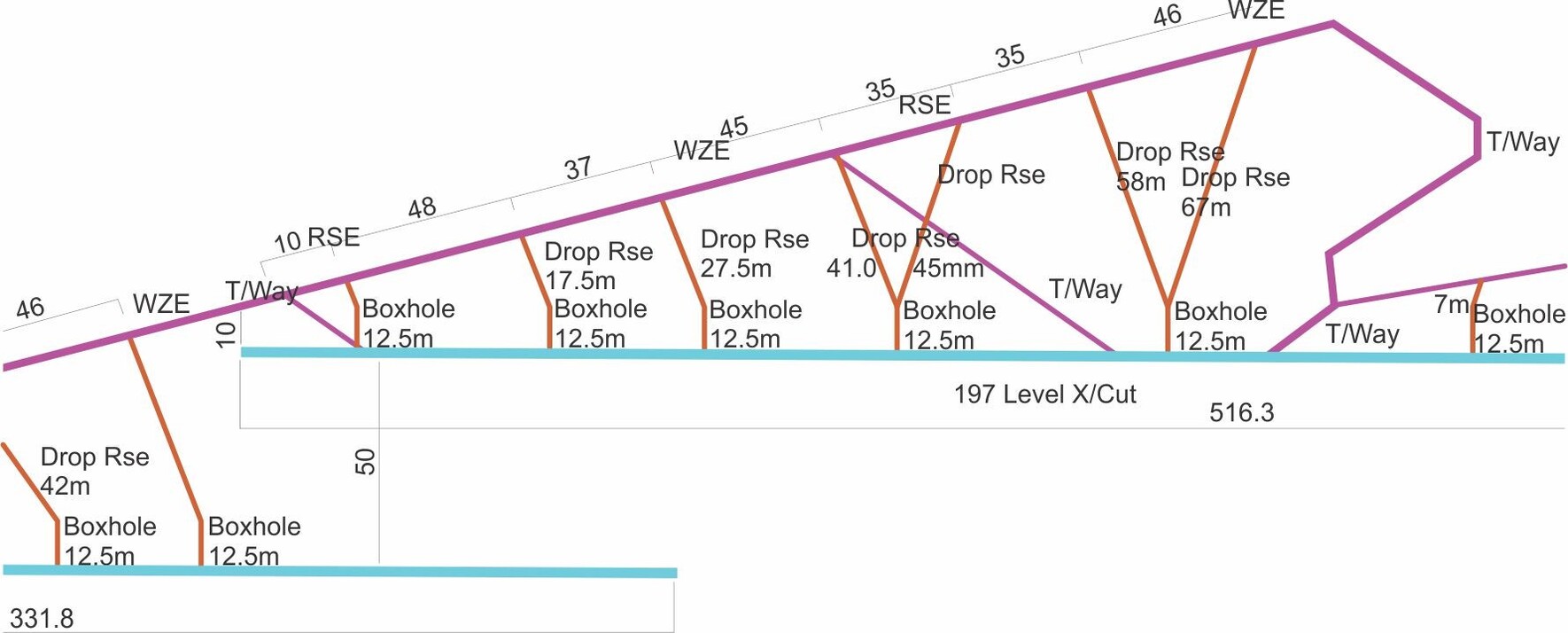
A mine design that is sufficiently informed with geological data is progressed to the mine planning phase. Mine planning is done on a macro scale as well as on a micro scale. On a macro scale, a regional cut-off grade is applied and the material below cut-off is excluded from the mining model. On a micro scale, the mining model is then subject to constraints that are applied because of the geotechnical design and other limitations.
At Doornkop, reefs are accessed through a vertical twin shaft system with a supporting sub-vent shaft. Section 15 provides more details of the surface and underground infrastructural layout supporting Doornkop’s mining operations. The critical working levels at Doornkop are between 192 level and 212 level.
Development is predominantly in the footwall and the access haulages are typically positioned 75m to 90m below the reef plane. The presence of large geological structures within the raise line can influence these footwall development positions. As part of primary development, a crosscut is developed in the direction of the mine workings. A plan view of a typical footwall crosscut is shown in Figure 13‑3.
A section view of the inclined secondary development, which is used to access the reef contact, and advanced from the position of respective crosscuts is presented in Figure 13‑3. Ore is extracted from stoping panels established from the inclined development. The typical stoping panel dimensions are a panel length of 27m and a stoping width on the South Reef of 1.23m.
Effective Date: June 30, 2024
Final Report Date: October 31, 2024
52
Technical Report Summary for
Doornkop Mine, Gauteng Province, South Africa
13.3Mine Design Parameters
Mine design is done internally by Harmony DeswikTM (Version 3) software. The geological models, and the geotechnical parameters formulated by the Rock Engineers, are used as a basis of the mine planning process. The mine design parameters are shown in Table 13-1. The stopes are mined from the centre raise line, one direction at a time, towards the stabilizing pillars (Figure 13-1). Additional support is provided using bracket pillars, to ensure safety around major geological features.
Table 13-1: Key Mine Design Parameters
| | | | | | | | |
| Parameter | Unit | South Reef |
| Regional Stability |
| Dip stabilizing pillar dimensions |
| Strike span | m | 15 |
| Dip span | m | 150-380 |
| Strike stability pillar spacing¹ | m | 130-180 |
| Access haulages middling to reef | m | 50-75 |
| Primary Development |
| Advance | m/month | 30 |
| Secondary Development |
| Advance | m/month | 18 |
| Economic Parameters |
| cmg/t | 500 |
Notes: 1. Pillar spacing is measured skin to skin.
13.4Mine Plan Development and Life of Mine Schedule
The SGM mining method is dependent on development staying ahead of the mining front, so that accurate geological information is gathered and included in final designs before mining commences. This also enables, planning and scheduling activities to be accurately sequenced, which leads to better planning, safer working conditions, and improved profitability.
The LOM plan and scheduling starts with the use of the planning model, which is modelled at a 500cmg/t cut-off grade. The mining rates used in determining the LOM plan are based on the current and expected operational performance, notwithstanding any unforeseen underground mining constraints. The remaining LOM for the operation is planned for 16 years, with a planned mining rate averaging at approximately 847ktpa (milled tons) over the LOM period. The extent of the Doornkop LOM plan is shown in Figure 13-4.
Effective Date: June 30, 2024
Final Report Date: October 31, 2024
53
Technical Report Summary for
Doornkop Mine, Gauteng Province, South Africa
Figure 13-4: Doornkop LOM Plan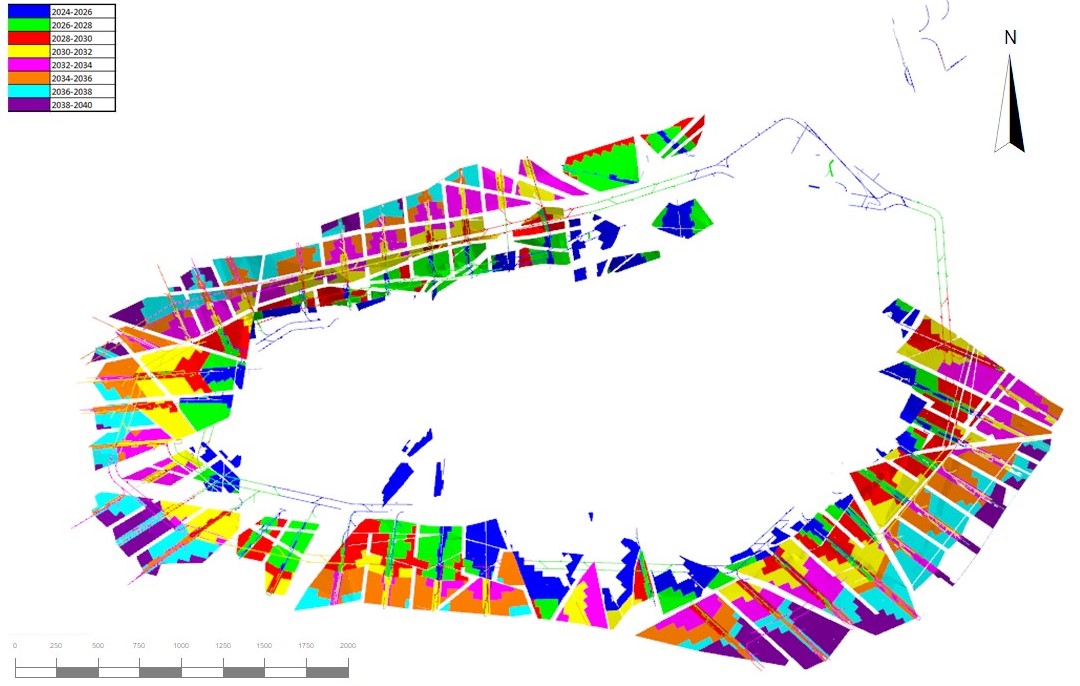
13.5Geotechnical and Geohydrological Considerations
Apart from the geotechnical risks that can be caused by the existence of geological structures and the presence of water and gas, there is also a seismicity risk at Doornkop due to the depth of the current mining operations. Doornkop maintains a network of seismic and geohydrological monitoring points. The geotechnical model takes the latest geological structural model and the selected mining method into account to design a suitable pillar layout.
The purpose of the pillar designs, regardless of the pillar type, is to customize them to the prevailing mining conditions, with the objective of making the mine design safe, practical, easy to implement, and profitable. These pillars include dip stabilizing-, bracket- and strike pillars. The details of the pillar design can be found in Table 13-1. The dimensions depicted for the pillars are standard and are adjusted depending on planned bracketing of geological structures, backfilling or in some circumstances, if patches of low value reef have been encountered. The Rock Engineers measure the release of seismic energy known as the energy release rate to establish backfilling support requirements and pillar design limits.
The geological structural model is also used to manage and monitor the occurrence of ground water and gas intersections at the mine. Doornkop has encountered water-bearing fissures and faults, as well as methane, in its mining history. There is always some risk associated with flooding and gas explosions at the mine, in the event of an unforeseen influx of uncontrolled water or gas, from within the mining operations or from neighbouring mining operations.
From a regional geohydrological perspective, Doornkop falls within the Zuurbekom compartment. Active pumping is continuously underway around the shaft via 3 wells to limit water ingress. However, limited water ingress does take place through mine workings, and the underground water is primarily associated with the NE-SW structures, in particular the Roodepoort, Saxon, Chevron and Doornkop Faults.
Cover drilling is also done ahead of development to identify water and gas intersections in advance. Apart from drilling, water is also identified during primary and secondary development. In the event of major water intersections, a water sealing plan is initiated. Most of the mining areas have been sealed off, and in some cases hoses and pipes are installed which diverts water to sumps, to be eventually pumped out to surface.
Methane gas pathways are identified during geological mapping and investigation of seismic data. Attributes based on structural interpretation, give rise to the identification and understanding of methane gas migration pathways. The identification of this structural architecture is critical for the mine as it provides a better understanding of these pathways. Any risks identified from the presence of gas is controlled though the use
Effective Date: June 30, 2024
Final Report Date: October 31, 2024
54
Technical Report Summary for
Doornkop Mine, Gauteng Province, South Africa
of Doornkop’s ventilation and refrigeration systems. The Geology department maintains detailed electronic records of all water and gas intersections at the operations.
Seismic monitoring is done using uniaxial and triaxial sensors, which measure seismic activity on surface and underground. The sensors are placed strategically based on Rock Engineering recommendations. In addition to the monitoring done through the systems that are in place, visual monitoring of the mining excavations is done by the Rock Engineering department, mainly focusing on the conditions of the pillars.
13.6Mining Operations
Doornkop has an extensive operational history and is operating within well-defined infrastructure. All ore is currently sourced from the South Reef and the mined ore is processed at Doornkop’s processing plant.
13.7Mining Rates
The Doornkop LOM is 16 years and includes mining of the South Reef only. The annual forecast tonnages and gold produced for the LOM is shown in Figure 13-5 and Figure 13-6, respectively.
13.8Mining Equipment and Machinery
Development and stoping operations at Doornkop require the following equipment:
•haulages and associated development is done with handheld drilling machines. The plan is to introduce hydro-powered (“HPE”) drill rigs for underground excavations and tunnelling in some of the development ends on 207 level;
•production drilling in stopes requires compressed air hand-held drills;
•hand held machines are used for the development of ventilation connections and ore passes with plans in place to migrate to manless mechanised drilling methods; and
•ore from the stoping ore passes is loaded directly into hoppers from box-front chutes. Waste rock from development operations is loaded into similar hoppers and both ore and waste is trammed to the shafts.
Figure 13-5: Graph of Doornkop Mineral Reserves - Tonnes and Grade
Effective Date: June 30, 2024
Final Report Date: October 31, 2024
55
Technical Report Summary for
Doornkop Mine, Gauteng Province, South Africa
Figure 13-6: Graph of Doornkop Mineral Reserves – Gold Produced (kg)
13.9Grade and Dilution Control
Broken ore grade control centres on the measurement of tonnage and grade through the ore flow, from the blasted stope to the delivery to the plant.
At Doornkop, Mine Surveyors measure stopes monthly. The Mine Surveyors are accompanied by Grade Control Officers, who assess the extent to which blasted material has been cleaned from the stope and identify any tonnage lock-ups. Follow up checks are done on previously identified and reported lock-ups, off-reef mining and areas where reef has been left in the footwall or hanging wall. On the monthly measuring day, all relevant information is extracted electronically in order for the necessary adjustments to be made to the grade and tonnage calculations.
13.10Ore transport
The blasted ore from the stoping panels is moved with winch-operated scrapers along gullies to ore passes where it gravitates down towards the loading boxes in the footwall cross-cuts below the stopes. The ore is discharged into rail hoppers and transported, via front-driven locomotives to dedicated inter-level transfer systems that gravity feed to the main silos which are from 207 to 212 Level. The ore is hoisted up the sub-vertical shaft and transferred to the main shaft rock system and silos. Once hoisted up the main vertical shaft to surface, the ore is transported to the processing plant via conveyor belt. The hoisting capacity is 130 000 tons per month.
13.11Mining Personnel
Doornkop is labour intensive. The mine is supported by approximately 3,037 mine-employed personnel and approximately 881 labour personnel are in direct production. The underground mining operations uses an 11-hour shift system, operating a 2-shift cycle per day. The mining personnel operating on this shift cycle, comprise of workers performing development, stoping, and other additional tasks. These personnel are sub-divided and organised into support, breaking (also referred to as drill and blast), and cleaning crews.
The supporting and breaking crew complete tasks during the day shift, while cleaning is done during the night shift. A development crew is responsible for one development end at a time. For the first year, Doornkop plans to achieve an average of 14,374m2 per month, with a crew complement of 54, or approximately 266m2 /crew/month.
Effective Date: June 30, 2024
Final Report Date: October 31, 2024
56
Technical Report Summary for
Doornkop Mine, Gauteng Province, South Africa
13.12Commentary on Mining Method
The SGM mining method employed by Doornkop is appropriate for the depth and levels of seismicity experienced at the operation. The mine design, planning and scheduling for the mine is developed using DeswikTM (Version 3) software, considering the geotechnical model and related parameters.
The main geotechnical and geohydrological risks include the presence of gas, ground water and seismicity, which are managed through the integrated monitoring systems, and incorporated into working mining models that inform daily mine planning decision-making.
The mining rates, machinery and equipment, ore transport, grade and dilution control, and labour resourcing and optimisation are driven by the mine schedule and continuous improvement initiatives on-site.
Effective Date: June 30, 2024
Final Report Date: October 31, 2024
57
Technical Report Summary for
Doornkop Mine, Gauteng Province, South Africa
14Processing and Recovery Methods
Section 229.601(b)(96)(iii)(B)(14) (i-iv)
Doornkop's gold processing facility has been in operation since the mid-1980s. The technology used to process the gold-bearing ore is well established and is suitable for the style of mineralisation. The plant has operated without significant challenges and target metallurgical recoveries have been achieved.
14.1Mineral Processing Description
All of the ore mined at Doornkop is treated and smelted at the Doornkop plant. The flowsheet is presented in Figure 14-1.
The ore is initially reduced in size by crushing followed by semi-autogenous (“SAG”) milling after which a conventional gold leach process (cyanidation), incorporating liquid oxygen injection is applied. The cyanidation process is one of the most common methods for the recovery of gold from auriferous ores. The use of cyanide leaching for gold recovery is based on gold’s properties, mainly its solubility in cyanide solutions.
Once the gold is dissolved into the cyanide solution it has a higher ability to adsorb (attach) onto activated carbon through the application of carbon in pulp (“CIP”) technology.
The loaded carbon then enters the elution columns, which are high pressure vessels that circulate the loaded carbon extracting the gold. The gold will “de-absorb” from the activated carbon and attach onto stainless-steel wool by means of electrowinning. The CIP circuit makes use of gravity flow of slime between the consecutive counter-flow stages in order to recover recirculate the activated carbon back into the system. Following this process, the cathode steel wool is smelted after drying in the calcining ovens. The bullion (gold) will then be dispatched to Rand Refinery for final refining, with silver as a by-product.
14.2Plant Throughput, Design, Equipment Characteristics and Specifications
The milled ore from Doornkop follows a standard cyanide leach, CIP and electrowinning process in order to extract the gold bullion. The key equipment specifications of the plant are provided in Table 14-1.
Table 14-1: Key Equipment Specifications at Doornkop Gold Plant
| | | | | | | | |
| Equipment | Unit | Capacity |
| Mill Silo (per silo – x no. silos) | Volume / silo (m3) | 1,875 |
| Tonnes | 3,000 |
| ROM Mill (per mill – 5 mills) | Volume / mill (m3) | 143 |
| Leach (10 leach tanks) | Dry tonnes / tank | 1,045 |
| CIP (13 tanks) | Volume / tank (m3) | 213 |
| Dry tonnes / tank (t) | 150 |
| Elution (2 tanks) | Volume / tank (m3) | 7 |
| Carbon (t) | 3 |
| Cycle time (hr) | AARL Process |
| Thickener (x thickeners) | ID (m) | 60 |
| Dry tonnes (tpm) | 200,000 |
The plant is currently operating below its designed throughput capacity and in the past has operated at the throughput required to deliver the forecasted ounces of gold in the LOM (Table 14-2).
Table 14-2: Design Throughput Versus Actual Throughput at Doornkop Gold Plant
| | | | | | | | |
| | Throughput |
| Equipment | Design (t/hr) | Actual (t/hr) |
| Mill | 70 | 70 |
| Leach | 340 | 180 |
| CIP | 340 | 180 |
| Thickener | 340 | 180 |
Effective Date: June 30, 2024
Final Report Date: October 31, 2024
58
Technical Report Summary for
Doornkop Mine, Gauteng Province, South Africa
Figure 14-1: Schematic Flow Diagram of the Metallurgical Process
The cyanide leach is an intricate balance of time, pH and oxygen sparging. These parameters have been determined with metallurgical test work and historical performance to optimise the recovery. The parameters used in this process are set out in Table 14-3.
Effective Date: June 30, 2024
Final Report Date: October 31, 2024
59
Technical Report Summary for
Doornkop Mine, Gauteng Province, South Africa
Table 14-3: Leaching process material and properties
| | | | | |
| Process Requirements | Properties |
| pH | 10.5 - 11.5 (controlled by lime addition) |
| Cyanide | 180 - 250ppm as 100% NaCN |
| Leaching Time | 24 - 40 hours |
| Oxygen | Air sparged |
| Cyanide Relative Density | 1.00-1.10, 28-34% by mass |
14.3Energy, Water, Process Material and Personnel Requirements
The processing plant requires the following consumables are presented in Table 14-4:
Table 14-4: Reagent consumption
| | | | | | | | |
| Equipment | Unit | Value |
| Steel Balls | tpm | 45.0 |
| Lime | tpm | 120.0 |
| Flocculant | tpm | 0.3 |
| Cyanide | tpm | 36.0 |
| Carbon | tpm | 4.4 |
The Doornkop Plant requires approximately 52,000MWh per annum of electricity, 130kL of water per annum, and has approximately 149 employees. All reagents above are currently being utilised in the plant and are sourced in South Africa.
14.4Commentary on the Processing and Recovery Methods
The metallurgical process is a well-tested technology which has been in operation at the mine since 1986. The recoveries used in the business plan were based on historic performance. The methodology applied considered the historical metallurgical recovery (18-month period) for the relevant ore source. The actual monthly head grades were reviewed and the relationship between the head grade and recovery were used as base for the Business Plan (“BP”) 2023/24 metallurgical recoveries, taking into consideration the relevant forecast head grades (Figure 14-2).
Effective Date: June 30, 2024
Final Report Date: October 31, 2024
60
Technical Report Summary for
Doornkop Mine, Gauteng Province, South Africa
Figure 14-2: South Reef Historical Plant Recovery
Effective Date: June 30, 2024
Final Report Date: October 31, 2024
61
Technical Report Summary for
Doornkop Mine, Gauteng Province, South Africa
15Infrastructure
Section 229.601(b)(96)(iii)(B)(15)
Doornkop is an established operation, and the currently available infrastructure is sufficient to support the mine plan. Doornkop is accessible via the national and provincial roads (Figure 3-1). The general layout of Doornkop infrastructure is presented in Figure 15-1. Google Earth images are provided of the shaft area and plant in Figure 15-2 and Figure 15-3, respectively.
15.1Surface Infrastructure
The infrastructural layout includes hauling and hoisting facilities (shaft); logistical support for core handling, sampling, and transporting; a mineral processing plant; ore and waste facilities; tailings infrastructure; roads; water and power supply; ventilation and refrigeration systems; stores and workshop support; electrical supply; offices; housing and security.
15.1.1Ore and Waste Rock Storage Facilities
The gold bearing ore Doornkop is processed at the mineral processing plant (Figure 15-3). There are two ROM ore storage silos on surface, with a combined capacity of 5,600t.
Waste was previously transported and deposited on the rock waste dump located adjacent to the plant (Figure 15-3) however at present, waste mining at Doornkop is relatively modest, and the waste is treated by the plant.
15.1.2Tailings Storage Facilities
The tailings storage facility (“TSF”) is located north of Doornkop (Figure 15-1). The TSF is currently active and is owned and operated by Doornkop. All waste material from the mineral processing activities is accumulated at this TSF.
The current design capacity of the TSF - (In Cubic Meters) is 74.1mil m3 with a maximum height of 60m. Currently the TSF is at 40.6m height, or 51.6mil m3 . From the 2022 life assessment the estimated final height will be 52.1m engineered using an upstream raising method with a planned utilisation ending in 2038.
The remaining capacity from the current TSF basin elevation to the final elevation in December 2038 is 12.8mil m3. An acceptable rate of rise is 2m/annum with the actual achieved rate in 2022 being 0.652m.
An analysis of the downstream impact on communities, ecosystems, and critical infrastructure in the event of catastrophic failure is complete. A closure plan, typically extending over a 2-year period, to assess the TSF against the impact of extreme weather events because of climate change is also in place. The facility has never failed stability certifications and has no notable stability concerns. There is also a long-term monitoring and closure plan in progress. The TSF adheres to the SANS 10286 governed classification system and is monitored by internal engineers, supported by external engineering specialists.
15.1.3Power and Electrical
Electricity is sourced from Eskom, and the annual power consumption is in the order of 200GWhr. Doornkop power supply is designed to satisfy the planned LOM production and service requirements. The main power supply is managed and distributed via electrical sub-stations located on site.
15.1.4Water Usage
Doornkop has a sufficient supply of water from underground sources as well as Rand Water and recycled water to support mining and processing activities for the LOM. Water usage per annum is approximately 700ML.
15.1.5Logistics and Supplies
The procurement of supplies and equipment are handled centrally, via Harmony, and then delivered to Doornkop.
Effective Date: June 30, 2024
Final Report Date: October 31, 2024
62
Technical Report Summary for
Doornkop Mine, Gauteng Province, South Africa
Figure 15-1: Doornkop Surface Mine Layout and Infrastructure
Effective Date: June 30, 2024
Final Report Date: October 31, 2024
63
Technical Report Summary for
Doornkop Mine, Gauteng Province, South Africa
Figure 15-2: Doornkop Surface Infrastructure
Google Earth Image Date April 2023
Effective Date: June 30, 2024
Final Report Date: October 31, 2024
64
Technical Report Summary for
Doornkop Mine, Gauteng Province, South Africa
Figure 15-3: Doornkop Processing Plant
Google Earth Image Date April 2023
Effective Date: June 30, 2024
Final Report Date: October 31, 2024
65
Technical Report Summary for
Doornkop Mine, Gauteng Province, South Africa
15.2Shaft and underground infrastructure
The existing shaft headgear is photographed in Figure 15-2, whilst the underground infrastructure used to access the reef is schematically presented in Figure 15-4.
The underground workings are accessed and mined via a Main and Vent Shaft, and a Sub-Vent Shaft. The Main Shaft extends from surface to 212 level, while the Vent Shaft extends from surface to 106 level. The Sub-Vent Shaft extends from 96 level to 212 level.
Currently production occurs between 192 level and 212 level, and access is provided by either the Main Shaft or the Sub-Vent Shaft.
All movement is systematically facilitated by respective man and material tramming sections. Underground broken rock handling is track-bound via locomotive material cars. These movements are supported by traffic management systems, including control room monitoring, decline logistics control, etc. Rock is transferred via gravity feed to the main silo infrastructure, located on 212 level. Rock is hoisted from 212 level to surface via the Main Shaft.
15.3Commentary on Infrastructure
The operational infrastructure including road, rail, offices, security services, water and power supply is adequate. Doornkop is well-established with sufficient logistical and infrastructure support for the existing and planned mining operations.
The “Property, Plant, and Equipment” as of June 30, 2024, including buildings and mine infrastructure, mining assets, rehabilitation and assets under construction, had a carrying value of R3,924 million.
Effective Date: June 30, 2024
Final Report Date: October 31, 2024
66
Technical Report Summary for
Doornkop Mine, Gauteng Province, South Africa
| | |
Figure 15-4: Doornkop Schematic of Mine Shaft and Underground Infrastructure |
Effective Date: June 30, 2024
Final Report Date: October 31, 2024
67
Technical Report Summary for
Doornkop Mine, Gauteng Province, South Africa
16Market Studies
Section 229.601(b)(96)(iii)(B)(16) (i-ii)
Gold is traded in a variety of markets/exchanges both in physical form through over the counter (“OTC”) markets, bullion banks and metal exchanges etc., and through passive investments such as exchange traded funds (“ETF’s”), which are based on gold prices and units representing physical gold which may be in paper or dematerialized form. Demand is driven by the jewellery market, bar and coin, use in technology, ETF’s and other financial products, and by central banks. An overview of the gold market is given in the following sections based mainly on data from the World Gold Council and GoldHub websites.
16.1Market Overview
Unlike almost all mineral commodities, the gold market does not respond the same way to typical supply and demand dynamics which are founded on availability and consumption, but rather on global economic affairs, particular those of the major nations, industrial powerhouses and economic regions, such as the Eurozone. The gold market is affected by government and central bank policies, changes in interest rates, inflationary or deflationary environments and events such as stocking and de-stocking of central reserves. It is also largely affected by global events such as financial crises, geopolitical trade tensions and other geopolitical risks.
Annual global gold demand (excl. over-the-counter demand (OTC) and other) experienced a decline of 5.0% on an annual basis, totalling 4 448.4 tonnes in 2023 when compared to the 4 699.0 tonnes recorded in 2022. The fourth quarter of 2023 recorded an average gold demand (excl. OTC and other) of 1 149.8 tonnes, 8.0% above the average recorded over the last five years. However, when compared to the fourth quarter of 2022, gold demand declined by a substantial 12.0%.
The main contributing factors of the higher gold demand during the third quarter of 2023 include:
•Jewellery consumption was 1.0% lower when compared to the same quarter in 2022, whilst jewellery inventory recorded a significant decrease of 29.0% in 2023 when compared to 2022. Furthermore, jewellery fabrication in the fourth quarter of 2023 was 3.0% lower compared to the same period in 2022.
•Bar and coin demand in the final quarter of 2023 was 7.0% lower on an annual basis at 313.8 tonnes, reflecting weak sentiment among some investor segments. Furthermore, official coins decreased by a notable 30.0% in the fourth quarter of 2023 when compared to the same quarter a year ago.
•Central Banks and other institutions invested 229.4 tonnes of gold in the fourth quarter of 2023, recording a drastic decline of 40.0% when compared to the 382.1 tonnes investment recorded in the fourth quarter of 2022.
Although bullion prices recently surged to record highs, the first quarter of 2024 also witnessed significant gold demand, driven by sizable OTC demand.
16.2Global Production and Supply
Total Gold supply was 3.0% higher in 2023 when compared to 2022, similar to the annual supply growth of 3.0% witnessed in the first quarter of 2024 when compared to the first quarter of 2023. Gold production and supply are sourced from existing mining operations, new mines and recycling.
16.2.1New Mine Production
Gold supply from mine production exhibited an annual increase of 1.0% in 2023, amounting to 3 644.4 tonnes, but remained just below the highest output recorded in 2018. In the fourth quarter of 2023, mine production of gold decreased by 2.0% when compared to the corresponding quarter of 2022. However, moving into the first quarter of 2024 mine production increased by 4.0% year-on-year, reaching 893.0 tonnes, though, still lower when compared to the 939.9 tonnes produced in the previous quarter. The upward trend in mine production over the past two years can primarily be attributed to an uninterrupted mining industry.
According to the WGC, preliminary data indicated notable increases in gold mine production in the first quarter of 2024 for Canada (16.0% y-o-y); Ghana (15.0% y-o-y); Indonesia (14.0% y-o-y) and China (5.0%
y-o-y).
Effective Date: June 30, 2024
Final Report Date: October 31, 2024
68
Technical Report Summary for
Doornkop Mine, Gauteng Province, South Africa
In 2023, China remained the largest gold producer in the world (378.2t), followed by the Russian Federation (321.8t), Australia (293.8t), Canada (191.9t), United States (166.7t), Ghana (135.1t), Indonesia (132.5t), Peru (128.8t), Mexico (126.6t), Uzbekistan (119.6t) and Mali (105.0t). South Africa produced 104.3t in 2023; higher when compared to the 92.6t produced in 2022.
Figure 16-1 World Gold Council: Mine Production - Major producing Gold Countries ranked by 2023
Source: ETSA & World Gold Council, 2024
16.2.2Recycling
The global annual supply of recycled gold increased by 9.0% in 2023 to reach 1 237.3 tonnes when compared to 2022, but still remained below the 1 293.0 tonnes recorded in 2020 and below the all-time high recorded in 2009. The rise in supply was encouraged by higher prices, resulting in a 12.0% surge in recycled gold during the first quarter of 2024 when compared to the same period in 2023. This marked the strongest quarterly performance since the third quarter of 2020 and the strongest first-quarter supply volume since 2014. Notably, East Asia recorded the most significant increase among all regions, primarily driven by volume increases in China.
16.3Global Consumption and Demand
During first quarter of 2024, gold demand (excl. OTC and other) reached 1 101.8 tonnes, reflecting a decrease of 5.0% compared to the same quarter the previous year. However, when including OTC and other, total demand increased by 3.0% on an annual basis in the first quarter of 2024 to reach 1 238.3 tonnes; resulting in the strongest first quarter since 2016. Furthermore, demand from central banks buying gold was also high during the first quarter of 2024.
16.3.1Jewellery
Global jewellery consumption experienced a significant quarter-on-quarter decline of 23.2% during the first quarter of 2024, dropping from 623.5 tonnes in the fourth quarter of 2023 to 479.0 tonnes in the first quarter of 2024. In China, demand for gold jewellery decreased by 6.0% in the first quarter of 2024 when compared to the same period in the previous year, while demand from India increased by 4.0%, supported by a robust macroeconomic environment that supported gold consumption. However, despite the first quarter initially commencing with increased demand, investor appetite for bullion tapered off towards the end of the quarter due to a price rally in March 2024 and continued to remain under pressure entering the second quarter of 2024.
Effective Date: June 30, 2024
Final Report Date: October 31, 2024
69
Technical Report Summary for
Doornkop Mine, Gauteng Province, South Africa
16.3.2Investment
A total annual gold investment demand of 940.7 tonnes was recorded by the World Gold Council (WGC) for 2023, reflecting a 15.0% decrease from the 1 112.8 tonnes recorded in 2022. In the first quarter of 2024, investment in gold (excluding OTC) was significantly lower and recorded a 28.0% year-on-year decline, reaching 198.6 tonnes, down from 275.3 tonnes recorded in the first quarter of 2023 and also lower when compared to the 257.1 tonnes recorded in the fourth quarter of 2023. Despite the decline, long positions of fund managers reached a two-year peak in March 2024 which was supported by the gold price rally, however, gold exchange-traded funds (ETF) holdings decreased by 113.7 tonnes (USD6.0 billion) on a quarterly basis during the first quarter of 2024. Furthermore, global physically-backed gold ETFs were 10.0% lower on an annual basis amounting to 3 112.4 tonnes globally during the first quarter of 2024. Market divergence was evident as Asia had positive demand growth for physically backed ETFs while the Western investors focused on profit-taking.
According to the WGC, global bar and coin investment increased by 3.0% when compared to the first quarter of 2023, reaching an average of 312.3 tonnes in the first three months of 2024.
The average London Bullion Market Association (LBMA) price of gold traded 10.0% higher in the first quarter of 2024 when compared to the same period a year ago, at USD2 069.80 an ounce, which also represented a 5.0% quarter-on-quarter increase that can be ascribed to risk and momentum factors.
Figure 16-2 World Gold Council: Total Gold Supply & Demand
16.3.3Currency
The inverse relationship between the value of U.S. Dollar (USD) and that of gold is one of the most discussed relationships in currency markets. The USD is the internationally accepted currency and most of the international transactions take place in USD equivalent. The major reason behind the relationship of gold and the USD, is that gold is used as a hedge against the adverse exchange value of the USD. As the US Dollar’s exchange value decreases, it takes more USD to buy gold, which increases the value of gold. Two other factors linked to the USD, or the strength of the USD is inflation and interest rates.
Interest rates have remained high whilst inflation started retreating in 2024. The USD is forecast to lose some strength as U.S. interest rate cuts are nearing inevitably and the currency depreciated in May 2024, for the first time in five months. Furthermore, global economic growth and lower risk also place pressure on the US Dollar. Central banks are planning to start with interest rate cuts, which in turn could cause non-yielding bullion to become more attractive and result in further increases in the gold price.
Effective Date: June 30, 2024
Final Report Date: October 31, 2024
70
Technical Report Summary for
Doornkop Mine, Gauteng Province, South Africa
16.4Gold Price
16.4.1Historical Gold Price
The LBMA gold price reached a record annual average price of USD1 940.54 an ounce in 2023, 8.0% higher when compared to average of USD1 800.09 an ounce recorded in 2022. The upward trajectory continued into the first quarter of 2024 where gold prices averaged 5.0% higher at USD2 069.80 an ounce on a quarter-on-quarter basis.
Moving into the second quarter of 2024, gold prices continued to gain a lot of momentum which can mainly be attributed to the ongoing geopolitical tensions in the Middle East, along with central bank hedge purchasing and uncertainty surrounding global inflation. The safe-haven appeal of gold drove a bullish market with bullion prices reaching new record highs after increasing by roughly 18.0% between March 1, 2024 and April 12, 2024.
The bullish price trend for bullion could increase recycling supply of gold and decrease jewellery demand, whilst mine supply is also expected to reach a new peak. The latest market expectations point to U.S. interest rates staying higher for longer as the U.S. Federal Reserve Bank awaits assurance that inflation is returning to the central bank’s target of 2.0%. Bullion acts as a hedge against lower interest rates and the price is anticipated to increase later in 2024 when interest rates are lowered.
Figure 16-3: World Gold Council: Daily Gold Price (ZAR/oz & USD/oz)
16.4.2Forecast Gold Price
Consensus gold price range for the year 2024 to year 2026 is presented in Table 16.1. The long-term gold prices are considered from year 2025 onwards by the QP. Forecasts as advised from various financial institutions show that gold is expected to trade in a range of USD1,600/oz – USD2,238/oz, for the period 2024 to 2026 with a long-term outlook of USD1,772/oz.
Effective Date: June 30, 2024
Final Report Date: October 31, 2024
71
Technical Report Summary for
Doornkop Mine, Gauteng Province, South Africa
Table 16-1 Consensus View of Forecast Gold Price
| | | | | | | | | | | |
| Institutions | 2024 | 2025 | 2026 |
| World Bank: Development | 2,100 | | 2,050 | | — | |
| BMO Capital Markets | 2,150 | | 2,100 | | — | |
| Scotiabank | 2,018 | | 1,950 | | — | |
| Nedbank | 2,211 | | 2,238 | | 2,210 | |
| Fitch Solutions | 1,900 | | 1,800 | | 1,600 | |
| S&P Global | 2,120 | | 2,134 | | 2,076 | |
| Australian Government | 2,023 | | 2,030 | | 1,924 | |
| Average | 2,075 | | 2,043 | | 1,953 | |
16.4.3Harmony Group Gold Hedging Policy
Harmony has a hedging policy which is managed and executed at Group treasury level on-behalf of its operating entities. The key features of the hedging program are as follows:
•the policy provides for hedging (or forward selling) up to a maximum of 20% of expected gold production for a rolling 24-month period;
◦Year 1, 30%
◦Year 2, 20%
◦Year 3, 10%
•the policy has no minimum quantity that should be hedged, and if an attractive margin above cost cannot be achieved (i.e., in a low gold price environment) then no hedges are entered into;
•Harmony enters into ZAR-denominated gold hedges for its South African operations (for the non-South African assets it enters into USD-denominated hedges);
•Individual mines do not enter into hedges in their own name but delivers bullion to Rand Refinery for refining on behalf of Harmony. Rand Refinery is one of the world’s largest single-site precious metals refining and smelting complex in the world. Rand Refinery refine all of Harmony’s gold to at least 99.5% purity, and acting as agent, sells the gold on the daily spot London fixing price and make payment to the Harmony two days later;
•gains and losses realised from the hedging program are accounted for at Group level and the financial benefit (or downside) is distributed amongst the operations proportional to their levels of gold sales; and
•Harmony does its mine planning and financial forecasts based on the estimated future gold price provided by an external source (ETSA), but its year-end actual financial results reflect the received gold price inclusive of the impact of the hedging programme. Therefore, in theory, individual mines receive a hedged gold price for a maximum of 20% of its gold sales with the balance attracting the spot price.
16.5Commentary on Market Studies
The factors which affect the global gold market are well-documented as are the elements which influence the daily gold price. The LBMA gold price reached a record annual average price of US$1 940.54 an ounce in 2023, 8.0% higher when compared to average of US$1 800.09 an ounce recorded in 2022. The upward trajectory continued into the first quarter of 2024 where gold prices averaged 5.0% higher at US$2 069.80 an ounce on a quarter-on-quarter basis. The gold price remains well above the 5-year historical average.
The positive outlook for gold will likely be sustained. Key headwinds for gold are interest rate hikes, currently at near historically low levels, but continued geopolitical risk and underperformance of stocks and bonds will support gold (Gold Mid-Year Outlook 2022, Gold.org, Accessed 2022).
Harmony has a relatively conservative gold hedging policy in place, and this is used to take advantage of the movements in the gold price to maximize the average gold price received, with the benefit of this hedging program flowing through to Doornkop mining operations.
Effective Date: June 30, 2024
Final Report Date: October 31, 2024
72
Technical Report Summary for
Doornkop Mine, Gauteng Province, South Africa
16.6Material Contracts
As with all major businesses, Harmony and Doornkop enters into a multitude of vendor agreements for the provisions of supplies and services. These agreements are entered into on a competitive basis and typically are of a medium-term duration all with clauses providing for periodic updating of pricing, annual (or other) renewal or termination.
Harmony has contractual vendor agreements with various service providers and suppliers. The most significant of these contracts currently in place to support the Doornkop are listed in Table 16-1.
All of the listed contracts are currently valid and in good standing. Terms, rates and charges of contracts are considered consistent with industry norms. Contract management processes are in place and resourced so that contracts re-tendered and/or renewed as they approach expiry.
Table 16‑1: Material Contracts
| | | | | | | | | | | | | | | | | | | | |
| Vendor Name | Nature of Service / Supply | Contract Number | Annual Value (ZARm) | Duration | Price Adjustment Mechanism | Termination Mechanism |
| Tychoflash | Underground secondary support services | REL/24/03/0053 | 47 | | 3 Yrs | Annually | 30 Days |
| Tychoflash | Rail Upgrade & Maintenance | REL/22/03/0053 & REL/19/11/0057 | 46 | | 5 Yrs | Annually | 30 Days |
| Bidvest Protea Coin Security | Asset Protection | CS/17/11/0001-2 | 15 | | 3 Yrs | Annually | 30 Days |
| GMG | Semi -Trackless and Trackless Development | REL/23/12/0022 | 13 | | 3 Yrs | Annually | 30 Days |
| Rosond | Exploration Drilling | REL/19/08/0011-2 | 30 | | 3 Yrs | Annually | 30 Days |
Effective Date: June 30, 2024
Final Report Date: October 31, 2024
73
Technical Report Summary for
Doornkop Mine, Gauteng Province, South Africa
17Environmental Studies, Permitting and Plans, Negotiations, or Agreements with Local Individuals or Groups
Section 229.601(b)(96)(iii)(B)(17) (i-vii)
The South African Government has an extensive legal framework within which mining, environmental and social aspects are managed. Harmony and its Doornkop operation is primarily regulated and managed by certain principal Acts (Section 17.3) as well as corporate policies, management systems and certain industry wide guidelines, including:
•Energy Efficiency and Climate Change Policy;
•Environmental Policy;
•Harmony Water Management Strategy;
•Biodiversity and Rehabilitation Position Statement;
•Socio-Economic Transformation Policy; and
•Corporate Social Responsibility Policy.
The latest sustainability policies and public Environmental Social and Governance (“ESG”) performance and disclosure reports are available on the corporate website. Harmony has identified the environmental risks for the business and has strategies in place to manage the risks.
17.1Results of Environmental Studies
Doornkop has prepared multiple environmental impact assessments (“EIA”) for regulatory which, under the current legal framework, require stakeholder engagement. One of the specialist studies undertaken at the operation was a cultural and heritage resources surveys in 2009. The study was used to identify sites of cultural importance within the mining lease area. A graveyard was identified as an important cultural and heritage resource which required the area to be fenced off to prevent any damage from mining and community activities.
Harmony is committed to maintaining good relationships with regulatory authorities, industries, communities, business partners and surrounding stakeholders. Harmony is committed to maintaining good relationships with regulatory authorities, industries, communities, business partners and surrounding stakeholders. A detailed environmental impact register has been developed to identify all potential environmental impact of the operations. The main impacts were rated, and mitigation measures were proposed to minimise their impact on environment.
17.2Waste and Tailings Disposal, Monitoring & Water Management
The process of mining and beneficiation produce significant waste, typically consisting of:
•solid waste in the form of waste rock and overburden;
•liquid wastes in the form of wastewater and tailings slurry; and
•gaseous emissions such as liquefied petroleum gas.
Measures have been put in place for the handling and disposal of all hazardous chemicals (e.g. cyanide), hydrocarbons (i.e. hydraulic oils and diesel) and other chemicals to ensure the protection of human health and its potential impact on the environment. Harmony recognises that responsible and effective waste management can positively reduce its environmental impacts and mitigate associated environmental liabilities. Waste management is thus a priority focus area. Internally, guidelines on mineral, non-mineral and hazardous waste materials are included in the environmental management systems (“EMS”) implemented at Doornkop
Tailings comprises of crushed rock and process water emitted from the gold elution process in the form of slurry once gold has been extracted. As tailings contain impurities and pollutants, they are placed in TSF engineered to contain them, in line with Harmony's tailings management programme and the Global Industry Standard on Tailings Management ("GISTM").
Effective Date: June 30, 2024
Final Report Date: October 31, 2024
74
Technical Report Summary for
Doornkop Mine, Gauteng Province, South Africa
Harmony's overall tailings management strategy is to ensure robust, meticulous engineering and dam design, along with a continual focus on management of risks through layered assurance and oversight. The focus areas include, but are not limited to:
•freeboard control;
•water management;
•maintaining stability and the safety factor as advised by the engineer of record;
•erosion controls; and
•monitoring and control measures implemented to ensure continued compliance (including regular inspections, audits, and meetings on varying intervals with subsequent actions, minutes and reports).
As part of its mining, environmental and water approvals and licences, Harmony is required to implement monitoring programmes and plans to establish the operations impact on the environment. The compliance limits for the monitoring variable are included in the applicable EMPRs, WULs and environmental authorisations. The environmental monitoring implemented at Doornkop includes:
•ground and surface water monitoring;
•biodiversity monitoring;
•mentoring the ecological health Klipriver;
•waste classification and quantification;
•integrated waste and water management plan updates;
•water balance reviews;
•licence and authorisation compliance reviews; and
•air quality (i.e. noise and dust) and greenhouse gas emissions ("GHG") monitoring.
Doornkop has implemented Harmony’s corporate water management standard which applies to water in the entire mining lifecycle, including prospecting, project design and commissioning, operation and closure. The objective of the standard is to improve the efficiency of water use in the entire mining life cycle and reduce the demand on natural and municipal water supply. One the measures in place is the treatment of underground fissure water at a reverse osmosis plant to potable standard. The treated water is used as drinking water quality at the mine offices, hostels, medical hubs and at the cheese factory. The quality of this water is monitored on a daily basis to ensure compliance to SANS 241 drinking water quality standard. Back wash water is pumped to gold plant for use in metallurgical processes.
17.3Permitting and Licences
In respect of environment, the following national Acts and the regulations promulgated thereunder provide the regulatory framework for mine permitting and licencing in South Africa:
•Mineral and Petroleum Resources Development Act, 2002 (“MPRDA”);
•National Environmental Management Act, 1998 (“NEMA”);
•National Environmental Management: Waste Act, 2008 (“NEM:WA”);
•National Environmental Management: Air Quality Act, 2004 (“NEM:AQA”); and
•National Water Act, 1998 (“NWA”).
In line with MPRDA, Doornkop has an approved EMPR that formed part of the mining right application and is used as the basis for managing all environmental aspect/impacts at operation. Doornkop has all other environmental permits are in place required that cover the environmental, archaeological, waste and hydrological components of the operations. A summary of the status of environmental permits issued is presented in Table 17-1.
Effective Date: June 30, 2024
Final Report Date: October 31, 2024
75
Technical Report Summary for
Doornkop Mine, Gauteng Province, South Africa
Table 17-1: Status of Environmental Permits and Licences
| | | | | | | | | | | | | | |
| Permit / Licence | Reference No. | Issued By | Date Granted | Validity |
| Environmental Management Programme Report (“EMPr”) | GP30/5/1/2/2/(09) EM | DMRE | June 7, 2010 | LOM |
| Certificate of Registration (Nuclear) | 01/0025/06 | National Nuclear Regulator | May 31, 2003 | LOM |
| Water Use Permit | 33/2/323/24 | DWS | December 1, 1977 | LOM |
| Integrated WUL (Draft) | 16/2/7/C221/C024 | DWS | January 1, 2010 | LOM |
| ISO 14001 Certification | 631282 | BSI | November 1, 2021 | November 1, 2024 |
| Cyanide Management Certification | N/A | ICMC | April 1, 2021 | April 1, 2024 |
| Precious Metal Refining Licence | 1889/000251/66 | SA Diamond & Precious Metals Regulator | June 1, 2011 | June 1, 2041 |
| Environmental Authorisation for Water Treatment Plant | GP30/5/1/2/2/(09) EM | DMRE | August 1, 2016 | LOM |
| License to impound water in a dam with Safety risk | 12/2/C221/69 | DWS | July 17, 2009 | LOM |
Notes: DMRE - Department of Mineral Resources and Energy, DWS - Department of Water and Sanitation, BSI - British Standard Institute, ICMC-International Cyanide Management Code
There are applications submitted or being considered by the relevant authorities to ensure compliance and alignment with operations LOM requirements. To this end, applications have been submitted to amend the existing EMPR and are awaiting approval from the regulator at the effective date of this TRS.
A compliance assessment is required to be undertaken against the conditions of the EMPR every second year by an independent party and the report is submitted to the regulator. The audit conducted for the year 2019/20 indicates that Harmony’s Doornkop operation obtained a total compliance score of 94.31% for the audit. All permits are audited regularly for compliance and no material risks to the operations have been identified. An online Doornkop environmental legal register, available at www.drayer-legal.co.za, is used to monitor compliance and to obtain relevant legal environmental updates for the operation to ensure compliance.
In addition, Doornkop operation is both certified in terms of ISO 14001:2015 standard and by the International Cyanide Management Institute in terms of the cyanide management code. As required by both the ISO14001 standard and cyanide management code, every effort is made to either eliminate or minimize the impacts of mining activities on the environment and surrounding communities.
17.4Local Stakeholder Plans and Agreements
Harmony strives to create sustainable shared value within the communities it operates. Local stakeholder plans and agreements are based on the results from socio-economic information, government development strategies and EIAs undertaken. The socio-economic development programme commits to:
•contribute to areas that will have the most meaningful socioeconomic impact on communities, namely infrastructure, education and skills development, job creation and entrepreneurial development;
•enhance broad-based local and community economic empowerment and enterprise development initiatives;
•facilitate socio-economic development in local communities by means of Social and Labour Plans (“SLPs”) and corporate social responsibility programmes;
•support arts, culture, and sports and recreation; and
•build relationships based on trust within host communities.
In South Africa, mining companies are required to have a SLP which forms an important component of Harmony's community investment plan. It sets out the Company’s obligation to develop and implement
Effective Date: June 30, 2024
Final Report Date: October 31, 2024
76
Technical Report Summary for
Doornkop Mine, Gauteng Province, South Africa
comprehensive human resource development programs, community development plans, housing and living condition plans and employment equity plans.
The ultimate aim of the SLP is to ensure the uplift of the social and economic circumstances of local communities surrounding the mine and are a prerequisite to securing and maintaining a mining right, with progress required to be reported each year. Implementation of the SLP is the responsibility of the General Manager and the Human Resources Leader at the operation. Harmony has budgeted to spend a total of ZAR19.8m in the next financial year to meet its SLP commitments. Of this amount, ZAR13.9m will be for mine community development.
17.5Mine Closure Plans
Harmony makes provision for closure and rehabilitation both for accounting purposes and as required under the MPRDA. The statutory obligation for all environmental rehabilitation at Doornkop is administered by the DMRE and requires the preparation of a closure plan, the development of a cost estimate, and financial assurance. The Company makes an annual submission to the DMRE setting out the cost of closure in accordance with the MPRDA and the regulations issued thereunder.
Harmony appointed Digby Wells Environmental, independent environmental consultants, to review and update the Closure Cost Assessment for unscheduled closure associated with the Doornkop Mining Operations. The Doornkop Mining Operations is a Harmony operation, located south of Krugersdorp, 30km west of Johannesburg, in Gauteng Province, South Africa. The mine closure assessment was done in terms of regulation 53 and 54 of the MPRDA and in accordance with the requirements of NEMA. The cost of closure must be determined and updated during the LOM and the financial provision made in accordance with the estimated closure cost and the predicted LOM. The closure cost, as at June 30, 2024, was calculated to be ZAR119m including a 10% contingency allowance.
As per Digby Wells, the closure rehabilitation can be summarised as follows:
Infrastructure, steel, concrete and brick will be removed (between 0.3 and 1.5 m below ground level depending on the depth of the concrete structure) and be used to backfill the shafts and the areas will be restored to support the post closure land capabilities as far as practical possible and as agreed with the authorities and stakeholders;
•All power and water services to be disconnected and certified as safe prior to commencement of any demolition works;
•Salvageable equipment may be removed and transported off-site prior to the commencement of demolition;
•All fittings, fixtures and equipment within buildings may be dismantled and removed to designated temporary disposal yards;
•All above-ground electrical, water and other service infrastructure and equipment to be stored in the designated temporary salvage yards;
•All excavations resulting from demolition of plant, buildings, roads, conveyor platforms, etc. and earth structures must be left in a safe manner;
•Keep to designated roads/areas and prevent access of people/machinery/vehicles/grazing animals on newly rehabilitated land to allow regeneration of vegetation and reduce erosion;
•Ensure that land clearing and rehabilitation activities remain within designated footprint areas and do not damage areas still considered natural; and
•All contaminated infrastructure/material must be disposed of at a licenced waste facility.
Harmony is required to make funding available in an amount equal to the cost of closure as determined under the MPRDA in the form of a trust fund and/or bank guarantees.
Effective Date: June 30, 2024
Final Report Date: October 31, 2024
77
Technical Report Summary for
Doornkop Mine, Gauteng Province, South Africa
Table 17-2 Mine closure liability
| | | | | |
| Area | Total Closure Cost (ZAR'000) |
| Shaft Areas |
| Doornkop | 21,198 | |
| DKE 1 Shaft | 2,380 | |
| Sub Total Shaft Areas | 23,578 | |
| Hostels |
| Doornkop | 7,306 | |
| Sub Total Hostels | 7,306 | |
| Other |
| Linear Infrastructure | 682 | |
| Sewage Plant | 54 | |
| Borrow Pits | 3 | |
| Sub Total Other | 739 | |
| Plants |
| Doornkop Plant | 10,773 | |
| Sub Total Plants | 10,773 | |
| TSFs |
| Doornkop TSF | 43,810 | |
| Sub Total TSFs | 43,810 | |
| WRDs |
| Doornkop WRD | 273 | |
| Sub Total WRDs | 273 | |
| Water dams |
| RWD | 4,049 | |
| WRD Attenuation Dam | 1,296 | |
| Sub Total Water dams | 5,345 | |
| Monitoring and Maintenance |
| General Rehabilitation | 4,004 | |
| Surface and Groundwater Monitoring | 1,539 | |
| Vegetation Monitoring | 47 | |
| Vegetation Maintenance | 602 | |
| Sub Total Monitoring and Maintenance | 6,192 | |
| Additional Allowances |
| Cyanide Decontamination | — | |
| Radiation | — | |
| Project Management (12%) | 11,493 | |
| Contingency (10%) | 9,577 | |
| Sub Total Additional Allowances | 21,070 | |
| Grand Total | 119,086 | |
Table 17-3: Rehabilitation Assurance
| | | | | | | | | | | |
| Area | Trust Fund (ZAR) | Bank Guarantee (ZAR) | Total (ZAR) |
| Doornkop | 100,362,174 | 17,919,522 | 118,281,696 |
| Total | — | — | 118,281,696 |
Effective Date: June 30, 2024
Final Report Date: October 31, 2024
78
Technical Report Summary for
Doornkop Mine, Gauteng Province, South Africa
17.6Status of Issues Related to Environmental Compliance, Permitting, and Local Individuals Or Groups
Most of the required environmental authorisations are in place and only require amendments to be made to reflect the current infrastructure at Doornkop. Based on current industry norms, a realistic timeframe to obtain relevant authorisations is estimated between 12 and 18 months.
17.7Local Procurement and Hiring
Harmony is committed to investing in the future of local communities beyond the LOM and not to only empower them, but also to mitigate the impacts its activities to ensure a positive legacy. The 2014 Mining Charter serves to guide the South African mining industry in socio-economic transformation. Local procurement (goods and services) and human resource management are key measures set under the Mining Charter and are reported on annually.
Portable skills are developed through expanded learning programmes, learnerships and other programmes opened only to operating communities and areas where labour is sourced. Local procurement is being supported where there is a skills shortage.
17.8Commentary on Environmental Studies, Permitting and Plans, Negotiations, or Agreements with Local Individuals or Groups
Periodic inspections are conducted by the DMRE to verify compliance with applicable environmental laws, regulations, permits and standards. In addition, Doornkop has implemented an EMS in line with the ISO 14001 standard. The EMS is audited on an annual basis by a third party and includes the needs and expectations of interested parties.
As part of Harmony, Doornkop conducts its operation based on policies and systems that are aligned to its corporate sustainable development framework. Although Harmony is not a signatory to the International Council on Mining and Metals or the UN Global Compact, these form the guiding principles of the framework. Harmony discloses its sustainable development voluntarily in accordance with the guidelines issued by the Global Reporting Initiative (“GRI”). Further to this, Harmony discloses environmental information on the Carbon Disclosure Project (“CDP”) for both climate change and water. CDP is a global environmental disclosure system that supports companies to measure and manage their risks and opportunities on climate change, water security and deforestation.
Harmony has a good understanding of the environmental and social aspects of the operations through baseline and specialist studies previously conducted. Risk management and mitigation measures were adequately addressed in the environmental management plans and will be effective to mitigate risks and impacts to acceptable levels should the measures be implemented according to the specialists’ recommendations.
Most of the required environmental authorisations are in place and only require amendments to be made to reflect the current infrastructure at Doornkop. Based on current industry norms, a realistic timeframe to obtain relevant authorisations is estimated between 12 and 18 months.
Effective Date: June 30, 2024
Final Report Date: October 31, 2024
79
Technical Report Summary for
Doornkop Mine, Gauteng Province, South Africa
18Capital and Operating Costs
Section 229.601(b)(96)(iii)(B)(18) (i-ii)
Economic parameters for the Harmony Group, including capital and operating costs, are determined and signed off by the CODM, before distribution to the business units. The capital and operating costs are reported in ZAR terms and on a real basis. Reporting periods are financial years, inclusive of the months from July to June. Rounding of figures may result in minor computational discrepancies.
18.1Capital Costs
The estimated capital costs for Doornkop are reported according to costs associated with ongoing capital development, major equipment outside the main operating sections which is termed AE, infrastructure development or shaft capital and capital associated with MCC, as presented in Table 18-1. the various capital projects cost estimates have a reasonable basis, there is no contingency applied. The estimated capital costs presented in Table 18-1 are carried forward and modelled in the cash flow.
18.2Operating Costs
A summary of the direct and indirect operating costs for Doornkop are presented in Table 18-2. The operating costs are forecast on actual historical costs and are used as an input into the Doornkop cash flow model.
18.3Comment on Capital and Operating Costs
The capital and operating cost estimates for Doornkop are based on actual historical data, as well as budget forecasts. Therefore, the forecast costs are reliable, and at minimum meet the confidence levels of a Pre-Feasibility Study. This approach of estimating capital and operating costs is consistent with industry practice. A record of the forecast and budget costs is maintained by the operation, allowing for an assessment of the alignment of the forecast and actual costs.
Table 18-1: Summary of Capital Cost Estimate for Doornkop
| | | | | |
| Capital Cost Element (ZAR'000s) | Total Mineral Reserves (FY2025- FY2040) |
| OCD | 2,821,370 |
| AE | 310,402 |
| Shaft Capital | 284,214 |
| Major Capital | 1,573,546 |
| Total capital | 4,989,532 |
| MCC | 123,237 |
| Total | 5,112,769 |
Table 18-2: Summary of Operating Cost Estimate for Doornkop
| | | | | |
| Operating Cost Element (ZAR'000) | Total Mineral Reserves(FY2025 - FY2040) |
| Mining | 23,449,561 |
| Services | 4,578,791 |
| Medical Hub / Station | 989,376 |
| Engineering | 14,215,929 |
| |
| |
| Total Costs By Process | 43,233,657 |
| Mine Overheads | 2,299,951 |
| Total Cost | 45,533,608 |
Effective Date: June 30, 2024
Final Report Date: October 31, 2024
80
Technical Report Summary for
Doornkop Mine, Gauteng Province, South Africa
19Economic Analysis
Section 229.601(b)(96)(iii)(B)(19) (i-iv)
19.1Key Economic Assumptions and Parameters
The QP and CODM forms, reviews, signs-off and distributes economic assumptions to its various business units. On an annual basis, during the period October to November, long-term commodity prices and exchange rates forecasts’, are received from various financial institutions. In addition, a specialist in Economics from a reputable economics company based in South Africa, provides expert views on the global markets, forward looking commodity prices, exchange rates, consumer price index, production price index, electricity cost and consumable increases. All factors are analysed, cognisance is taken of the requirements of the NYSE and JSE markets, and a proposal is presented to the CODM for recommendation and approval. These assumptions are then applied at Doornkop Mine, along with specific operational considerations
19.1.1Metallurgical Recoveries
The metallurgical recoveries used in the cashflow are those provided Table 12-1.
19.1.2Gold Price
The forecast gold price (USD1772/oz) is the price that is used by Harmony for the Doornkop Mine annual planning cycle and forms the basis for the gold price assumptions used in the Doornkop cash flow. The reader is referred to Figure 16-2 for the consensus forecast gold price.The conversions used in the calculation of the various gold prices is presented in Table 19-1.
Table 19-1: Conversions used in Gold Price Calculations
| | | | | | | | | | | | | | |
| Economic Factors | Gold Price (USD/oz) | Conversion Factor (oz/kg) | Exchange Rate (ZAR:USD) | Gold Price (ZAR/kg) |
| 2024 Mineral Resource | 1,878 | 32.15 | 18.26 | 1,100,000 |
| 2024 Mineral Reserve | 1,772 | 32.15 | 18.26 | 1,040,000 |
19.1.3Exchange Rate
The South African Rand (ZAR) depreciated to average at R18.89/US$ during the first quarter of 2024, 0.7% weaker compared to an average of R18.76/US$ recorded during the last quarter of 2023. Moving onto May 2024, the ZAR appreciated by 2.4% on a month-on-month basis, and 3.4% compared to May 2023 to average at R18.42/US$, following a 3.8% annual depreciation recorded in April 2024.
The South African Rand has been volatile in recent weeks as uncertainty loomed around the elections, however, the local currency has been supported by the outcome of a Government of National Unity after the ruling African National Congress (ANC) lost the majority vote for the first time since the start of democracy. The ZAR appreciated to trade at R18.11/US$ on June 18, 2024 and is expected to strengthen further over the medium term.
Furthermore, the U.S. Federal Reserve held interest rates unchanged on June 12, 2024 and Jerome Powell, Chairman of the Fed, stated that interest rates will not be reduced before a greater decline in inflation or an increase in unemployment is visible. Data later indicated that retail sales barely rose in May 2024 and speculation of rate cuts amongst investors increased, pressuring the US Dollar and lending strength to the ZAR exchange rate
Effective Date: June 30, 2024
Final Report Date: October 31, 2024
81
Technical Report Summary for
Doornkop Mine, Gauteng Province, South Africa
Figure 19-1: Annual Exchange Rates and ETSA Forecast
Table 19-2 Consensus ZAR : USD Exchange Rate Forecast
| | | | | | | | | | | |
| Institutions | 2024 | 2025 | 2026 |
| Nedbank | 18.74 | | 18.44 | | 18.57 | |
| Investec | 18.54 | | 18.23 | | 18.48 | |
| FNB | 18.70 | | 17.70 | | 18.30 | |
| PWC | 18.80 | | 19.30 | | — | |
| IDC | 18.76 | | 18.31 | | 18.10 | |
| AVERAGE | 18.71 | | 18.40 | | 18.36 | |
The exchange rate of 18.26 ZAR:USD is the exchange rate that is used by Harmony for the annual planning cycle and forms the basis for the ZAR:USD exchange rate in the company LOM and Mineral Reserve cashflow.
Table 19-3: ZAR:USD Exchange Rate Performance (July 2021 – June 2024)
| | | | | |
| Period | Average Exchange Rate (ZAR:USD) |
| July 2021 to June 2022 | 15.21 |
| July 2022 to June 2023 | 17.77 |
| July 2023 to June 2024 | 18.70 |
| 3-Year Ave. (not weighted) | 17.23 |
19.1.4Royalties
Royalty is an expense paid to the government of South Africa and is accounted for in the Doornkop cash flow models. In terms of the mining ring-fencing application, each ring-fenced mine is treated separately, and deductions can normally only be utilised against mining income generated from the relevant ring-fenced mine.
19.1.5Capital Expenditure
The capital cost breakdown for Doornkop is presented in Table 18-1.
Effective Date: June 30, 2024
Final Report Date: October 31, 2024
82
Technical Report Summary for
Doornkop Mine, Gauteng Province, South Africa
19.1.6Operating Expenditure
The operating costs are determined as a function of the cash working costs of the mining and mineral processing plant activities and ongoing capital development for mining). Whereas, total costs are a function of the operating costs, capital costs, and royalties. The operating costs for Doornkop are presented in Table 18-2.
19.1.7Working Capital
Working capital is calculated at a Harmony Group level and not at an operational level.
19.1.8Taxes
Mining tax on gold mining taxable income in South Africa is determined according to a formula, based on the taxable income from mining operations. Of that, 5% of total revenue is exempt from taxation while the remainder is taxable at a higher rate (33%) than non-mining income (27%). Accounting depreciation is eliminated when calculating the South African mining tax income. Excess capital expenditure is carried forward as unredeemed capital to be claimed against future mining taxable income. Tax is calculated at a company level and not at operational level, hence not included in the operational financials.
19.1.9Closure Cost and Salvage Value
The closure cost estimates are provided in Section 17.5. No account has been taken of any potential salvage values.
19.1.10Summary
The key assumptions that are applied to the economic analysis for the Doornkop cash flow are presented in Table 19-3.
Table 19-3: Summary of Key Assumptions used in the Economic Analysis
| | | | | | | | |
| Parameter | Unit | Value |
| Production Rate | tpm | 70,603 |
| Gold Recovery | % | 96.65 |
| Royalty | % of xx | Formula |
| Tax Rate | % | Formula |
| Gold Price | ZAR/kg | 1,040,000 |
| Exchange Rate | USD:ZAR | Variable |
| Discount Rate | % | 9.0 |
19.2Economic Analysis
Harmony's respective business units and its associated operating sites consider the economic assumptions discussed in Section 19.1 during their respective planning and analysis processes. The past year’s average gold price is used for testing purposes. Harmony's budgeted gold price of ZAR1,040,000/kg is used for forecasting the revenue of the Doornkop cash flow (Table 19-4).
The discounted cash flow model is used to calculate the Net Present Value (“NPV”) of the investments. The NPV for this budgeted gold price, is approximately ZAR1,974 million, at a discount rate of 9%.
The NPV is calculated on a cash flow that accounts for factors such as:
•mining and ore processing working costs;
•royalty payments;
•capital costs, including costs allocated to ongoing development;
•any significant project work considered as major projects; and
•costs deemed as abnormal expenditure projects.
Effective Date: June 30, 2024
Final Report Date: October 31, 2024
83
Technical Report Summary for
Doornkop Mine, Gauteng Province, South Africa
Table 19-4: Doornkop Cash Flow
| | | | | | | | | | | | | | | | | | | | | | | | | | | | | | | | | | | | | | | | | | | | | | | | | | | | | | | | |
| Item | Units | Total Reserve Plan | FY2025 | FY2026 | FY2027 | FY2028 | FY2029 | FY2030 | FY2031 | FY2032 | FY2033 | FY2034 | FY2035 | FY2036 | FY2037 | FY2038 | FY2039 | FY2040 |
| Milled Tonnes | t'000 | 13,556 | 797 | 871 | 909 | 898 | 901 | 917 | 925 | 925 | 925 | 916 | 885 | 847 | 765 | 802 | 588 | 687 |
| Yield | g/t | 4.18 | 3.58 | 3.8 | 3.98 | 4.3 | 4.17 | 4.12 | 4.26 | 4.47 | 4.25 | 4.18 | 4.25 | 4.36 | 4.45 | 4.56 | 4.12 | 4.07 |
| Gold Recovered | kg | 56,728 | 2853 | 3309 | 3623 | 3855 | 3759 | 3774 | 3936 | 4137 | 3933 | 3824 | 3756 | 3694 | 3403 | 3658 | 2422 | 2792 |
| Gold Price | R/kg | | 1,040,000 | | 1,040,000 | | 1,040,000 | | 1,040,000 | | 1,040,000 | | 1,040,000 | | 1,040,000 | | 1,040,000 | | 1,040,000 | | 1,040,000 | | 1,040,000 | | 1,040,000 | | 1,040,000 | | 1,040,000 | | 1,040,000 | | 1,040,000 | |
| Revenue | ZAR'000 | 58,998,437 | | 2,966,977 | | 3,441,424 | | 3,767,579 | | 4,009,491 | | 3,909,138 | | 3,924,814 | | 4,093,862 | | 4,302,825 | | 4,090,706 | | 3,977,188 | | 3,906,377 | | 3,842,004 | | 3,538,727 | | 3,803,976 | | 2,519,365 | | 2,903,984 | |
| Total Operating cost | ZAR'000 | 45,533,608 | | 2,930,473 | | 3,006,843 | | 3,052,220 | | 2,928,681 | | 2,941,430 | | 2,973,711 | | 2,995,253 | | 3,005,701 | | 3,004,638 | | 3,020,783 | | 2,851,945 | | 2,858,974 | | 2,619,674 | | 2,727,410 | | 2,195,543 | | 2,420,329 | |
| Total Capital including MCC | ZAR'000 | 5,112,769 | | 833,195 | | 886,386 | | 688,147 | | 439,994 | | 345,621 | | 337,075 | | 373,260 | | 303,579 | | 279,496 | | 226,633 | | 134,631 | | 79,770 | | 64,713 | | 55,344 | | 57,897 | | 7,030 | |
| Royalty | ZAR'000 | 1,063,037 | | 14,835 | | 17,207 | | 21,015 | | 71,313 | | 69,313 | | 68,746 | | 78,497 | | 100,998 | | 84,979 | | 78,267 | | 93,116 | | 91,471 | | 86,041 | | 100,718 | | 33,871 | | 52,650 | |
| Total Cost | ZAR'000 | 51,709,414 | | 3,778,502 | | 3,910,436 | | 3,761,381 | | 3,439,987 | | 3,356,363 | | 3,379,532 | | 3,447,010 | | 3,410,279 | | 3,369,113 | | 3,325,683 | | 3,079,693 | | 3,030,215 | | 2,770,427 | | 2,883,472 | | 2,287,311 | | 2,480,009 | |
| Cash flow before tax | ZAR'000 | 7,289,023 | | (811,525) | | (469,011) | | 6,198 | | 569,504 | | 552,774 | | 545,282 | | 646,852 | | 892,546 | | 721,593 | | 651,505 | | 826,684 | | 811,789 | | 768,299 | | 920,504 | | 232,054 | | 423,975 | |
| Taxation Payable | ZAR'000 | (1,730,465) | | — | | — | | — | | — | | — | | (65,004) | | (145,912) | | (223,544) | | (170,629) | | (149,373) | | (208,351) | | (204,497) | | (195,150) | | (241,001) | | (35,008) | | (91,996) | |
| Net cash flow after tax | ZAR'000 | 5,558,560 | | (811,525) | | (469,011) | | 6,198 | | 569,504 | | 552,774 | | 480,278 | | 500,939 | | 669,004 | | 550,964 | | 502,131 | | 618,334 | | 607,292 | | 573,150 | | 679,503 | | 197,046 | | 331,979 | |
| | | | | | | | | | | | | | | | | | |
| Discounted NPV (ZAR’000) | Rate | NPV after tax | | | | | | | | | | | | | | | | |
| NPV - (Harmony Preferred) | @9% | 1,973,705 | | | | | | | | | | | | | | | | |
| NPV - (medium discount rate) | @12% | 1,376,187 | | | | | | | | | | | | | | | | |
| NPV - (high discount rate) | @15% | 934,892 | | | | | | | | | | | | | | | | |
Effective Date: June 30, 2024
Final Report Date: October 31, 2024
84
Technical Report Summary for
Doornkop Mine, Gauteng Province, South Africa
19.3Sensitivity Analysis
The economic assumptions, cash flow breakdown and economic analysis contribute to the basis for the sensitivity analysis. The sensitivities are calculated and analysed, as shown in the accompanying tables (Table 19-6, Table 19-7 and Table 19-8).
Harmony has reviewed its exposure in terms of South Africa’s political instability, the currency exchange rate, and the gold price, on its financial assets and financial liabilities, and has determined the sensitivities for a ±10% variance. Management considers this range to be a reasonable change given the volatility in the market.
The sensitivity analysis is completed for variations in commodity price (ZAR/kg), total operating costs, which include capital costs and royalties paid (ZAR); and a combined analysis considering variations in commodity price, total operating costs, and changes in production. Capital investments at Doornkop are relatively low and not expected to have any significant impact on the NPV and therefore not included in a sensitivity analysis. The base case in the analysis below is the economic results emanating from the LOM plan (Table 19-4).
Table 19-6: Gold Price Sensitivity Analysis
| | | | | | | | | | | | | | | | | | | | |
| Sensitivity (%) | Production (kg) | Gold Price (ZAR/kg) | Revenue (ZAR’000) | Total cost including tax (ZAR'000) | Net cash flow after tax (ZAR'000) | After tax NPV (ZAR’000) |
| 10% | 56,729 | 1,144,000 | 64,898,281 | 55,175,612 | 9,722,670 | 4,223,150 |
| 5% | 56,729 | 1,092,000 | 61,948,360 | 54,310,416 | 7,637,944 | 3,102,798 |
| Reserve plan | 56,729 | 1,040,000 | 58,998,437 | 53,439,879 | 5,558,559 | 1,973,705 |
| -5% | 56,729 | 988,000 | 56,048,516 | 52,582,651 | 3,465,865 | 811,703 |
| -10% | 56,729 | 936,000 | 53,098,594 | 51,915,369 | 1,183,225 | (476,471) |
Note: 1 Total operating cost, including capital and royalty.
Table 19-7: Total Operating Cost Sensitivity Analysis1
| | | | | | | | | | | | | | | | | | | | |
| Sensitivity (%) | Production (kg) | Gold Price (ZAR/kg) | Revenue (ZAR’000) | Total cost including tax (ZAR'000) | Net cash flow after tax (ZAR'000) | After tax NPV (ZAR’000) |
| 10% | 56,729 | 1,040,000 | 58,998,438 | 57,244,582 | 1,753,856 | (262,946) |
| 5% | 56,729 | 1,040,000 | 58,998,438 | 55,259,574 | 3,738,864 | 908,153 |
| Reserve plan | 56,729 | 1,040,000 | 58,998,437 | 53,439,879 | 5,558,559 | 1,973,705 |
| -5% | 56,729 | 1,040,000 | 58,998,438 | 51,630,017 | 7,368,421 | 3,009,441 |
| -10% | 56,729 | 1,040,000 | 58,998,438 | 49,844,690 | 9,153,748 | 4,015,271 |
Note: 1 Total operating cost, including capital and royalty.
Table 19-8: Production Sensitivity Analysis
| | | | | | | | | | | | | | | | | | | | |
| Sensitivity (%) | Production (kg) | Gold Price (ZAR/kg) | Revenue (ZAR’000) | Total cost including tax (ZAR'000) | Net cash flow after tax (ZAR'000) | After tax NPV (ZAR’000) |
| 10% | 62,402 | 1,040,000 | 64,898,281 | 55,175,612 | 9,722,670 | 4,223,150 |
| 5% | 59,566 | 1,040,000 | 61,948,360 | 54,310,416 | 7,637,944 | 3,102,798 |
| Reserve plan | 56,729 | 1,040,000 | 58,998,437 | 53,439,879 | 5,558,559 | 1,973,705 |
| -5% | 53,893 | 1,040,000 | 56,048,516 | 52,582,651 | 3,465,865 | 811,703 |
| -10% | 51,056 | 1,040,000 | 53,098,594 | 51,915,369 | 1,183,225 | (476,471) |
Effective Date: June 30, 2024
Final Report Date: October 31, 2024
85
Technical Report Summary for
Doornkop Mine, Gauteng Province, South Africa
The sensitivity analysis (Table 19-6, Table 19-7 and Table 19-8) is based on a change in a single assumption while holding all other assumptions constant. In practice, this is unlikely to occur, as risks and/or opportunities will have an impact on the cash flows, and changes in some of these assumptions may be correlated. The insights that can be provided by this sensitivity analysis is that Doornkop is most sensitive to changes in the gold price (ZAR/kg), closely followed by changes in total operating costs (ZAR).
The impact of one or a combination of risks and opportunities occurring at the same time cannot be specifically quantified so an analysis considering multi-parameters is considered. In this way the general risks, with the aid of the sensitivity table (Table 19-7) are adequately covered. The sensitivity analysis considering the three variations of gold price (ZAR/kg), operating costs (ZAR) and variation in production (kg Au) shows that the lowering of working costs, improvement in productivity and the benefits of a higher gold price can have positive impacts on the Doornkop.
Effective Date: June 30, 2024
Final Report Date: October 31, 2024
86
Technical Report Summary for
Doornkop Mine, Gauteng Province, South Africa
20Adjacent properties
Section 229.601(b)(96)(iii)(B)(20) (i-iv)
Doornkop forms part of Harmony’s West Rand operations, which include Mponeng, TauTona, Savuka and Kusasalethu Mine (Figure 3‑1). All mines are 100% owned by Harmony and collectively form the West Wits operation.
Doornkop’s immediately adjacent properties are the Cooke Shafts (owned by Sibanye Stillwater) and the Durban Roodepoort Deep mines to the East. Durban Roodepoort Deep has historically mined the South Reef extensively, whilst the Cooke Shafts have not typically mined the South Reef due to it being below infrastructure. The Cooke shafts mined the VCR, Upper Elsburgs and the Kimberly Reef.
Effective Date: June 30, 2024
Final Report Date: October 31, 2024
87
Technical Report Summary for
Doornkop Mine, Gauteng Province, South Africa
21Other Relevant Data and Information
Section 229.601(b)(96)(iii)(B)(21)
Other relevant information includes the public disclosure reports on Doornkop’s operational, financial, and environmental performance are available on the Company’s corporate website. The following reports are relevant to this TRS:
•Integrated report 2024;
•ESG report 2024;
•Financial report 2024;
•Operational report 2024; and
•Climate action and impact report 2024.
Effective Date: June 30, 2024
Final Report Date: October 31, 2024
88
Technical Report Summary for
Doornkop Mine, Gauteng Province, South Africa
22Interpretation and Conclusions
Section 229.601(b)(96)(iii)(B)(22)
Doornkop is a well-established mine which has been operating since 1983.
Harmony is not aware of any risks to continued mining activities over the permitted mining rights’ areas, incorporated as Doornkop. In addition, no known risks are posed over surface access and activities, regarding mining related activities.
The gold-bearing conglomerates at Doornkop is situated on the northwestern margin of the Witwatersrand Basin of South Africa, one of the most prominent gold provinces in the world. While there are several gold-bearing conglomerate reefs present within the mining right area, only the Kimberley Reef and South Reef are considered to have prospects for economic extraction at this stage.
The regional geological setting, mineralisation and deposit is well understood. The geology is supported by seismic survey and, surface and underground drilling findings. Geological anomalies associated with the Kimberley and South Reefs are identified, defined, and managed by the Geology Department.
Extensive exploration informs both the South Reef and Kimberley Reef models, and Harmony continues to conduct underground drilling and channel sampling on the South Reef. Sampling of underground drill hole intersections, as well as sampling of established stopes on the reef horizon, inform the updates to the Mineral Resources. Harmony has budgeted ZAR20m for infill exploration drilling in the next 12 months.
The current Kimberley Reef Mineral Resource was last modelled in 2014 after which the Top Mine was closed. The Mineral Resource included validated drill holes and underground channel sampling that can be found in their respective databases.
The sampling approach and management, density assumptions, laboratory procedures, and assaying and analysis are in keeping with industry standards and practices and is appropriate for the Witwatersrand-type mineralisation. The understanding of the regional geology, lithological and structural controls of the mineralisation is sufficient to support the estimation of Mineral Resources.
The data pertaining to the mineralisation, regional and geological setting, exploration findings, sample collection, preparation, and testing, inclusive of data verification and metallurgical test work gives rise to the Mineral Resource estimate. The combined Measured and Indicated Mineral Resource, exclusive of Mineral Reserves, as at June 30, 2024 is 31.561Mt at 3.47g/t gold, containing 3.523Moz of gold, and the Inferred Mineral Resource contains 12.126Mt at 4.15g/t gold, containing 1.619Moz of gold.
Mineral Reserves are derived from the Mineral Resources, a detailed business plan and operational mine planning processes. Mine planning utilises and takes into consideration actual historical technical parameters. In addition, the conversion of the Mineral Resources to Mineral Reserves considers Modifying Factors, dilution, ore losses, minimum mining widths and the planned mine call factors. The Mineral Reserve is 13.556Mt of ore at 4.33g/t, containing 1.887Moz as at June 30, 2024.
Gold bearing ore mined at Doornkop is processed at the Doornkop processing facility which has been in operation since 1986, and as such the processing method is considered well established for mineralisation at Doornkop. The plant therefore makes use of historical trends and data as a basis for their recoveries.
The mine is currently mining profitably, and the Mineral Reserve estimates show positive cash flows. There are no obvious material risks that could have significant effect on the Mineral Reserves.
The Mineral Reserves are extracted via the SGM method, taking into consideration the mining and rock engineering design guidelines. This mining method increases flexibility and minimises seismicity and is appropriate for the deep-level nature of the operation. The metallurgical process is a well-tested technology, processing ore from the Kimberley and South reefs.
The mine’s regional and local infrastructure is capable of fully supporting the mining and surface related mining activities. Doornkop is accessed via national and provincial road networks, has key power transmission and distribution networks provided by the National electricity regulator, water supply networks and communication infrastructure. Doornkop is well-established with sufficient logistics and infrastructure support for the existing and planned mining operations.
Effective Date: June 30, 2024
Final Report Date: October 31, 2024
89
Technical Report Summary for
Doornkop Mine, Gauteng Province, South Africa
Harmony and Doornkop are exposed to market risks such as exchange rate and gold price fluctuations which are partially offset by the Harmony Group hedging policy. The hedging programme takes into account factors effecting the global gold market and these, along with macro-economic conditions, are used to determine planning and forecasting inputs at group level for all of Harmony’s operating business units. Other non-gold related risks are addressed to some extent by Doornkop entering into vendor agreements for the provisions of supplies and services which are done on a competitive basis with customary price adjustment, renewal and termination clauses.
To successfully operate a mining operation in South Africa the state requires compliance with applicable environmental laws, regulations, permits and standards. Doornkop adheres to said compliance and regulatory standards and have, in addition, implemented an Environmental Management System in line with the ISO 14001.
Doornkop conducts its operations based on policies and systems that are aligned its corporate sustainable development framework. This is guided by the principles of the framework from the International Council on Mining and Metals or the UN Global Compact. Harmony discloses its sustainable development voluntarily in accordance with the guidelines issued by the Global Reporting Initiative (GRI). Further to this, Harmony discloses environmental information on the Carbon Disclosure Project (CDP) for both climate change and water.
Harmony has a good understanding of the environmental and social aspects through baseline and specialist studies previously conducted. Risk management and mitigation measures were adequately addressed in the environmental management plans.
The economics of Doornkop’s Mineral Reserve is based on the discounted cash flow model, with a spot price of above ZAR 1 040 000/kg. The NPV for the spot metal price, is ZAR1,974 million, at a discount rate of 9%. The NPV is calculated on cash flow that takes factors such as: capital and operating costs; and royalties. The capital and operating cost estimates for Doornkop are based on historical data, as well as budget forecasts. This estimation technique allows for the forecast and actual costs to be aligned.
Royalties and taxes are paid to the South African government and accounted for in the Doornkop cash flow and NPV analysis. There are also specific tax relief benefits that apply to gold mining companies, where 5% of total revenue is exempt from taxation, amongst other benefits.
The economics are tested for its sensitivity to commodity price (ZAR/kg), operating costs (ZAR) gold production (kg). The insights provided by the sensitivity analysis is that Doornkop is most sensitive to changes in the gold price (ZAR/kg), closely followed by changes in total operating costs (ZAR).
The TRS provides sufficient information as required and there is no other relevant data and information.
The TRS was prepared by a team of experienced professionals. The TRS provides a summary of the material scientific and technical information concerning the mineral exploration, Mineral Resources, Mineral Reserves, and associated production activities of the mineral asset, including references to the valuation for Doornkop. The QP was responsible for specific sections of this TRS which he has personally supervised and reviewed. This TRS contains the expression of the QP opinions, based on the information available at the time of preparation.
Effective Date: June 30, 2024
Final Report Date: October 31, 2024
90
Technical Report Summary for
Doornkop Mine, Gauteng Province, South Africa
23Recommendations
Section 229.601(b)(96)(iii)(B)(23)
23.1LIB drilling
To further de-risk the Mineral Resource and Mineral Reserves ahead of mining, the active LIB drilling campaign should be continued.Harmony has budgeted ZAR20m for infill exploration drilling in the next 12 months.
23.2South Reef Exploration
Additional exploration should be undertaken to investigate the continuation of high-grade pay shoots within the South Reef, as anticipated through historical literature and mining information.
Effective Date: June 30, 2024
Final Report Date: October 31, 2024
91
Technical Report Summary for
Doornkop Mine, Gauteng Province, South Africa
24References
Section 229.601(b)(96)(iii)(B)(24)
Dankert, B.T., and Hein, K.A.A., 2010. Evaluating the structural character and tectonic history of the Witwatersrand Basin. Precambrian Research 177, 1–22.
https://www.gold.org/goldhub/data/gold-prices. Accessed July 2022.
Manzi, M., Cooper, M., Malehmir, A., Durrheim, R., and Nkosi, Z. 2015. Integrated interpretation of 3D seismic data to enhance the detection of the gold-bearing reef: Mponeng Gold mine, Witwatersrand Basin (South Africa). Geophysical Prospecting 63: 881–902.
Robb, L.J., and Meyer, F., 1995. The Witwatersrand Basin, South Africa: Geological framework and mineralisation processes. Ore Geology Reviews, 10(2), 67-94.
Robb, L.J., Robb, V.M., 1998. Gold in the Witwatersrand Basin. In: Wilson, M.G.C., Anhaeusser, C.R. (Eds.), The Mineral Resources of South Africa. Handbook. Council for Geoscience, 294–349.
South African Revenue Services. (2021, July 29). South African Revenue Services. Retrieved from Tax Relief Measures: https://www.sars.gov.za/media/tax-relief-measures/
Therriault, A.M., Grieve, R.A.F., Reimold, W.U., 1997. Original size of the Vredefort Structure: Implications for the geological evolution of the Witwatersrand Basin. Meteoritics and Planetary Science 32, 71–77.
Tucker, R.F., Viljoen, R.P., and Viljoen, M.J., 2016. A Review of the Witwatersrand Basin The World’s Greatest Goldfield, accessed from https:// www.researchgate.net /publication /305924249 _A_Review_of_the_Witwatersrand_Basin_-_The_World's_Greatest_Goldfield.
van Biljon, M.,2023. Geohydrological Assessment Of The Groundwater Ingress Into Doornkop Mine, 1-37
World Gold Council. (2021, July 29). World Gold Council, Gold Hub, Gold mine production: Gold Production by Country | Gold Production | Goldhub
Effective Date: June 30, 2024
Final Report Date: October 31, 2024
92
Technical Report Summary for
Doornkop Mine, Gauteng Province, South Africa
25Reliance on Information Provided by the Registrant
Section 229.601(b)(96)(iii)(B)(25)
Further to Section 24, in the preparation of this TRS, the QP and authors relied upon information provided by the Registrant and other internal specialists with regards to mining rights, surface rights, contractual agreements, historical operating expenditures, community relations and other matters. The work conducted by these specialists was completed under the supervision and direction of the QP. The specialists who assisted the principal authors and QP are listed in Table 25-1.
Effective Date: June 30, 2024
Final Report Date: October 31, 2024
93
Technical Report Summary for
Doornkop Mine, Gauteng Province, South Africa
Table 25-1: Other Specialists
| | | | | | | | | | | |
| Name | Specialist | Area of Responsibility | Association / Company |
| C Laas | Senior Mine Planner | Mine design and scheduling | Doornkop |
| M DeNoon | Mine Planner | Mine design and scheduling | Doornkop |
| T Thubatsi | Mine Planner | Mine design and scheduling | Doornkop |
| J Modise | Survey and Planning Manager | Reconciliation and Reporting | Doornkop |
| N Nxumalo | HOD Geology | Mineral Resources | Doornkop |
| B McNally | Sectional Geologist | Mineral Resources | Doornkop |
| D Mhlanga | Rock Engineering Manager | Geotechnical Designs | Doornkop |
| T Lala | Senior Financial Manager | Cash flow analysis | Doornkop |
| J Naude | Senior Valuator | Valuation | Doornkop |
| T Sithole | Environmental Officer | Environmental management | Doornkop |
| H Mashaba | Environmental Officer | Mine Closure and Rehabilitation | Harmony Central |
| J Roos | Plant Manager | Recovery and process costs | Doornkop |
| M Gigaba | Engineering Manager | Technical Studies | Doornkop |
| J Jackson | Tax Head of Department | Tax | Harmony Central |
| J Powell | Geostatician HOD | Mineral Resources | Harmony Central |
| E Malaola | Manager ORM Audit and Survey | Mineral Resources & Reserves Audit | Harmony Central |
| B Freese | Senior Ore Reserve Manager | Mineral Resources & Reserves Audit | Harmony Central |
| T v Dyk | Executive: Ore Reserves | Mineral Resources & Reserves Audit | Harmony Central |
Effective Date: June 30, 2024
Final Report Date: October 31, 2024
94
